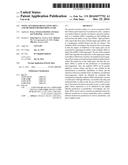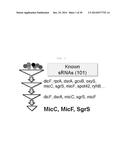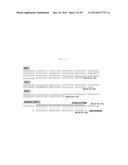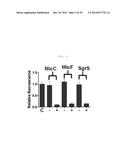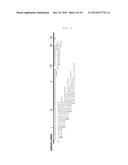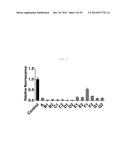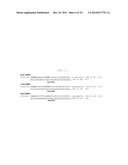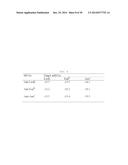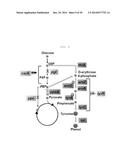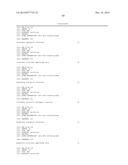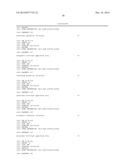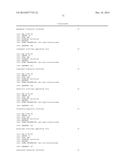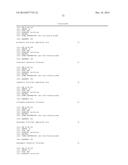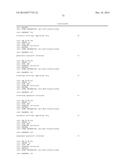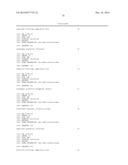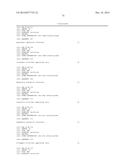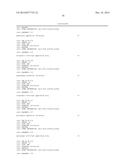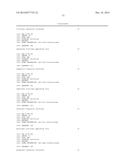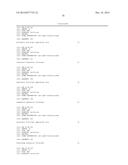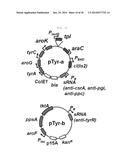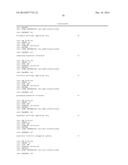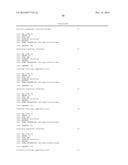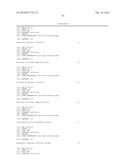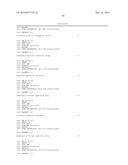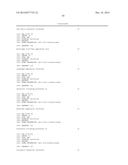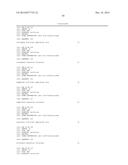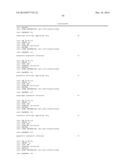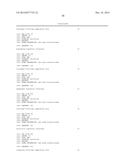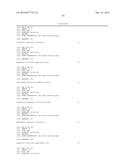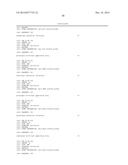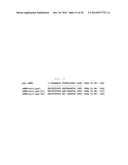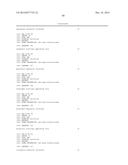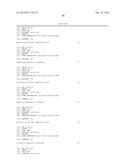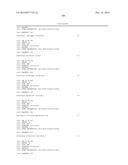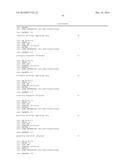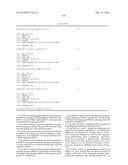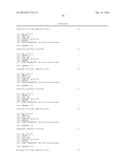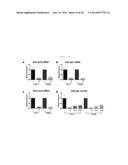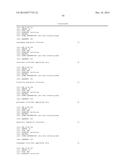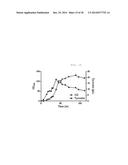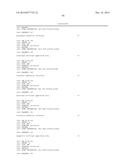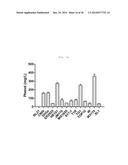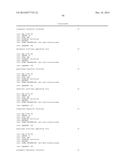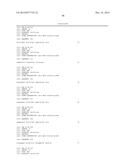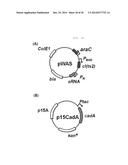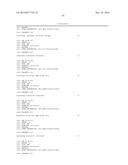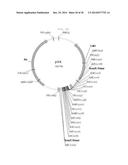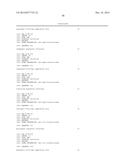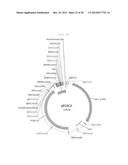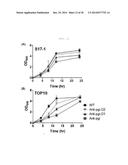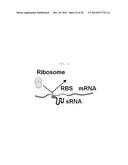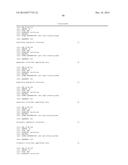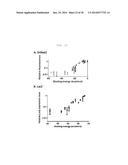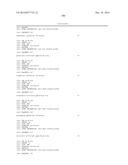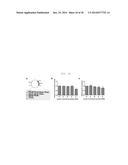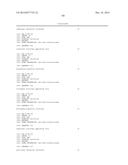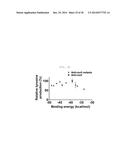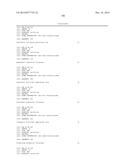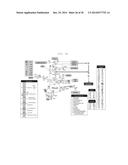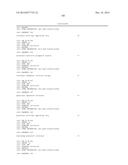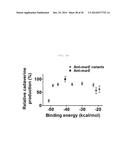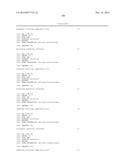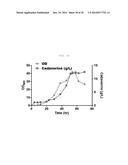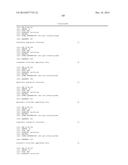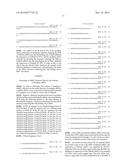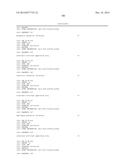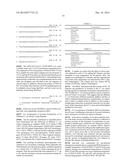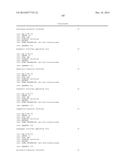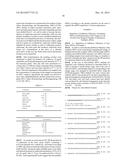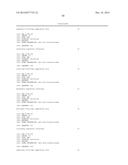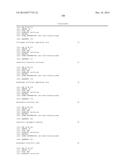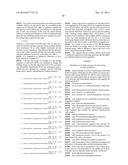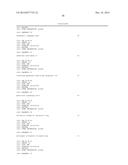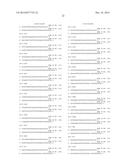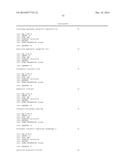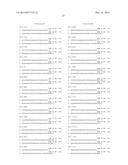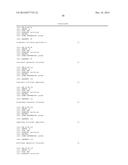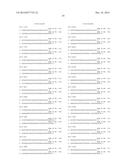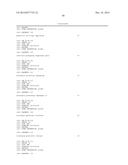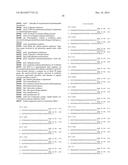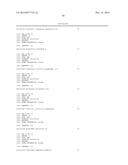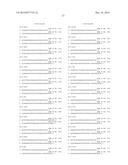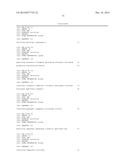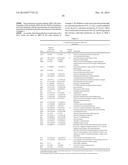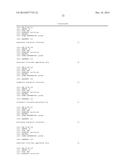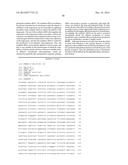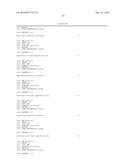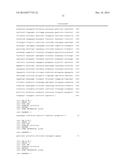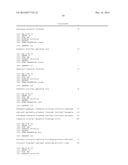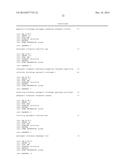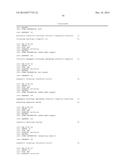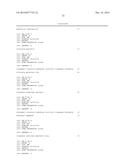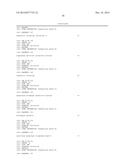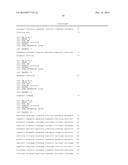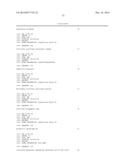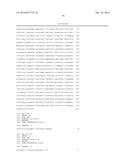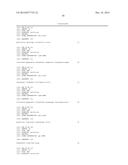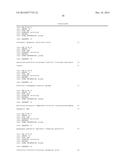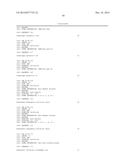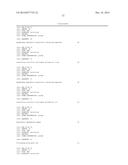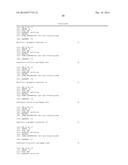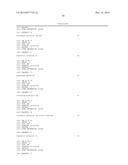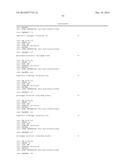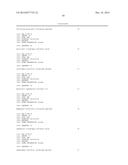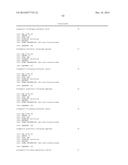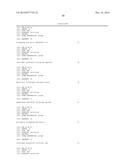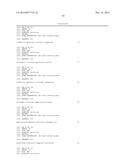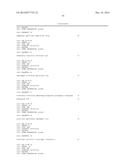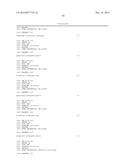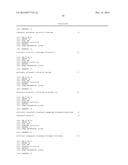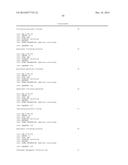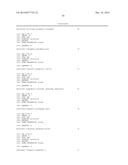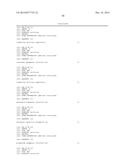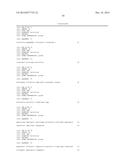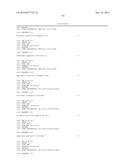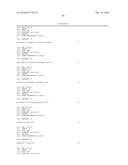Patent application title: NOVEL SYNTHESIS-REGULATING SRNA AND METHOD FOR PREPARING SAME
Inventors:
Sang-Yup Lee (Daejeon, KR)
Dokyun Na (Gyeongsangnam-Do, KR)
Seung Min Yoo (Daejeon, KR)
IPC8 Class: AC12N15113FI
USPC Class:
435 611
Class name: Measuring or testing process involving enzymes or micro-organisms; composition or test strip therefore; processes of forming such composition or test strip involving nucleic acid nucleic acid based assay involving a hybridization step with a nucleic acid probe, involving a single nucleotide polymorphism (snp), involving pharmacogenetics, involving genotyping, involving haplotyping, or involving detection of dna methylation gene expression
Publication date: 2014-12-25
Patent application number: 20140377752
Abstract:
The present invention relates to a novel customized sRNA that reduces
gene expression in prokaryotic cells, a preparation method thereof, and
the use thereof, and more particularly to a synthetic sRNA comprising an
Hfq binding site, derived from the sRNA of any one of MicC, SgrS and
MicF, and a region that base-pairs with the target gene mRNA, and to a
preparation method thereof and the use thereof. The synthetic sRNA
according to the invention has an advantage in that the degree of
inhibition of the target gene can be controlled by regulating the ability
of the synthetic sRNA to bind to the mRNA of the target gene. The use of
the synthetic sRNA that regulates the expression of the target gene makes
it possible to effectively construct a recombinant microorganism without
using a conventional gene deletion method and to reduce the expression of
the target gene, and thus the synthetic sRNA is useful for the production
of recombinant microorganisms. Also, the synthetic sRNA can be quickly
applied to various strains, and thus is very suitable for the measurement
of metabolic capabilities of strains and the selection of the most
suitable strain. In addition, recombinant microorganisms, which are
obtained by metabolic flux manipulation using the synthetic sRNA and
produce tyrosine or cadaverine with high efficiency, are useful in the
drug and industrial fields. In other words, the use of the sRNA according
to the present invention can make it easy to select target genes whose
expression is to be inhibited for the highly efficient production of
metabolites. Accordingly, the synthetic sRNA can be used to construct
recombinant strains for efficient production of various metabolites and
to establish efficient methods for production of various metabolites, and
thus is highly useful.Claims:
1. An sRNA for inhibiting gene expression in prokaryotes, the sRNA
comprising: an Hfq binding site derived from the sRNA of any one of MicC,
SgrS and MicF; and a region that base-pairs with the target gene mRNA.
2. The sRNA of claim 1, wherein the region that base-pairs with the target gene mRNA base-pairs with all or part of the ribosome binding site of the target gene mRNA.
3. The sRNA of claim 1, wherein a site that does not bind to the mRNA of the target gene is formed by deleting or substituting one or more nucleotides in the region that base-pairs with the target gene mRNA.
4. The sRNA of claim 1, wherein a site that does not bind to the mRNA of the target is formed by inserting or deleting one or more nucleotides in the region that base-pairs with the target gene mRNA.
5. The sRNA of claim 1, wherein the region that base-pairs with the target gene mRNA is constructed so that the energy of binding to the target gene mRNA is in the range from -10 kcal/mol to -40 kcal/mol.
6. The sRNA of claim 5 wherein the region that base-pairs with the target gene mRNA is constructed so that the energy of binding to the target gene mRNA is in the range from -20 kcal/mol to -40 kcal/mol.
7. The sRNA of claim 1, wherein the sRNA comprises an Hfq binding site derived from the sRNA of MicC.
8. The sRNA of claim 1, wherein the prokaryotes are selected from the group consisting of E. coli, Rhizobium, Bifidobacterium, Rhodococcus, Candida, Erwinia, Enterobacter, Pasteurella, Mannheimia, Actinobacillus, Aggregatibacter, Xanthomonas, Vibrio, Pseudomonas, Azotobacter, Acinetobacter, Ralstonia, Agrobacterium, Rhizobium, Rhodobacter, Zymomonas, Bacillus, Staphylococcus, Lactococcus, Streptococcus, Lactobacillus, Clostridium, Corynebacterium, Streptomyces, Bifidobacterium, and Cyclobacterium.
9. The sRNA of claim 1, wherein target gene mRNA is an mRNA of a gene selected from the group consisting of DsRed2, LuxR, AraC, KanR (kanamycin resistance gene), tyrR(tyrosine regulator), ppc (phosphoenolpyruvate carboxylase), csrA (carbon storage regulator), pgi (glucose-6-phosphate isomerase), glt (citrate synthase), accA (acetyl-CoA carboxyltransferase, alpha-subunit), accB (biotinylated biotin-carboxyl carrier protein), accC (acetyl-CoA carboxylase), accD (acetyl-CoA carboxyltransferase, beta-subunit), aceE (subunit of E1p component of pyruvate dehydrogenase complex), aceF (pyruvate dehydrogenase), ackA (propionate kinase/acetate kinase activity), adiY (AdiY is a positive DNA-binding transcriptional regulator that controls the arginine) decarboxylase (adi) system), argB (acetylglutamate kinase), argC (N-acetylglutamylphosphate reductase), argG (argininosuccinate synthase), argH (argininosuccinate lyase), asnC (transcriptional regulator that activates the expression of asnA, a gene involved in the synthesis of asparagine), aspA (aspartate ammonia-lyase), crp (CRP transcriptional dual regulator), csiD (predicted protein. CsiD is the product of a gene induced by carbon starvation), csiR (DNA-binding transcriptional repressor), cytR (transcription factor required for transport and utilization of ribonucleosides and deoxyribonucleosides), dcuA (The DcuA transporter is one of three transporters known to be responsible for the uptake of C4-dicarboxylates such as fumarate under anaerobic conditions), deoB (phosphopentomutase), deoC (deoxyribose-phosphate aldolase), deoR (The transcriptional repressor DeoR, for "Deoxyribose Regulator," is involved in the negative expression of genes related to transport and catabolism of deoxyribonucleoside nucleotides), fabH (KASIII, -ketoacyl-ACP synthases), fadD (fatty acyl-CoA synthetase), fadR (FadR Fatty acid degradation Regulon, is a multifunctional dual regulator that exerts negative control over the fatty acid degradative regulon [Simons80, Simons80a] and acetate metabolism), fbp (fructose-1,6-bisphosphatase), fnr (FNR is the primary transcriptional regulator that mediates the transition from aerobic to anaerobic growth), fruR (FruR is a dual transcriptional regulator that plays a pleiotropic role to modulate the direction of carbon flow through the different metabolic pathways of energy metabolism, but independently of the CRP regulator), ftsL (essential cell division protein FtsL), ftsQ (essential cell division protein FtsQ), ftsW (essential cell division protein FtsW), ftsZ (essential cell division protein FtsZ), fur (Fur-Fe+2 DNA-binding transcriptional dual regulator), gabD (succinate semialdehyde dehydrogenase, NADP+-dependent), gabP (APC transporter), gabT (4-aminobutyrate aminotransferase), gadA (glutamate decarboxylase A subunit), gadB (glutamate decarboxylase B subunit), gadC (GABA APC transporter), glcC (GntR family transcriptional regulator, glc operon transcriptional activator), glpK (glycerol kinase), glpR (sn-Glycerol-3-phosphate repressor), glpX (fructose 1,6-bisphosphatase II), gltA (citrate synthase), hfld (lysogenization regulator), ihfa (IHF, Integration host factor, is a global regulatory protein), ihfb (IHF, Integration host factor, is a global regulatory protein), ilvB (acetohydroxybutanoate synthase/acetolactate synthase), ilvC (acetohydroxy acid isomeroreductase), ilvD (dihydroxy acid dehydratase), ilvG--1 (acetolactate synthase II, large subunit, N-ter fragment (pseudogene)), ilvG--2 (acetolactate synthase II, large subunit, C-ter fragment (pseudogene)), ilvH (acetolactate synthase/acetohydroxybutanoate synthase), ilvL (ilvGEDA operon leader peptide), ilvM (acetohydroxybutanoate synthase/acetolactate synthase), ilvN (acetohydroxybutanoate synthase/acetolactate synthase), ilvX (Predicted small protein), lexA (LexA represses the transcription of several genes involved in the cellular response to DNA damage), 1pxC (UDP-3-O-acyl-N-acetylglucosamine deacetylase), marA (MarA participates in controlling several genes involved in resistance to antibiotics, oxidative stress, organic solvents and heavy metals.), metJ (MetJ transcriptional repressor), modE (ModE is the principal regulator that controls the transcription of operons involved in the transport of molybdenum and synthesis of molybdoenzymes and molybdate-related functions), nadB (L-aspartate oxidase), narL (nitrate/nitrite response regulator), pck (phosphoenolpyruvate carboxykinase), PdhR (PdhR, "pyruvate dehydrogenase complex regulator," regulates genes involved in the pyruvate dehydrogenase complex), phoP (PhoP-Phosphorylated DNA-binding transcriptional dual regulator. Member of the two-component regulatory system phoQ/phoP involved in adaptation to low Mg2+ environments and the control of acid resistance genes), pnuC (PnuC NMN transporter), ppsA (phosphoenolpyruvate synthetase), pta (Phosphate acetyltransferase), purA (adenylosuccinate synthetase), purB (adenylosuccinate lyase), purR (PurR-Hypoxanthine DNA-binding transcriptional repressor. PurR dimer controls several genes involved in purine nucleotide biosynthesis and its own synthesis), puuE (4-aminobutyrate aminotransferase), rbsA (ribose ABC transporter), rbsB (ribose ABC transporter), rbsD (ribose pyranase), rbsK (ribokinase), rbsR (The transcription factor RbsR, for "Ribose Repressor," is negatively autoregulated and controls the transcription of the operon involved in ribose catabolism and transport), rcsB (RcsB-Bg1J DNA-binding transcriptional activator. RcsB protein for "Regulator capsule synthesis B," is a response regulator that belongs to the multicomponent RcsF/RcsC/RcsD/RcsA-RcsB phosphorelay system and is involved in the regulation of the synthesis of colanic acid capsule, cell division, periplasmic proteins, motility, and a small RNA), rutR (RutR regulates genes directly or indirectly involved in the complex pathway of pyrimidine metabolism), serA (alpha-ketoglutarate reductase/D-3-phosphoglycerate dehydrogenase), serC (phosphohydroxythreonine aminotransferase/3-phosphoserine aminotransferase), soxS (dual transcriptional activator and participates in the removal of superoxide and nitric oxide), sroD (SroD small RNA), zwf (glucose 6-phosphate-1-dehydrogenase), asnA (asparagine synthetase A), asnB (asparagine synthetase B), carA (carbamoyl phosphate synthetase), carB (carbamoyl phosphate synthetase), ddlB (D-alanine-D-alanine ligase B), deoA (thymidine phosphorylase/uracil phosphorylase), deoD (purine nucleoside phosphorylase deoD-type), dpiA (dual transcriptional regulator involved in anaerobic citrate catabolism), fis (Fis, "factor for inversion stimulation", is a small DNA-binding and bending protein whose main role appears to be the organization and maintenance of nucleoid structure), gadE (GadE controls the transcription of genes involved in glutamate dependent system), gadW (GadW controls the transcription of genes involved in glutamate dependent system), gadX (GadX controls the transcription of genes involved in glutamate dependent system), glpF (G1 pF glycerol MIP channel), ilvY (IlvY DNA-binding transcriptional dual regulator), ivbL (The ilvB operon leader peptide (IvbL)), lhgO (L-2-hydroxyglutarate oxidase), 1pd (Lipoamide dehydrogenase), lrp (Lrp is a dual transcriptional regulator for at least 10% of the genes in Escherichia coli. These genes are involved in amino acid biosynthesis and catabolism, nutrient) transport, pili synthesis, and other cellular functions, including 1-carbon metabolism), metB (O-succinylhomoserine lyase/O-succinylhomoserine(thiol)-lyase), metL (aspartate kinase/homoserine dehydrogenase), mraY (phospho-N-acetylmuramoyl-pentapeptide transferase), mraZ (Unknown function), murE (UDP-N-acetylmuramoylalanyl-D-glutamate 2,6-diaminopimelate ligase), murF (D-alanyl-D-alanine-adding enzyme), murG (N-acetylglucosaminyl transferase), nac (Nacregulates, without a coeffector, genes involved in nitrogen metabolism under nitrogen-limiting conditions), nadA (quinolinate synthase), nsrR (NsrR, the "nitrite-sensitive repressor" regulates genes involved in cell protection against nitric oxide (NO)), panC (pantothenate synthetase), panD (Aspartate 1-decarboxylase), pgl (6-phosphogluconolactonase), pyrB (aspartate carbamoyltransferase, PyrB subunit), pyrC (dihydroorotase), pyrL (aspartate carbamoyltransferase, PyrI subunit), rob (Rob is a transcriptional dual regulator. Its N-terminal domain shares 49% identity with MarA and SoxS. These proteins activate a common set of about 50 target genes, the marA/soxS/rob regulon, involved in antibiotic resistance, superoxide resistance, and tolerance to organic solvents and heavy metals.), rpe (ribulose phosphate 3-epimerase), talA (transaldolase A), thrA (aspartate kinase/homoserine dehydrogenase), thrB (homoserine kinase), thrC (threonine synthase), thrL (thr operon leader peptide), tktA (transketolase I), tktB (transketolase II), and torR (two-component system, OmpR family, torCAD operon response regulator TorR).
10. An isolated nucleic acid encoding the sRNA of claim 1.
11. An expression vector comprising an isolated nucleic acid encoding the sRNA of claim 1.
12. A recombinant microorganism having the sRNA of claim 1 introduced therein.
13. A recombinant microorganism transformed with the expression vector of claim 11.
14. A method for preparing an sRNA, the method comprising linking a nucleic acid, which encodes a region that base-pairs with the target gene mRNA, to a nucleic acid that encodes an Hfq binding site derived from the sRNA of any one of MicC, SgrS and MicF.
15. The method of claim 14, wherein the method comprises removing mRNA-binding sequence of the sRNA of any one of MicC, SgrS and MicF, and introducing the nucleic acid which encodes a region that base-pairs with the target gene mRNA.
16. The method of claim 14, wherein the region that base-pairs with the target gene mRNA base-pairs with all or part of the ribosome binding site of the target gene mRNA.
17. The method of claim 14, wherein a site that does not bind to the mRNA of the target gene is formed by deleting or substituting one or more nucleotides in a nucleic acid encoding the region that base-pairs with the target gene mRNA.
18. The method of claim 14, wherein a site that does not bind to the mRNA of the target is formed by inserting one or more nucleotides into a nucleic acid encoding the region that base-pairs with the target gene mRNA.
19. The method of claim 14, wherein the region that base-pairs with the target gene mRNA is constructed so that the energy of binding to the target gene mRNA is in the range from -10 kcal/mol to -40 kcal/mol.
20. The method of claim 19, wherein the region that base-pairs with the target gene mRNA is constructed so that the energy of binding to the target gene mRNA is in the range from -20 kcal/mol to -40 kcal/mol.
21. A method for inhibiting the expression of a target gene, the method comprising the steps of: introducing or expressing the sRNA of claim 1 in a prokaryote; and inhibiting the expression of the mRNA of the target gene.
22. The method of claim 21, wherein the expression of the sRNA is induced by a promoter that operates according to binding of an inducer.
23. The method of claim 21, wherein the expression of the sRNA is inhibited by a temperature-sensitive transcription factor.
24. A composition for inhibiting gene expression in prokaryotes, the composition comprising the sRNA of claim 1.
25. A method for screening a gene that needs to be deleted to produce a useful substance, the method comprising the steps of: (a) inhibiting the expression of at least one gene among genes, which are present in a strain for producing the useful substance and participate in the pathway of biosynthesis of the useful substance, by using the sRNA that targets the gene; and (b) selecting the gene whose expression was inhibited, as the gene that needs to be deleted to produce the useful substance, in case where the production yield of the useful substance is increased by inhibition of the expression of the gene.
26. A method for improving a strain for producing a useful substance, the method comprising the steps of: (a) inhibiting the expression of at least one gene among genes, which are present in a strain for producing the useful substance and participate in the pathway of biosynthesis of the useful substance, using the sRNA that targets the gene; (b) selecting the gene whose expression was inhibited, as the gene that needs to be deleted to produce the useful substance, if the production yield of the useful substance is increased by inhibition of the expression of the gene; and (c) constructing a recombinant strain having a deletion of the selected gene or a combination of the selected genes.
27. A recombinant microorganism having an enhanced ability to produce tyrosine, the recombinant microorganism being obtained by inactivating the functions of tyrR and csrA genes in a host cell having the tyrosine biosynthesis pathway.
28. The recombinant microorganism of claim 27, wherein the functions of tyrR and csrA genes are inactivated by introducing or expressing a synthetic sRNA comprising an Hfq binding site derived from the sRNA of any one of MicC, SgrS and MicF and a region that base-pairs with the mRNA of tyrR or csrA genes in a host cell having the tyrosine biosynthesis pathway to inhibit expression of the tyrR and csrA genes.
29. The recombinant microorganism of claim 27, wherein the microorganism has one or more genes selected from the group consisting of ppsA (phenolpthiocerol synthesis type-I polyketide synthase A), tktA (transketolase), aroG/aroF (3-deoxy-7-phosphoheptulonate synthase), aroK (shikimate kinase I), and tyrC (prephenate dehydrogenase) that are introduced or amplified therein.
30. The recombinant microorganism of claim 27, wherein the ppsA or tktA is expressed by a strong promoter, and aroG/aroF, aroK or tyrC is expressed by a weak promoter.
31. The recombinant microorganism of claim 27, wherein the host cell is selected from the group consisting of E. coli, Rhizobium, Bifidobacterium, Rhodococcus, Candida, Erwinia, Enterobacter, Pasteurella, Mannheimia, Actinobacillus, Aggregatibacter, Xanthomonas, Vibrio, Pseudomonas, Azotobacter, Acinetobacter, Ralstonia, Agrobacterium, Rhizobium, Rhodobacter, Zymomonas, Bacillus, Staphylococcus, Lactococcus, Streptococcus, Lactobacillus, Clostridium, Corynebacterium, Streptomyces, Bifidobacterium, and Cyclobacterium.
32. The recombinant microorganism of claim 31, wherein the E. coli is S17-1 (ATCC 47055).
33. A recombinant microorganism having an ability to produce phenol, the recombinant microorganism being obtained by introducing or amplifying a tpl gene in the recombinant microorganism of claim 27.
34. The recombinant microorganism of claim 33, wherein the E. coli is W3110 (ATCC 39936).
35. A method for producing a recombinant microorganism having an enhanced ability to produce tyrosine, the method comprising inactivating the functions of tyrR and csrA genes in a host cell having the tyrosine biosynthesis pathway.
36. The method of claim 35, wherein the functions of tyrR and csrA genes are inactivated by introducing or expressing a synthetic sRNA comprising an Hfq binding site derived from the sRNA of any one of MicC, SgrS and MicF and a region that base-pairs with the mRNA of tyrR or csrA genes in a host cell having the tyrosine biosynthesis pathway to inhibit expression of the tyrR and csrA genes.
37. A recombinant microorganism having an enhanced ability to produce cadaverine, the recombinant microorganism being obtained by inactivating the function of at least one gene, selected from the group consisting of murE (UDP-N-acetylmuramoylalanyl-D-glutamate-2,6-diaminopimelate ligase), metB (cystathionine gamma-synthase), thrL (thr operon leader peptide), ackA (propionate kinase/acetate kinase activity), pdhR (pyruvate dehydrogenase complex regulator), ilvG--1 (acetolactate synthase II, large subunit, N-ter fragment (pseudogene)), carB (carbamoyl phosphate synthetase), serC (phosphohydroxythreonine aminotransferase/3-phosphoserine aminotransferase), ilvN (acetohydroxybutanoate synthase/acetolactate synthase), Crp (CRP transcriptional dual regulator), ilvD (dihydroxy acid dehydratase), ilvY (IlvY DNA-binding transcriptional dual regulator), glpK (glycerol kinase), glpF (glycerol MIP channel), pta (Phosphate acetyltransferase), tktA (transketolase I), hflD (lysogenization regulator), deoA (thymidine phosphorylase/uracil phosphorylase), gadE (GadE controls the transcription of genes involved in glutamate dependent system), rbsK (ribokinase), ilvL (ilvGEDA operon leader peptide), ilvC (acetohydroxy acid isomeroreductase), accA (acetyl-CoA carboxyltransferase, alpha-subunit), ilvM (acetohydroxybutanoate synthase/acetolactate synthase), argB (acetylglutamate kinase), thrA (aspartate kinase/homoserine dehydrogenase), carA (carbamoyl phosphate synthetase), fbp (fructose-1,6-bisphosphatase), rbsD (ribose pyranase), panD (Aspartate 1-decarboxylase), aspA (aspartate ammonia-lyase), rcsB (RcsB-Bg1J DNA-binding transcriptional activator), ivbL (The ilvB operon leader peptide), lexA (LexA represses the transcription of several genes involved in the cellular response to DNA damage), rbsA (ribose ABC transporter), murF (D-alanyl-D-alanine-adding enzyme), and thrC (threonine synthase), in a host cell having the cadaverine biosynthesis pathway.
38. The recombinant microorganism of claim 37, wherein the recombinant microorganism is obtained by inactivating the function of at least one gene selected from the group consisting of murE, metB, thrL, and ackA.
39. The recombinant microorganism of claim 38, wherein the functions of at least one gene selected from the group consisting of murE, metB, thrL, and ackA are inactivated by introducing or expressing a synthetic sRNA comprising an Hfq binding site derived from the sRNA of any one of MicC, SgrS and MicF and a region that base-pairs with the mRNA of at least one gene selected from the group consisting of murE, metB, thrL, and ackA in a host cell having the cadaverine biosynthesis pathway to inhibit expression of at least one gene selected from the group consisting of murE, metB, thrL, and ackA.
40. The recombinant microorganism of claim 37, wherein the host cell is selected from the group consisting of E. coli, Rhizobium, Bifidobacterium, Rhodococcus, Candida, Erwinia, Enterobacter, Pasteurella, Mannheimia, Actinobacillus, Aggregatibacter, Xanthomonas, Vibrio, Pseudomonas, Azotobacter, Acinetobacter, Ralstonia, Agrobacterium, Rhizobium, Rhodobacter, Zymomonas, Bacillus, Staphylococcus, Lactococcus, Streptococcus, Lactobacillus, Clostridium, Corynebacterium, Streptomyces, Bifidobacterium, and Cyclobacterium.
41. A method for producing a recombinant microorganism having an enhanced ability to produce cadaverine, the method comprising inactivating the function of at least one gene, selected from the group consisting of murE (UDP-N-acetylmuramoylalanyl-D-glutamate-2,6-diaminopimelate ligase), metB (cystathionine gamma-synthase), thrL (thr operon leader peptide), ackA (propionate kinase/acetate kinase activity), pdhR (pyruvate dehydrogenase complex regulator), ilvG--1 (acetolactate synthase II, large subunit, N-ter fragment (pseudogene)), carB (carbamoyl phosphate synthetase), serC (phosphohydroxythreonine aminotransferase/3-phosphoserine aminotransferase), ilvN (acetohydroxybutanoate synthase/acetolactate synthase), Crp (CRP transcriptional dual regulator), ilvD (dihydroxy acid dehydratase), ilvY (IlvY DNA-binding transcriptional dual regulator), glpK (glycerol kinase), glpF (glycerol MIP channel), pta (Phosphate acetyltransferase), tktA (transketolase I), hflD (lysogenization regulator), deoA (thymidine phosphorylase/uracil phosphorylase), gadE (GadE controls the transcription of genes involved in glutamate dependent system), rbsK (ribokinase), ilvL (ilvGEDA operon leader peptide), ilvC (acetohydroxy acid isomeroreductase), accA (acetyl-CoA carboxyltransferase, alpha-subunit), ilvM (acetohydroxybutanoate synthase/acetolactate synthase), argB (acetylglutamate kinase), thrA (aspartate kinase/homoserine dehydrogenase), carA (carbamoyl phosphate synthetase), fbp (fructose-1,6-bisphosphatase), rbsD (ribose pyranase), panD (Aspartate 1-decarboxylase), aspA (aspartate ammonia-lyase), rcsB (RcsB-Bg1J DNA-binding transcriptional activator), ivbL (The ilvB operon leader peptide), lexA (LexA represses the transcription of several genes involved in the cellular response to DNA damage), rbsA (ribose ABC transporter), murF (D-alanyl-D-alanine-adding enzyme), and thrC (threonine synthase), in a host cell having the cadaverine biosynthesis pathway
42. The method of claim 41, wherein the recombinant microorganism is obtained by inactivating the function of at least one gene selected from the group consisting of murE, metB, thrL, and ackA.
43. The method of claim 42, wherein the functions of at least one gene selected from the group consisting of murE, metB, thrL, and ackA are inactivated by introducing or expressing a synthetic sRNA comprising an Hfq binding site derived from the sRNA of any one of MicC, SgrS and MicF and a region that base-pairs with the mRNA of at least one gene selected from the group consisting of murE, metB, thrL, and ackA in a host cell having the cadaverine biosynthesis pathway to inhibit expression of at least one gene selected from the group consisting of murE, metB, thrL, and ackA.
Description:
TECHNICAL FIELD
[0001] The present invention relates to a novel customized sRNA that reduces gene expression in prokaryotic cells, a preparation method thereof, and the use thereof, and more particularly to a synthetic sRNA comprising an Hfq binding site, derived from the sRNA of any one of MicC, SgrS and MicF, and a region that base-pairs with the target gene mRNA, and to a preparation method thereof and the use thereof.
BACKGROUND ART
[0002] In recent years, worldwide concerns about environmental issues and the depletion of limited resources have increased rapidly. As an alternative to solve such problems, the construction of production systems based on environmentally friendly and renewable organisms has been of increasing interest. Such systems can be constructed by regulating metabolic pathways in organisms to optimize metabolic fluxes for desired metabolites, and various molecular biological techniques are required in this process for regulating metabolic pathways.
[0003] Methods for regulating metabolic pathways include a method of increasing the expression of enzymes required for biosynthetic processes to enhance metabolic fluxes, and a method of preventing metabolic fluxes that are used for cell growth and the production of other metabolites and deleting genes in order to produce desired metabolites. A gene deletion method that is currently widely used is a method in which the gene to be deleted is replaced by any sequence homologous thereto using recombinase so that the function of the gene is lost (Datsenko et al, PNAS, 97(12): 6640-6645, 2000). However, this gene deletion method has the following problems.
[0004] First, the time required that is for gene deletion is relatively long. Considering the time required that is replace the chromosomal gene with the homologous sequence and the time that is required to remove an antibiotic resistance gene, used to select cells from which gene deletion was normally removed, from the chromosome, a time of one week or longer is require to remove one gene. This long gene deletion time interferes with the development of metabolic engineering focused on efficiently producing metabolites by metabolic pathway regulation, compared to molecular biology technology that has developed rapidly in recent years.
[0005] Second, gene deletion causes complete loss of function of the gene. This suggests that the expression level of the gene cannot be regulated to a desired level. In order to efficiently produce a desired metabolite in an intracellular metabolic pathway, gene deletion is attempted to block a metabolic flux that goes to the metabolic pathway. However, if the blocked metabolic flux produces a substance essential for cell growth, the growth of the cells from which the gene was deleted will be significantly inhibited or will not occur. In order to maximize the efficiency of production of a desired metabolite, cells that produce the desired metabolite should be easily grown while a metabolic flux to the desired metabolite should also be optimized. Thus, there is a need for a method capable of producing a desired substance while maintaining cell growth by regulating the level of gene expression, rather than simply deleting the gene for the purpose of regulating the metabolic flux.
[0006] Third, the gene deleted from the chromosome by a conventional gene deletion method is difficult to restore. In addition, if the deletion of the same gene is attempted in other strains, all the processes should be attempted again, and thus large amounts of time and effort are required.
[0007] Thus, in order to overcome the limitations of the conventional gene deletion method, it should be possible to reduce the expression level of the gene of interest without modifying the chromosomal sequence of the strain. Also, it should be possible to regulate the expression level of the gene and to easily apply the regulation of expression of the same gene to other strains. Further, it is required to construct and apply the gene regulatory system in a fast and convenient manner.
[0008] Accordingly, the present inventors attempted to construct a short-length customized synthetic sRNA using a method satisfying the above-described requirements.
[0009] A total of 101 E. coli sRNAs are currently known (Pichon et al., Nucleic Acids Research, DOI:10.1093/nar/gkr1141, 2011), and the mechanisms thereof are currently being studied. It has been reported to date that a large number of sRNAs form a specific secondary structure, even though they have different sequences, and that the Hfq protein recognizes and binds to the sRNAs. The functions of Hfq are to increase the half life of sRNA so that the sRNA effectively functions even in a small amount, and to assist the binding of the sRNA to the target mRNA so that the target mRNA functions quickly, and to bind RNase to the target mRNA to promote the degradation of the target mRNA to thereby more effectively reduce the expression of the gene.
[0010] The fundamental functions of E. coli sRNA have been continuously studied, but there are little or no reports on the use of the above-described mechanisms to construct synthetic sRNAs. According to recent reports on the construction of E. coli sRNAs, effective sRNAs have been constructed by random mutagenesis and screening (Sharma et al, ACS Synthetic Biology, DOI: 10.1021/sb200001q, 2011).
[0011] Accordingly, the present inventors have made extensive efforts to construct a novel, short-length customized synthetic sRNA in order to overcome the limitations of the conventional gene deletion method, and as a result, have construct a synthetic sRNA comprising an Hfq binding site, derived from MicC, SgrS and/or MicF, and a region homologous to the target mRNA such as DsRed2 mRNA, AraC mRNA, KanR mRNA or LuxR mRNA, and have found that test results for the expression of the target mRNA indicate that an efficient sRNA can be constructed without relying on conventional random methods. In addition, the present inventors have constructed synthetic sRNAs that inhibit the expression of tyrR (tyrosine regulator), csrA (carbon storage regulator), pgi (glucose-6-phosphate isomerase), ppc (phosphoenolpyruvate carboxylase) and the like, and have found that these synthetic sRNAs show effects similar to those of actual gene deletion and can be used to regulate the production of a desired metabolite, thereby completing the present invention.
[0012] The information disclosed in the Background Art section is only for the enhancement of understanding of the background of the present invention, and therefore may not contain information that forms a prior art that would already be known to a person of ordinary skill in the art.
DISCLOSURE OF INVENTION
Technical Problem
[0013] It is an object of the present invention to provide a novel, short-length customized synthetic sRNA, which overcomes the limitations of the conventional gene deletion method and can be used to regulate the mRNA expression of various target genes with high efficiency, a preparation method thereof and the use thereof.
Technical Solution
[0014] To achieve the above object, the present invention provides an sRNA (small regulatory RNA) for inhibiting gene expression in prokaryotes, the sRNA comprising: an Hfq binding site derived from the sRNA of any one of MicC, SgrS and MicF; and a region that base-pairs with the target gene mRNA.
[0015] The present invention also provides an isolated nucleic acid encoding the sRNA.
[0016] The present invention also provides an expression vector comprising the isolated nucleic acid encoding the sRNA.
[0017] The present invention also provides a recombinant microorganism having the sRNA introduced therein.
[0018] The present invention also provides a recombinant microorganism transformed with the expression vector.
[0019] The present invention also provides a method for preparing an sRNA, the method comprising linking a nucleic acid, which encodes a region that base-pairs with the target gene mRNA, to a nucleic acid that encodes an Hfq binding site derived from the sRNA of any one of MicC, SgrS and MicF.
[0020] The present invention also provides a method for inhibiting the expression of a target gene, the method comprising the steps of: introducing or expressing the sRNA in a prokaryote; and inhibiting the expression of the mRNA of the target gene.
[0021] The present invention also provides a composition for inhibiting gene expression in prokaryotes, the composition comprising the sRNA.
[0022] The present invention also provides a method for screening a gene that needs to be deleted to produce a useful substance, the method comprising the steps of:
[0023] (a) inhibiting the expression of at least one gene among genes, which are present in a strain for producing the useful substance and participate in the pathway of biosynthesis of the useful substance, using the sRNA that targets the gene; and
[0024] (b) selecting the gene whose expression was inhibited, as the gene that needs to be deleted to produce the useful substance, if the production yield of the useful substance is increased by inhibition of the expression of the gene.
[0025] The present invention also provides a method for improving a strain for producing a useful substance, the method comprising the steps of:
[0026] (a) inhibiting the expression of at least one gene among genes, which are present in a strain for producing the useful substance and participate in the pathway of biosynthesis of the useful substance, using the sRNA that targets the gene;
[0027] (b) selecting the gene whose expression was inhibited, as the gene that needs to be deleted to produce the useful substance, if the production yield of the useful substance is increased by inhibition of the expression of the gene; and
[0028] (c) constructing a recombinant strain having a deletion of the selected gene or a combination of the selected genes.
[0029] The present invention also provides a recombinant microorganism having an enhanced ability to produce tyrosine, the recombinant microorganism being obtained by inactivating the functions of tyrR and csrA genes in a host cell having the tyrosine biosynthesis pathway.
[0030] The present invention also provides a recombinant microorganism having an ability to produce phenol, the recombinant microorganism being obtained by introducing or amplifying a tpl gene in the above-described recombinant microorganism.
[0031] The present invention also provides a method for producing a recombinant microorganism having an enhanced ability to produce tyrosine, the method comprising inactivating the functions of tyrR and csrA genes in a host cell having the tyrosine biosynthesis pathway.
[0032] The present invention also provides a recombinant microorganism having an enhanced ability to produce cadaverine, the recombinant microorganism being obtained by inactivating the function of at least one gene, selected from the group consisting of murE (UDP-N-acetylmuramoylalanyl-D-glutamate-2,6-diaminopimelate ligase), metB (cystathionine gamma-synthase), thrL (thr operon leader peptide), ackA (propionate kinase/acetate kinase activity), pdhR (pyruvate dehydrogenase complex regulator), ilvG--1 (acetolactate synthase II, large subunit, N-ter fragment (pseudogene)), carB (carbamoyl phosphate synthetase), serC (phosphohydroxythreonine aminotransferase/3-phosphoserine aminotransferase), ilvN (acetohydroxybutanoate synthase/acetolactate synthase), Crp (CRP transcriptional dual regulator), ilvD (dihydroxy acid dehydratase), ilvY (IlvY DNA-binding transcriptional dual regulator), glpK (glycerol kinase), glpF (glycerol MIP channel), pta (Phosphate acetyltransferase), tktA (transketolase I), hflD (lysogenization regulator), deoA (thymidine phosphorylase/uracil phosphorylase), gadE (GadE controls the transcription of genes involved in glutamate dependent system), rbsK (ribokinase), ilvL (ilvGEDA operon leader peptide), ilvC (acetohydroxy acid isomeroreductase), accA (acetyl-CoA carboxyltransferase, alpha-subunit), ilvM (acetohydroxybutanoate synthase/acetolactate synthase), argB (acetylglutamate kinase), thrA (aspartate kinase/homoserine dehydrogenase), carA (carbamoyl phosphate synthetase), fbp (fructose-1,6-bisphosphatase), rbsD (ribose pyranase), panD (Aspartate 1-decarboxylase), aspA (aspartate ammonia-lyase), rcsB (RcsB-Bg1J DNA-binding transcriptional activator), ivbL (The ilvB operon leader peptide), lexA (LexA represses the transcription of several genes involved in the cellular response to DNA damage), rbsA (ribose ABC transporter), murF (D-alanyl-D-alanine-adding enzyme), and thrC (threonine synthase), in a host cell having the cadaverine biosynthesis pathway.
[0033] The present invention also provides a method for producing a recombinant microorganism having an enhanced ability to produce cadaverine, the method comprising inactivating the function of at least one gene, selected from the group consisting of murE (UDP-N-acetylmuramoylalanyl-D-glutamate-2,6-diaminopimelate ligase), metB (cystathionine gamma-synthase), thrL (thr operon leader peptide), ackA (propionate kinase/acetate kinase activity), pdhR (pyruvate dehydrogenase complex regulator), ilvG--1 (acetolactate synthase II, large subunit, N-ter fragment (pseudogene)), carB (carbamoyl phosphate synthetase), serC (phosphohydroxythreonine aminotransferase/3-phosphoserine aminotransferase), ilvN (acetohydroxybutanoate synthase/acetolactate synthase), Crp (CRP transcriptional dual regulator), ilvD (dihydroxy acid dehydratase), ilvY (IlvY DNA-binding transcriptional dual regulator), glpK (glycerol kinase), glpF (glycerol MIP channel), pta (Phosphate acetyltransferase), tktA (transketolase I), hflD (lysogenization regulator), deoA (thymidine phosphorylase/uracil phosphorylase), gadE (GadE controls the transcription of genes involved in glutamate dependent system), rbsK (ribokinase), ilvL (ilvGEDA operon leader peptide), ilvC (acetohydroxy acid isomeroreductase), accA (acetyl-CoA carboxyltransferase, alpha-subunit), ilvM (acetohydroxybutanoate synthase/acetolactate synthase), argB (acetylglutamate kinase), thrA (aspartate kinase/homoserine dehydrogenase), carA (carbamoyl phosphate synthetase), fbp (fructose-1,6-bisphosphatase), rbsD (ribose pyranase), panD (Aspartate 1-decarboxylase), aspA (aspartate ammonia-lyase), rcsB (RcsB-Bg1J DNA-binding transcriptional activator), ivbL (The ilvB operon leader peptide), lexA (LexA represses the transcription of several genes involved in the cellular response to DNA damage), rbsA (ribose ABC transporter), murF (D-alanyl-D-alanine-adding enzyme), and thrC (threonine synthase), in a host cell having the cadaverine biosynthesis pathway.
[0034] Other features and embodiments of the present invention will be more apparent from the following detailed descriptions and the appended claims.
BRIEF DESCRIPTION OF THE DRAWINGS
[0035] FIG. 1 shows a process for selecting basic structures for the effective function of synthetic sRNAs.
[0036] FIG. 2 shows the sequences of SgrS, MicF and MicF, the sequence of the reporter DsRed2 mRNA, and a complementary sequence binding to the RBS thereof.
[0037] FIG. 3 is a graphic diagram showing the inhibition of expression of DsRed2 after complementary binding between MicC, MicF or SgrS and DsRed2 RBS.
[0038] FIG. 4 shows various complementary sequences binding to DsRed2.
[0039] FIG. 5 is a graphic diagram showing the degree of inhibition of DsRed2 after binding of the Hfq binding site of MicC to various complementary sequences binding to DsRed2.
[0040] FIG. 6 shows the AraC, LuxR and KanR mRNA sequences and the sequences complementary to RBS that is attached to synthetic sRNAs so as to bind thereto.
[0041] FIG. 7 is a graphic diagram showing the cross-reactivity between AraC, LuxR or KanR and a synthetic sRNA that inhibits AraC, LuxR or KanR.
[0042] FIG. 8 shows the results of calculating the energy of binding between AraC, LuxR or KanR and a synthetic sRNA, constructed so as to bind to AraC, LuxR or KanR, using the mfold software.
[0043] FIG. 9 shows the tyrosine biosynthesis pathway in a microorganism. In FIG. 9, the green box indicates the gene to be overexpressed, the red box indicates the gene to be silenced by a synthetic sRNA, and Θ indicates the removal of feedback inhibition.
[0044] FIG. 10 is a schematic view of a plasmid constructed for tyrosine production.
[0045] FIG. 11 is a graphic diagram showing the results obtained by amplifying the expression of tyrosine biosynthesis pathway-related genes for tyrosine production, inhibiting the expression of tyrR, ppc, csrA and pgi with synthetic sRNAs, and then comparing the production of tyrosine in various E. coli strains (pgi also includes an additional synthetic sRNA (anti-pgi-D1, -D2) whose expression was regulated).
[0046] FIG. 12 shows growth curves of S17-1 and TOP10 strains according to anti-pgi, anti-pgi-D1 and anti-pgi-D2 synthetic sRNAs.
[0047] FIG. 13 shows anti-pgi, anti-pgi-D1 and anti-pgi-D2 binding sequences.
[0048] FIG. 14 is a graphic diagram showing the inhibition of expression of a target gene in S17-1 and TOP10 by anti-tyrR, anti-csrA, anti-ppc, anti-pgi, anti-pgi-D1 and anti-pgi-D2.
[0049] FIG. 15 is a graphic diagram showing the results of fermentation of S17-1 (pTyr-a(anti-csrA), pTyr-b(anti-tyrR)) recombinant microorganisms.
[0050] FIG. 16 is a graphic diagram showing the concentrations of phenol produced in various E. coli strains.
[0051] FIG. 17 shows the cadaverine biosynthesis pathway in E. coli. The red box indicates the target genes to be silenced by synthetic sRNA.
[0052] FIG. 18 is a schematic view showing a plasmid to be transformed to increase the production of cadaverine.
[0053] FIG. 19 is a graphic diagram showing the changes in the production of cadaverine after introduction of synthetic sRNAs (Control contains a p15CadA plasmid in an XQ56 strain and contains no synthetic sRNA. The concentration of cadaverine in the control is 1.3 g/L).
[0054] FIG. 20 is a schematic view of a pWA vector.
[0055] FIG. 21 is a schematic view of a pR15CA vector.
[0056] FIG. 22 shows the principle of operation of a synthetic sRNA.
[0057] FIG. 23 shows the experimental results obtained by preparing synthetic sRNAs, which inhibit the expression of DsRed2 and LacZ genes with various binding energies, and examining whether the use of the synthetic sRNAs regulates the expression of the genes to various levels.
[0058] FIG. 24 shows the results of an experiment performed to examine whether the introduction of synthetic sRNAs inhibits protein expression and cell growth in microorganisms.
[0059] FIG. 25 shows the results of examining the production of tyrosine using Anti-csrA with various binding energies.
[0060] FIG. 26 shows the results of measuring the production of tyrosine after introducing synthetic sRNAs that inhibit genes involved in the key metabolic pathways of cells.
[0061] FIG. 27 shows the cadaverine biosynthesis pathway in E. coli and the concentration of cadaverine produced upon inhibition by synthetic sRNAs.
[0062] FIG. 28 shows the results of measuring the effects of Anti-murE synthetic sRNAs having various binding energies on the production of cadaverine.
[0063] FIG. 29 shows the results of an experiment performed to examine whether various anti-murE synthetic sRNAs influence the actual production of MurE protein.
[0064] FIG. 30 shows the results of fermentation of a final strain containing Anti-murE.
BEST MODE FOR CARRYING OUT THE INVENTION
[0065] Unless otherwise defined, all technical and scientific terms used herein have the same meaning as commonly understood by one of ordinary skill in the art to which the invention pertains. Generally, the nomenclature used herein are well known and commonly used in the art.
[0066] The definition of main terms used in the detailed description of the invention is as follows.
[0067] As used herein, the term "sRNA (small RNA)" refers to a short-length RNA, which is usually 200 or less nucleotides in length, is not translated into protein and effectively inhibits the translation of a specific mRNA by complementary binding.
[0068] As used herein, the term "ribosome binding site (RBS)" refers to a site where ribosome binds to mRNA for the transcription of the mRNA.
[0069] As used herein, the term "gene" is intended to have the broadest meaning, and the gene can encode a structural protein or a regulatory protein. Herein, the regulatory protein includes a transcriptional factor, a heat shock protein, or a protein that is involved in DNA/RNA replication, transcription and/or translation. Also, the target gene whose expression is to be inhibited may be present as an extrachromosomal element.
[0070] In one aspect, the present invention is directed to a novel, short-length synthesis regulatory sRNA. That is, the present invention is directed to an sRNA (small regulatory RNA) for inhibiting gene expression in prokaryotes, the sRNA comprising: an Hfq binding site derived from the sRNA of any one of MicC, SgrS and MicF; and a region that base-pairs with the target gene mRNA.
[0071] In the present invention, structures that guarantee the stable function of synthetic sRNAs were selected, and then a binding site for the more effective inhibition of expression of target mRNA was selected. Also, whether it is possible to prepare synthetic sRNAs for inhibiting target mRNAs other than DsRed2 mRNA was examined. Further, a cross-reactivity test was performed to examine whether the constructed sRNA can inhibit the expression of mRNAs other than the target mRNA. As a result, novel synthetic sRNA structures according to the present invention and a preparation method thereof were developed.
[0072] First, in order to establish structural sequences that bind to Hfq for the stable function of synthetic sRNAs and effectively inhibit the expression of target genes, a group of sRNA structure candidates suitable for the purpose was selected from 101 sRNAs present in E. coli, and continuous screening operations were performed, thereby finally selecting three sRNAs (FIG. 1).
[0073] The selected three sRNAs are MicC, SgrS and MicF. MicC binds to the mRNA of OmpC that assists in the passage of ions or hydrophilic substances through the E. coli cell membrane. SgrS binds to the mRNA of PtsG protein that is present in the cell membrane and functions to transfer glucose, and MicF binds to and inhibits the expression of the mRNA of the membrane protein OmpF that passes amino acids, ions, sugar and the like, which have a molecular weight of 600 Da or less (Wadler et al, PNAS, 104(51):20254-20459, 2007; Chen et al, J. Bacteriology, 186(20): 6689, 2004).
[0074] In an example of the present invention, the sites of the three sRNAs, which bind to the target mRNA, were removed, and the sRNAs were constructed so as to bind to the RBS of DsRed2 mRNA in order to measure the ability of the sRNAs to inhibit expression (FIG. 2). In FIG. 2, the target mRNA-binding sequence of each of the candidate sRNAs was underlined and indicated by a red color, and it was replaced with the sequence indicated by Anti-DsRed2. As used herein, the term "RBS of DsRed2" means an actual binding site that physiologically covered by ribosome, which is bound to the mRNA so that the site cannot be recognized by other proteins. The RBS is defined as a region of 36 by from the start point of the Shine-Dalgarno sequence in the 3' end direction. It can be predicted using the results of previously reported studies (Na et al., BMC Systems Biology, 4(1):71, 2010). The constructed synthetic sRNAs inhibited the expression of DsRed2 by 86% when the Hfq binding site of SgrS was used, 85% when the Hfq binding site of MicF was used, and 90% when the Hfq binding site of MicC was used (FIG. 3). Thus, in the present invention, the Hfq binding site of MicC is preferably used.
[0075] In another example of the present invention, whether various sequences located around the RBS of the mRNA sequence of the target gene are suitable as binding sites was experimentally examined. Specifically, from synthetic sRNAs that bind to the RBS of the target mRNA, synthetic sRNAs that bind to the RBS, a portion thereof, or regions other than the RBS, were constructed, and these binding sites had various lengths of 19 to 37 nucleotides (FIG. 4). As a result, it was shown that synthetic sRNAs that bind to at least a portion of the RBS showed an inhibitory effect of at least 90% and that synthetic sRNAs that do not bind to the RBS also had an inhibitory efficiency of 47-90% (FIG. 5). In other words, sRNAs that bind to at least a portion of the RBS show excellent expression inhibitory effects. Thus, in the present invention, the region that base-pairs with the target gene mRNA may base-pair with all or part of the RBS of the target gene mRNA. As used herein, the expression "base-pairs with part" means that base-pairing with the RBS of the target gene mRNA with a binding energy of -30 kcal/mol or higher (about 20 nucleotides or more) and also means base-pairing with part of the RBS of the target gene mRNA or a region located around thereof, as shown in FIG. 4. Herein, the region that base-pairs with the RBS consists of one or more nucleotides, and preferably 9 or more nucleotides. In the present invention, when a synthetic sRNA binds to regions other than the RBS, the effect thereof can be relatively low, but this synthetic sRNA can also be used to regulate the expression level. Meanwhile, even when the region that base-pairs with the target gene mRNA had various lengths of 19-37 nucleotides, the sRNA according to the present invention showed expression inhibitory effects. Thus, the region that base-pairs with the target gene mRNA may have a minimum size that can base-pair with the target gene. For example, the region may have a length of 20-50 nucleotides, and preferably 19-37 nucleotides.
[0076] In another example of the present invention, it was found that, when a site that does not bind to the mRNA of the target gene was formed by deleting one or two nucleotides from the region that base-pairs with the mRNA of the target gene, the degree of inhibition of expression could be regulated. Thus, in the present invention, a site that does not bind to the mRNA of the target gene can be formed by deleting or substituting one or more nucleotides in the region that base-pairs with the mRNA of the target gene. In addition, a site that does not bind to the mRNA of the target can also be formed by inserting or deleting one or more nucleotides in the region that base-pairs with the mRNA of the target gene. Herein, in order to base-pair with the mRNA of the target gene, 1-10 nucleotides, preferably 1-5 nucleotides should be deleted, substituted or inserted so that the binding energy is between -30 kcal/mol and -13 kcal/mol.
[0077] In another example of the present invention, an experiment was performed to examine whether the synthetic sRNA not only simply inhibits the expression of the target mRNA, but also regulates the expression to various levels to regulate the production of protein to various levels, thereby more precisely regulating cell metabolic pathways. Specifically, a synthetic sRNA that inhibits the expression of DsRed2 gene, and a synthetic sRNA that inhibits the expression of lacZ gene, were constructed. Also, synthetic sRNAs were constructed to bind to each mRNA with a binding energy ranging from 0 to -60 kcal/mol, and the degree of the inhibition of expression of the target mRNA by each of the synthetic sRNAs was measured (FIG. 23). As a result, it could be seen that, in the range from about -10 kcal/mol to -40 kcal/mol, the expression of the target mRNA decreased linearly, and at -40 kcal/mol or lower, an additional decrease in the expression did not occur. This indicates that, when the synthetic sRNA according to the present invention is constructed to bind to the target mRNA with a binding energy ranging from -10 kcal/mol to -40 kcal/mol, it can inhibit the expression of the target mRNA to a desired level. Thus, in the present invention, the region that base-pairs with the target gene mRNA is preferably constructed so that the energy of binding to the target gene mRNA is in the range from -10 kcal/mol to -40 kcal/mol. More preferably, the region that base-pairs with the target gene mRNA is preferably constructed so that the energy of binding to the target gene mRNA is in the range from -20 kcal/mol to -40 kcal/mol.
[0078] Meanwhile, when the synthetic sRNA is additionally introduced into a plasmid in order to regulate the expression of the target gene and is produced in cells, the sRNA can interfere with the growth of the cells by using the energy source of the cells. Thus, in another example of the present invention, whether the additionally introduced synthetic sRNA has any influence on cell growth and intracellular protein expression was examined (FIGS. 24). 0, 1, 2, 3 and 4 synthetic sRNAs were introduced into a plasmid having a ColE1 replication origin, and the change in the expression level of DsRed2 gene in the plasmid was measured. As a result, it could be seen that the introduction of up to three synthetic sRNAs did not influence the expression of DsRed2 (FIG. 24b). Also, whether the introduction of 0, 1, 2, 3 and 4 synthetic sRNAs has any influence on the growth rate of cells was measured. In this case, the optical density (600 nm) at the log growth phase of cells was measured and fitted into the following cell growth curve equation to calculate cell growth constant (k) per time:
y=y0exp(kt)
wherein y0 is the initial O.D.600 value, and t is time. As a result, it could be seen that, when up to three synthetic sRNAs were introduced, the k value slightly decreased, but the decrease was not significant. This indicates that the introduction of up to three synthetic sRNAs into cells does not significantly influence the growth of the cells (FIG. 24c).
[0079] In another example of the present invention, an experiment was performed to examine whether other synthetic sRNAs for inhibiting other target mRNAs can be constructed based on the above-described method for constructing synthetic sRNAs and whether the inhibitory effects of the other synthetic sRNAs are sufficient. For example, synthetic sRNAs for inhibiting AraC, KanR and LuxR mRNA other than DsRed2 were constructed (FIG. 6). Combinations of the three constructed sRNAs and three genes were made, and the inhibition of expression by each of the combinations was examined. For this examination, DsRed2 protein was fused to each of the genes to emit red fluorescence. The results of the experiment indicated that the inhibition rates of expression of the target mRNAs by the sRNAs were uniform (80-860) and that the expression of other mRNAs did not differ from the case in which no synthetic sRNA was used.
[0080] The energy of binding between the three synthetic sRNAs and the respective target mRNAs was estimated. As a result, the energy of binding to the intended target was in the range from -53.7 to -59.5 kcal/mol, whereas the energy of binding to other mRNAs was in the range from -12.2 to -13.5 kcal/mol. The results of the analysis indicate that, when the energy of binding to the target mRNA is about -50 kcal/mol or lower and the energy of binding to other mRNAs is -13 kcal/mol or higher, the sRNA can sufficiently inhibit only the desired target without cross reactivity. In other words, the synthetic sRNA constructed according to the method of the present invention has characteristics in that it sufficiently inhibits the expression of the target mRNA and does not inhibit the expression of other mRNAs.
[0081] It is to be understood that the RBS of the transcribed mRNA can be sufficiently predicted from the results of previously reported studies and that the synthetic sRNA constructed from MicC, or if necessary, SgrS or MicF, can be made so as to bind to any mRNA.
[0082] Also, it will be obvious to those skilled in the art that the method for preparing synthetic sRNAs according to the present invention can be applied to genes other than the DsRed2, AraC, kanR and LuxR included in the examples of the present invention in the same manner, and thus the scope of the present invention is not limited to these genes. In addition, from the above-mentioned study results indicating that RBS sites can be predicted in prokaryotes in the same manner and that sRNA is evolutionally conserved in prokaryotes, it can be seen that the method for preparing the synthetic sRNA can also be applied to other prokaryotes, including Rhizobium, Bifidobacterium, Rhodococcus, Candida, Erwinia, Enterobacter, Pasteurella, Mannheimia, Actinobacillus, Aggregatibacter, Xanthomonas, Vibrio, Pseudomonas, Azotobacter, Acinetobacter, Ralstonia, Agrobacterium, Rhizobium, Rhodobacter, Zymomonas, Bacillus, Staphylococcus, Lactococcus, Streptococcus, Lactobacillus, Clostridium, Corynebacterium, Streptomyces, Bifidobacterium, and Cyclobacterium, in addition to E. coli.
[0083] In the present invention, the Hfq binding site derived from the sRNA of any one of MicC, SgrS and MicF may be located successively from the region that base-pairs with the target gene mRNA or may be linked to the region by a linker such as a nucleic acid fragment. As used herein, "base-pairing" means base-pairing between nucleic acid sequences. The region that base-pairs with the target gene mRNA may have a sequence complementarity of about 70-80% or more, preferably about 80-90% or more, and even more preferably 95-990 or more, to the target gene mRNA.
[0084] In addition, the sRNA of the present invention may be synthesized according to a general method, but is not limited thereto. In other words, the sRNA may be chemically or enzymatically synthesized.
[0085] The sRNA according to the present invention may comprise a chemical modification. The chemical modification may be the substitution of the hydroxyl group at position 2' of the ribose of at least one nucleotide included in the sRNA by any one of a hydrogen atom, a fluorine atom, an --O-alkyl group, an --O-acyl group and an amino group. In addition, the chemical modification may also be the substitution of the hydroxyl group by any one of --Br, --Cl, --R, --R'OR, --SH, --SR, --N3 and --CN (R=alkyl, aryl, or alkylene) in order to increase the ability to deliver the sRNA. Furthermore, the chemical modification may be the substitution of the phosphate backbone of at least one nucleotide by any one of a phosphorothioate form, a phosphorodithioate form, an alkylphosphonate form, a phosphoroamidate form and a boranophosphate form. Moreover, the chemical modification may be the substitution of at least one nucleotide included in the siRNA by any one of LNA (locked nucleic acid), UNA (unlocked nucleic acid), morpholino, and PNA (peptide nucleic acid).
[0086] In another aspect, the present invention is directed to an isolated nucleic acid encoding the sRNA, and an expression vector comprising the isolated nucleic acid encoding the sRNA.
[0087] In the present invention, "nucleic acid" may be RNA, DNA, stabilized RNA or stabilized DNA. As used herein, the term "encoding" refers to a nucleic acid sequence encoding the sRNA and complementary to the sRNA.
[0088] As used herein, the term "vector" means a DNA construct containing a DNA sequence operably linked to a suitable control sequence capable of effecting the expression of the DNA in a suitable host. The vector may be a plasmid, a phage particle, or simply a potential genomic insert. Once incorporated into a suitable host, the vector may replicate and function independently of the host genome, or may in some instances, integrate into the genome itself. In the present specification, "plasmid" and "vector" are sometimes used interchangeably, as the plasmid is the most commonly used form of vector. For the purpose of the present invention, the plasmid vector is preferably used. A typical plasmid vector which can be used for this purpose contains: (a) a replication origin by which replication occurs efficiently such that several hundred plasmid vectors per host cell are created; (b) an antibiotic-resistant gene by which host cells transformed with the plasmid vector can be selected; and (c) restriction enzyme cutting sites into which foreign DNA fragments can be inserted. Even if suitable restriction enzyme cutting sites are not present in the vector, the use of a conventional synthetic oligonucleotide adaptor or linker enables the easy ligation between the vector and the foreign DNA fragments. After ligation, the vector should be transformed into suitable host cells. The transformation can be easily achieved by the calcium chloride method or electroporation (Neumann, et al., EMBO J., 1:841, 1982). As the vector which is used for the expression of the sRNA according to the present invention, an expression vector known in the art may be used.
[0089] A nucleotide sequence is operably linked when it is arranged in a functional relationship with another nucleic acid sequence. The nucleotide sequence may be a gene and a control sequence(s) linked to be capable of expressing the gene when it binds to a control sequence(s) (e.g., transcription-activating protein). For example, DNA for a pre-sequence or a secretory leader is operably linked to DNA encoding polypeptide when expressed as pre-protein participating in secretion of polypeptide; a promoter or an enhancer is operably linked to a coding sequence when affecting the transcription of the sequence; and a RBS is operably linked to a coding sequence when affecting the transcription of the sequence, or to a coding sequence when arranged to facilitate translation. Generally, the term "operably linked" means that the DNA linked sequences are contiguous, and in the case of the secretory leader, are contiguous and present in a reading frame. However, an enhancer is not necessarily contiguous. The linkage between these sequences is performed by ligation at a convenient restriction enzyme site. However, when the site does not exist, a synthetic oligonucleotide adaptor or a linker is used according to a conventional method.
[0090] In still another aspect, the present invention is directed to a recombinant microorganism transformed with the expression vector comprising an isolated nucleic acid encoding the sRNA.
[0091] As used herein, the term "transformation" means that DNA can be replicated as a factor outside of chromosome or by means of completion of the entire chromosome by introducing DNA into a host.
[0092] Of course, it should be understood that all vectors do not equally function to express DNA sequences according to the present invention. Similarly, all hosts do not equally function with respect to the same expression system. However, one skilled in the art may appropriately select from among various vectors, expression control sequences, and hosts without either departing from the scope of the present invention or bearing excessive experimental burden. For example, a vector must be selected considering a host, because the vector must be replicated in the host. Specifically, the copy number of the vector, the ability of regulating the copy number and the expression of other protein encoded by the corresponding vector (e.g., the expression of an antibiotic marker) should also be considered.
[0093] In still another aspect, the present invention relates to effectively inhibiting the expression of an intracellular gene without deletion of the gene to change the flux of metabolic pathways to thereby increase the production of a desired metabolite. In one example of the present invention, it was found that the flux of metabolic pathways can be artificially regulated by inhibiting the expression of an intracellular target gene using the synthetic sRNA, whereby tyrosine and phenol can be produced with high efficiency in E. coli. In another example of the present invention, it was found that cadaverine can be produced with high efficiency in E. coli using the same principle. Accordingly, the present invention is directed to a method for inhibiting the expression of a target gene, the method comprising the steps of: introducing or expression the sRNA in a prokaryote; and inhibiting the mRNA expression of the target gene.
[0094] In yet another aspect, the present invention is directed to a method for inhibiting the expression of a target gene, the method comprising the steps of: introducing or expressing the sRNA in a prokaryote; and inhibiting the expression of the mRNA of the target gene.
[0095] Preferably, the expression of the sRNA can be induced by a promoter that operates according to binding of an inducer such as arabinose or can be inhibited by a temperature-sensitive transcription factor such as cI.
[0096] Specifically, for right expression of the synthetic sRNA, the expression of the sRNA can be doubly regulated using an exogenous inducer and a temperature-sensitive transcription factor. Specifically, the synthetic sRNA can be expressed by the phage lambda promoter PR, and the expression thereof can be surely controlled using arabinose concentration and temperature by expressing the temperature-sensitive protein cI(ts2) from a pBAD promoter.
[0097] The sRNA according to the present invention can be used to screen a gene that needs to be deleted to produce a useful substance. The method for screening the gene that needs to be deleted to produce a useful substance comprises the step of: (a) inhibiting the expression of at least one gene among genes, which are present in a strain for producing the useful substance and participate in the pathway of biosynthesis of the useful substance, using the sRNA that targets the gene; and (b) selecting the gene whose expression was inhibited, as the gene that needs to be deleted to produce the useful substance, if the production yield of the useful substance is increased by inhibition of the expression of the gene. As used herein, the term "deleted" is meant to include mutating, replacing or deleting part of the gene of interest, or introducing one or more nucleotides into the gene, or introducing a gene, an enzyme or a chemical substance, which inhibits the expression or activity of the enzyme of interest, thereby inhibiting the activity of the enzyme. In addition, the selected gene to be deleted may also be used to improve the strain for producing the useful substance.
[0098] In a further aspect, the present invention is directed to a method for improving a strain for producing a useful substance, the method comprising the steps of:
[0099] (a) inhibiting the expression of at least one gene among genes, which are present in a strain for producing the useful substance and participate in the pathway of biosynthesis of the useful substance, using the sRNA that targets the gene;
[0100] (b) selecting the gene whose expression was inhibited, as the gene that needs to be deleted to produce the useful substance, if the production yield of the useful substance is increased by inhibition of the expression of the gene; and
[0101] (c) constructing a recombinant strain having a deletion of the selected gene or a combination of the selected genes.
[0102] In an example of the present invention, it was found that, when the expression of tyrR and csrA in a host cell having the tyrosine biosynthesis pathway was inhibited using the sRNA according to the present invention, the production of tyrosine in the cell was increased.
[0103] In a still further aspect, the present invention is directed to a recombinant microorganism having an enhanced ability to produce tyrosine, the recombinant microorganism being obtained by inactivating the functions of tyrR and csrA genes in a host cell having the tyrosine biosynthesis pathway.
[0104] As used herein, the term "inactivation of function" is meant to include mutating, replacing or deleting part of the gene of interest, or introducing one or more nucleotides into the gene, or introducing a gene, an enzyme or a chemical substance, which inhibits the expression or activity of the enzyme of interest, thereby inhibiting the activity of the enzyme. Thus, a method of inactivating the function of a specific gene is not limited to any particular method, so long as the activity of the specific gene of interest and the activity of the enzyme that is encoded by the gene is inhibited by conventional methods, including inhibition of expression by antisense RNA, homologous recombination, homologous recombination by expression of various recombinant enzymes (lambda recombinase, etc.), and insertion of a specific sequence using reverse transcriptase and RNA.
[0105] In addition, in one example of the present invention, a recombinant plasmid was constructed, which overexpresses the following genes involved in the tyrosine biosynthesis pathway (FIG. 10): ppsA that encodes phenolpthiocerol synthesis type-I polyketide synthase A; tktA that encodes transketolase; aroG and aroF that encode 3-deoxy-7-phosphoheptulonate synthase; aroK that encodes shikimate kinase I; tyrA that encodes chorismate mutase; and tyrC that encodes Zymomonas mobilis-derived prephenate dehydrogenase. Particularly, the present invention provides a recombinant plasmid constructed by performing site-directed mutagenesis of one or more amino acid residues in feedback-resistant aroG and tyrA to increase the activation of the tyrosine metabolic pathway (aroG A146N and tyrA A354V/M531, LutkeEversloh et al, Applied Microbiology and Biotechnology, 75:103, 1999).
[0106] The recombinant plasmid constructed as described above was transformed into 14 different E. coli strains (K-12 strains (C600, DH5α, ER2925, JM110, MG1655, S17-1, T1R (One shot(R) ccdB SurvivalTM2 T1R, Invitrogen), TG1, TOP10, W3110, XL1-Blue), B strain (BL21(DE3), W strain, and a hybrid (HB101) of K-12 and B strains)), and then the production of tyrosine in each of the transformed strains was measured (FIG.
[0107] Although 14 microbial strains belonging to the genus Escherichia are illustrated in the present invention, the scope of the present invention is not limited to these 14 microbial strains, because it is evident that the synthetic sRNA and recombinant plasmid of the present invention likewise operate in Escherichia, Bacillus, Rhizobium, Bifidobacterium, Rhodococcus, Candida, Erwinia, Enterobacter, Pasteurella, Mannheimia, Actinobacillus, Aggregatibacter, Xanthomonas, Vibrio, Pseudomonas, Azotobacter, Acinetobacter, Ralstonia, Agrobacterium, Rhizobium, Rhodobacter, Zymomonas, Bacillus, Staphylococcus, Lactococcus, Streptococcus, Lactobacillus, Clostridium, Corynebacterium, Streptomyces, Bifidobacterium and Cyclobacterium.
[0108] It can be seen that the strains showed different abilities to produce tyrosine, even though the tyrosine biosynthesis pathway was activated by the same biosynthesis pathway. This suggests that even strains belonging to E. coli species have different intracellular activities. Thus, this indicates that, for metabolic engineering, the production of a desired compound in all different strains should be examined in order to reach the maximum yield of the desired compound. Accordingly, it can be seen that it is difficult to perform this examination by modifying the chromosomal sequence according to the conventional time-consuming deletion method. Therefore, it can be seen that technology of reducing the expression of a target gene in a manner similar to the gene deletion method without modifying the chromosomal sequence, that is, the synthetic sRNA technology according to the present invention, is highly useful.
[0109] In the present invention, anti-tyrR synthetic sRNA that targets tyrR mRNA was cloned into the recombinant plasmid constructed as described above, and the effects thereof in the 14 different strains were examined in the same manner. Each of the remaining three synthetic sRNAs that regulate other metabolic fluxes was cloned into the same recombinant plasmid, and the effects thereof were examined in combination (FIG. 11). As a result, it could be seen that, when tyrR was inhibited, the production of tyrosine in most of the strains increased. However, when a synthetic sRNA that inhibits the expression of ppc or pgi was additionally introduced, the production of tyrosine decreased rather than increased. Particularly, it could be seen that, when the expression of pgi was inhibited, the growth rate of the E. coli strain significantly decreased, and for this reason, the overall production of tyrosine in the strain decreased.
[0110] In the present invention, the degree of inhibition of expression of the gene pgi was more diversified in order to balance between the growth of the host cell and the metabolic flux to tyrosine, thereby increasing the overall production of tyrosine. For this purpose, part of the binding sequence of the synthesis regulatory gene anti-pgi was deleted in order to reduce the binding ability. Specifically, as shown in FIG. 13, one or two nucleotides of the bonding sequence were deleted, and then changes in cell growth and tyrosine production were observed. As a result, as can be seen in FIG. 11, as the degree of inhibition of the gene decreased, the production of tyrosine increased while the growth rate of the host cell also increased. With respect to this, FIG. 12 shows an S17-1 strain having the highest ability to produce tyrosine and a TOP10 strain having the lowest ability to produce tyrosine.
[0111] Through the above-described procedures performed in the present invention, it was found that the E. coli strain S17-1 in which the expression of the genes tyrR and csrA were inhibited showed the highest ability to produce tyrosine (2 g/L).
[0112] Fermentation was performed using the recombinant S17-1 strain constructed in the present invention, and as a result, it was shown that the production of tyrosine could reach up to 21.9 g/L (FIG. 15).
[0113] In order to verify that the production of the desired compound tyrosine varies depending on the metabolic ability of cells even for the same metabolic engineering and to demonstrate that the constructed synthetic sRNA effectively the expression of its target RNA, the degrees of inhibition of expression of the target RNA in the S17-1 and TOP10 strains were measured (FIG. 14). As a result, it was shown that the expression of the target mRNA in the two strains was effectively inhibited by about 80-90%. This indicates that the synthetic sRNA shows similar inhibitory effects regardless of strains.
[0114] In the present invention, it was found that the synthetic sRNA can be used to regulate metabolic fluxes and that, due to its advantage in that it eliminates the need to modify the chromosomal sequence, the amounts of production of tyrosine caused by the inhibition of expression of the target gene in various E. coli strains can be effectively determined at the same time.
[0115] In the present invention, tyrosine phenol lyase (TPL) was additionally cloned into the constructed plasmid in order to change tyrosine to phenol and produce phenol. Also, the constructed plasmid was introduced into the 14 different E. coli strains tested as described above, and then the production of phenol in the E. coli strains was measured. As a result, it was shown in the production of phenol in the W3110 strain was 357.6 mg/L, and the production of phenol in the S17-1 strain that showed the highest ability to produce tyrosine was 68.8 mg/L. This is the first successful production of phenol in E. coli.
[0116] In a yet further aspect, the present invention is directed to a recombinant microorganism having an ability to produce phenol, the recombinant microorganism being obtained by introducing or amplifying a tpl gene in the above-described recombinant microorganism.
[0117] In another example of the present invention, whether a metabolic flux can be regulated by the synthetic sRNA to increase the production of cadaverine was examined. For this purpose, the W3110 recombinant strain (XQ56) reported to produce cadaverine through the lysine biosynthesis pathway was used as a basic strain (FIG. 17) (Qian et al, Biotechnology and Bioengineering, 108(1): 93-103, 2011). The basic strain already included a p15CadA recombinant plasmid, and the synthetic sRNA was cloned into the separate plasmid pWAS and transformed into the strain (FIG. 18).
[0118] In order to increase the amount of metabolites required for the production of Cadaverine, the following eight candidate genes to be inhibited were selected: gltA (citrate synthase), thrA (aspartate kinase I), thrB (homoserine kinase), thrC (threonine synthase), thrL (throperonleaderpeptide), metB (cystathionine gamma-synthase), murE (UDP-N-acetylmuramoyl-L-alanyl-D-glutamate-L-lysine ligase), and murF (UDP-N-acetylmuramoylalanyl-D-glutamyl-2,6-diaminopimelate-D-alanyl-D-ala- nine ligase).
[0119] After transformation with the recombinant plasmid containing the constructed synthetic sRNA, the production of cadaverine was measured. The production of cadaverine in the basic strain was 1.4±0.05 g/L, and when it was taken as 100%, the strains in which the expressions of each of murE, metB and thrL among the eight candidate genes were inhibited showed increases in cadaverine production of 55% (2.15 g/L) for murE, 24% (1.73 g/L) for metB and 34% (1.87 g/L) for thrL (FIG. 19).
[0120] In another example of the present invention, the same experiment was performed on 130 candidate genes, and as a result, as shown in FIG. 27, it was found that the inhibition of expression of a total of 37 genes listed in Table 5 resulted in an increase in cadaverine production. The production of cadaverine in the basic strain was 1.4±0.05 g/L, and when it was taken as 100%, the strains in which the expression of each of murE and ack genes was inhibited showed increases in cadaverine production of 55% (2.15 g/L) for murE and 40% (1.96 g/L) for ack (FIG. 27).
[0121] Thus, in another further aspect, the present invention is directed to a recombinant microorganism having an enhanced ability to produce cadaverine, the recombinant microorganism being obtained by inactivating the function of at least one gene, selected from the group consisting of murE (UDP-N-acetylmuramoylalanyl-D-glutamate-2,6-diaminopimelate ligase), metB (cystathionine gamma-synthase), thrL (thr operon leader peptide), ackA (propionate kinase/acetate kinase activity), pdhR (pyruvate dehydrogenase complex regulator), ilvG--1 (acetolactate synthase II, large subunit, N-ter fragment (pseudogene)), carB (carbamoyl phosphate synthetase), serC (phosphohydroxythreonine aminotransferase/3-phosphoserine aminotransferase), ilvN (acetohydroxybutanoate synthase/acetolactate synthase), Crp (CRP transcriptional dual regulator), ilvD (dihydroxy acid dehydratase), ilvY (IlvY DNA-binding transcriptional dual regulator), glpK (glycerol kinase), glpF (glycerol MIP channel), pta (Phosphate acetyltransferase), tktA (transketolase I), hflD (lysogenization regulator), deoA (thymidine phosphorylase/uracil phosphorylase), gadE (GadE controls the transcription of genes involved in glutamate dependent system), rbsK (ribokinase), ilvL (ilvGEDA operon leader peptide), ilvC (acetohydroxy acid isomeroreductase), accA (acetyl-CoA carboxyltransferase, alpha-subunit), ilvM (acetohydroxybutanoate synthase/acetolactate synthase), argB (acetylglutamate kinase), thrA (aspartate kinase/homoserine dehydrogenase), carA (carbamoyl phosphate synthetase), fbp (fructose-1,6-bisphosphatase), rbsD (ribose pyranase), panD (Aspartate 1-decarboxylase), aspA (aspartate ammonia-lyase), rcsB (RcsB-Bg1J DNA-binding transcriptional activator), ivbL (The ilvB operon leader peptide), lexA (LexA represses the transcription of several genes involved in the cellular response to DNA damage), rbsA (ribose ABC transporter), murF (D-alanyl-D-alanine-adding enzyme), and thrC (threonine synthase), in a host cell having the cadaverine biosynthesis pathway, and a method for producing the recombinant microorganism.
[0122] Preferably, the recombinant microorganism is obtained by inactivating the function of at least one gene selected from the group consisting of murE, metB, thrL, and ackA. Examples of a host cell having the cadaverine biosynthesis pathway include E. coli, Rhizobium, Bifidobacterium, Rhodococcus, Candida, Erwinia, Enterobacter, Pasteurella, Mannheimia, Actinobacillus, Aggregatibacter, Xanthomonas, Vibrio, Pseudomonas, Azotobacter, Acinetobacter, Ralstonia, Agrobacterium, Rhizobium, Rhodobacter, Zymomonas, Bacillus, Staphylococcus, Lactococcus, Streptococcus, Lactobacillus, Clostridium, Corynebacterium, Streptomyces, Bifidobacterium, and Cyclobacterium.
EXAMPLES
[0123] Hereinafter, the present invention will be described in further detail with reference to examples. It will be obvious to a person having ordinary skill in the art that these examples are illustrative purposes only and are not to be construed to limit the scope of the present invention.
Example 1
Examination of Performance of Synthetic sRNA
[0124] 1-1: Construction of Synthetic sRNA and Construction of pWAS Plasmid for Regulation of Expression
[0125] A basic plasmid as shown in FIG. 18 was constructed, in which an expression of a synthetic sRNA was being inhibited, but could be effectively expressed if required.
[0126] In the pWAS plasmid of FIG. 18, the synthetic sRNA can be constructed by inserting a target gene mRNA-binding region into a promoter (PR) and a MicC Hfq binding region by site-directed mutagenesis.
[0127] The restriction enzymes used in this Example and the following Examples were purchased from New England Labs (USA), and PCR polymerase was purchased from Invitrogen (USA). Other reagents were indicated separately.
[0128] First, PCR was performed using a pKD46 plasmid (GenBank AY048746.1 (Datsenko et al, PNAS, 97(12): 6640-6645, 2000)) as a template and primers of SEQ ID NOS: 2 and 3, and the araC-PBAD promoter was cloned into a pWA plasmid (FIG. 20, SEQ ID NO: 1) using SacI/EcoRI. Also, PCR was performed using primers of SEQ ID NOS: 4 and 5 from the phage lambda chromosome (Bioneer, Korea; GenBank NC--001416.1), and cI gene was obtained by cleaving with PacI/EcoRland then ligated. In addition, a T1/TE sequence as a transcription termination sequence was additionally cloned into the plasmid after performing PCR. Herein, the T1/TE sequence was obtained by PCR using primers of SEQ ID NOS: 6 and 7 without template, and it was cleaved with EcoRI/XbaI and then ligated to the vector containing araC-pBAD-cI introduced therein, so that the termination of cI could be terminated. Using the above-constructed vector as a template, T1/TE was amplified by PCR using primers of SEQ ID NOS: 8 and 9, after which it was cleaved with XhoI/KpnI and ligated to the above-constructed vector so that the transcription of sRNA would be independently terminated. Site-directed mutagenesis was performed using the constructed vector as a template and primers of SEQ ID NOS: 10 and 11, thereby modifying the wild-type cI gene into the temperature-sensitive mutant gene cI (ts2).
[0129] Primer Sequences Used
TABLE-US-00001 [SEQ ID NO: 2] 5-AAGCTGGAGC TCAATACTAG TCGATTTATT ATGACAACTT GACGGCTACA TC-3' [SEQ ID NO: 3] 5'-GAATTCAATT AATTAATTAA AATTCCCAAA AAAACGGGTA TGGAGAA-3' [SEQ ID NO: 4] 5'-GGGAATTTTA ATTAAAAGGA GACCCGGGAT ATGAGCACAA AAAAGAAACC ATTAACA-3' [SEQ ID NO: 5] 5'-AATTATGAAT TCTTAGCCAA ACGTCTCTTC AGG-3' [SEQ ID NO: 6] 5'-AATAT GAATTCCCAG GCATCAAATA AAACGAAAGG CTCAGTCGAA AGACTGGGCC TTTCGTTTTA TCTGTTGTTT GTCGGTGAAC GCTCTCTACT AGAGTC-3' [SEQ ID NO: 7] 5'-AATAT TCTAGATATA AACGCAGAAA GGCCCACCCG AAGGTGAGCC AGTGTGACTC TAGTAGAGAG CGTTCACCGA CAAACAACAG ATAAAACGAA AG-3' [SEQ ID NO: 8] 5'-TTTTTTCTCG AGCCAGGCAT CAAATAAAAC GAA-3' [SEQ ID NO: 9] 5'-GAATTGGGTA CCTATAAACG CAGAAAGGCC CACC-3' [SEQ ID NO: 10] 5'-gAAGTTAT CGCTAGTCAG TGGCC-3' [SEQ ID NO: 11] 5'-CCCCACAACG GAACAACTCT-3'
[0130] Next, a sequence for use as a synthetic sRNA-based structure and a PR promoter were constructed by PCR in the following manner. For a MicC structure, PCR was performed using the E. coli W3110 chromosome (GenBank AP009048) as a template and primers of SEQ ID NOS: 12 and 13, and the PCR product was cloned using a TOPO cloning kit (Invitrogen), sequenced, and then ligated to the above-constructed vector using PstI/XhoI. For a SgrS structure, PCR was performed using the same template as above and primers of SEQ ID NOS: 14 and 15, and the PCR product was cloned using a TOPO cloning kit, sequenced, and then cloned into the above-constructed vector using PstI/XhoI. For a MicF structure, PCR was performed using primers of SEQ ID NOS: 16 and 17 without template, and the PCR product was cloned using a TOPO cloning kit, sequenced, and then cloned into the vector using PstI/XhoI. In this manner, three vectors having different fundamental structures could be constructed. Each of the sRNA structures is shown in FIG. 2. Either PCR for conforming cloning into this plasmid or sequencing was performed using primers of SEQ ID NOS: 18 and 19.
[0131] Primer Sequences Used
TABLE-US-00002 [SEQ ID NO: 12] 5'-CTGCAGGAAT TCTAACACCG TGCGTGTTGA CTATTTTACC TCTGGCGGTG ATAATGGTTG CTTTCTGTTG GGCCATTGCA TTGC-3' [SEQ ID NO: 13] 5'-CTCGAGAAAA AAAGCCCGGA CGACTGTTC-3' [SEQ ID NO: 14] 5'-CTGCAGGAAT TCTAACACCG TGCGTGTTGA CTATTTTACC TCTGGCGGTG ATAATGGTTG CGATGAAGCA AGGGGGTGC-3' [SEQ ID NO: 15] 5'-CTCGAGAAAA AAAACCAGCA GGTATAATCT GCTG-3' [SEQ ID NO: 16] 5'-CTGCAGGAAT TCTAACACCG TGCGTGTTGA CTATTTTACC TCTGGCGGTG ATAATGGTTG CTCATTTCTG AATG-3' [SEQ ID NO: 17] 5'-TCGAGAAAAA AAACCGAATG CGAGGCATCC GGTTGAAATA GGGGTAAACA GACATTCAGA AATGAGCAAC CATTATCAC-3' [SEQ ID NO: 18] 5'-AGTGGGAACC TAGACACTAA-3' [SEQ ID NO: 19] 5'-CTAGGTAAAC CCAGGAGG-3'
[0132] As a result, the pWAS plasmid as shown in FIG. 20 was constructed. The PR promoter is a phage lambda promoter, and cI(ts2) is a phage lambda gene functioning to suppress the PR promoter and is a temperature-sensitive mutant protein that normally operates at 25° C. and loses its function at 37C (Jana et al, Protein Engineering, 13(3): 225-233, 1999). When the plasmid is cultured in 1% arabinose-containing LB medium (1% tryptone, 1% NaCl, 0.5% yeast extract) at 25° C., cI(ts2) is sufficiently expressed and its function is maintained intact, and thus it suppresses the PR promoter so that the synthetic sRNA is not expressed. However, when the plasmid is cultured at 37° C. in the absence of arabinose, cI(ts2) is not sufficiently expressed and loses its function due to its instability at the temperature, and thus it fails to suppress the PR promoter so that the synthetic sRNA is expressed.
[0133] 1-2: Construction of Reporter Plasmid for Testing the Performance of Synthetic sRNA
[0134] A reporter plasmid for examining the function of the synthetic sRNA was constructed. A basic plasmid for cloning a reporter was pR15CA. The structure of the basic plasmid is shown in FIG. 21, and the sequence thereof is set forth in SEQ ID NO: 20.
[0135] T1/TE that is the transcription termination sequence of the reporter gene was amplified by PCR using the pWAS plasmid (constructed in Example 1-2) as a template and primers of SEQ ID NOS: 21 and 22, and the PCR product was cleaved with XhoI/KpnI and then cloned into a pR15CA plasmid. lac promoter for expression of DsRed2 gene was amplified using pBluescript SK+ (Stratagene) as a template and primers of SEQ ID NOS: 23 and 24, and the PCR product was cloned into the plasmid using EcoRI/XhoI. Finally, DsRed2 gene was amplified by PCR using pDsRed2-N1 (Clontech) as a template and primers of SEQ ID NOS: 25 and 26, and the PCR product was cloned into the pR15CA vector using PacI/XhoI, thereby constructing a reporter plasmid.
[0136] Primer Sequences Used
TABLE-US-00003 [SEQ ID NO: 21] 5'-ATAATTCTCG AGCCAGGCAT CAAATAAAAC GAAAGGCT-3' [SEQ ID NO: 22] 5'-AATTAGGTAC CTATAAACGC AGAAAGGCCC ACC-3' [SEQ ID NO: 23] 5'-AATTA GAATTCGTGGATAACCGTATTACCGCCTTTG-3' [SEQ ID NO: 24] 5'-AATTACTCGA GAATTATTTA ATTAATAAAG TTAATTTTTT TTTTTTGTGT GAAATTGTTA TCCGCTC-3' [SEQ ID NO: 25] 5'-AATTATTAAT TAAAAGGAGG ACAAATATAT GGCGAGC-3' [SEQ ID NO: 26] 5'-AATTACTCGA GTTACGCCAC CAGGGCATAG TTTTCATCAT TTGCCGCCAG GAACAGGTGG TGGCGGCCCT CGGT-3'
[0137] 1-3: Construction of sRNAs for Selection of Synthetic sRNA-Based Structures and Examination of Performance Thereof
[0138] In order to insert a sequence, which targets the ribosome-binding site (RBS) of DsRed2 mRNA, into each of the three pWAS plasmids constructed in Example 1-1 and containing the sRNA-based structures (MicC, SgrS, and MicF), respectively, PCR was performed using the following primers. The RBS of DsRed2 and the sequence that binds thereto are shown in FIG. 2.
[0139] First, site-directed mutagenesis was performed by PCR using the plasmid of Example 1-1 (containing the MicC-based structure in pWAS) and primers of SEQ ID NO: 27 and 28 to insert a DsRed2-targeting complementary binding sequence in the front of the MicC-based structure, thereby constructing a synthetic sRNA having a DsRed2-targeting MicC structure. The product of the PCR for site-directed mutagenesis was purified on DNA gel, treated with DpnI for 1 hour, and then treated with T4 polynucleotide kinase and T4 DNA ligase for 4 hours, followed by transformation into DH5-alpha. According to the same procedure as described above, site-directed mutagenesis was performed using the pWAS-SgrS-based structure-containing vector as a template and primers of SEQ ID NOS: 29 and 30, thereby constructing a synthetic sRNA having a SgrS-based structure. Also, site-directed mutagenesis was performed using the pWAS-MicF-based structure-containing vector as a template and primers of SEQ ID NOS: 31 and 32, thereby constructing a synthetic sRNA having a MicF-based structure. Each of the three different synthetic sRNAs constructed as described above was transformed into E. coli DH5-alpha (Invitrogen, USA) transformed with the reporter plasmid, and then the E. coli cells were cultured in an LB medium containing 35 μg/ml chloramphencol and 50 μg/ml ampicillin at 37° C. to stationary phase, and then the fluorescence was measured in a FACSCalibur flow cytometry system (Becton Dickinson).
[0140] Primer Sequences Used
TABLE-US-00004 [SEQ ID NO: 27] 5 '-GCGAGCAGTGAGAACGTCATAAGTCAACTTTCAGAATTGCGGTC ATCCCA-3' [SEQ ID NO: 28] 5 '-CATATATTTGTCCTCCTTAAATCACCCGCCAGCAGATTATACC TG-3' [SEQ ID NO: 29 5'-GCGAGCAGTGAGAACGTCATGCAACCATTATCACCGCCAGAGGT AAAA-3' [SEQ ID NO: 30] 5'-CATATATTTGTCCTCCTTTCATTTCTGAATGTCTGTTTACCCCT A-3' [SEQ ID NO: 31] 5'-GCGAGCAGTGAGAACGTCATGCAACCATTATCACCGCCAGAGGTA AAA-3' [SEQ ID NO: 32] 5'-CATATATTTGTCCTCCTTTCATTTCTGAATGTCTGTTTACCCC-3'
[0141] As a result, as can be seen in FIG. 3, the synthetic sRNA obtained by inserting the sequence targeting the RBS of DsRed2 mRNA into the Hfq binding site of SgrS inhibited the expression of DsRed2 by 85%, and the synthetic sRNA obtained by inserting the sequence targeting the RBS of DsRed2 mRNA into the Hfq binding site of MicC inhibited the expression of DsRed2 by 90%. In other words, it was shown that the selected three structures all assisted in the effective inhibition of expression, and particularly, the effect of the sRNA structure comprising the Hfq binding site of MicC was better.
Example 2
Screening of mRNA Position Effective for Function of Synthetic sRNA
[0142] In order to determine the position of binding to mRNA, effective for the stable function of synthetic sRNAs, synthetic rRNAs were constructed using the pWAS plasmid as a template so as to bind to various sites of DsRed2.
[0143] Regions, which are introduced into each of synthetic sRNAs and base-pair with DsRed2 mRNA, were amplified by PCR using the following primers in the same manner as described in Example 1-3 and were introduced into the pWAS plasmid comprising the Hfq binding site of MicC.
[0144] In FIG. 4, sequence A was obtained using primers of SEQ ID NOS: 27 and 28; sequence B1 was obtained using primers of SEQ ID NOS: 33 and 34; sequence B2 was obtained using primers of SEQ ID NOS: 35 and 36; Cl was obtained using primers of SEQ ID NOS: 37 and 38; C2 was obtained using primers of SEQ ID NOS: 39 and 40; D1 was obtained using primers of SEQ ID NOS: 41 and 42; D2 was obtained using primers of SEQ ID NOS: 43 and 44; E1 was obtained using primers of SEQ ID NOS: 45 and 46; E2 was obtained using primers of SEQ ID NOS: 47 and 48; F1 was obtained using primers of SEQ ID NOS: 49 and 50; F2 was obtained using primers of SEQ ID NOS: 51 and 52; G1 was obtained using primers of SEQ ID NOS: 53 and 54; and G2 was obtained using primers of SEQ ID NOS: 55 and 56.
[0145] Primer Sequences Used
TABLE-US-00005 [SEQ ID NO: 33] 5'-GACAAATATATGGCGAGCAGTGAGAA-3' [SEQ ID NO: 34] 5'-TTTCTGTTGGGCCATTGCATTGC-3' [SEQ ID NO: 35] 5'-CACCGAGCAACCATTATCACCGCCAGA-3' [SEQ ID NO: 36] 5'-ATGACGTTCTCACTGCTCGCCA-3' [SEQ ID NO: 37] 5'-GCGAGCAGTGAGAACGTCAT-3' [SEQ ID NO: 38] 5'-TTTCTGTTGGGCCATTGCATTGC-3' [SEQ ID NO: 39] 5'-CACCGAGTTCATGCGCTTGCAACCATTATCACCGCCAGA-3' [SEQ ID NO: 40] 5'-ATGACGTTCTCACTGCTCGCCA-3' [SEQ ID NO: 41] 5'-TGTTCACCGGGCAACCATTATCACCGCCAGAGGTAAAA-3' [SEQ ID NO: 42] 5'-GCTCCTCGCTTTCTGTTGGGCCATTGCATTGCCAC-3' [SEQ ID NO: 43] 5'-CATCCTGGTGCAACCATTATCACCGCCAGAGGTAAAA-3' [SEQ ID NO: 44] 5'-GGCACCACCCCGGTGAACAGCTCCTCGCTTTCT-3' [SEQ ID NO: 45] 5'-GGGTGGTGCCGCAACCATTATCACCGCCAGAGGTAAAA-3' [SEQ ID NO: 46] 5'-CGGTGAACATTTCTGTTGGGCCATTGCATTGCCAC-3' [SEQ ID NO: 47] 5'-CGAGCTGGAGCAACCATTATCACCGCCAGAGGTAAAA-3' [SEQ ID NO: 48] 5'-ACCAGGATGGGCACCACCCCGGTGAACATTTCT-3' [SEQ ID NO: 49] 5'-CATCCTGGTCGCAACCATTATCACCGCCAGAGGTAAAA-3' [SEQ ID NO: 50] 5'-GGCACCACCTTTCTGTTGGGCCATTGCATTGCCAC-3' [SEQ ID NO: 51] 5'-GGCGACGTAGCAACCATTATCACCGCCAGAGGTAAAA-3' [SEQ ID NO: 52] 5'-GTCCAGCTCGACCAGGATGGGCACCACCTTT-3' [SEQ ID NO: 53] 5'-ACTACAAGAAGCGCAACCATTATCACCGCCAGA-3' [SEQ ID NO: 54] 5'-CGGGGATGTCGGTTTCTGTTGGGCCATTGCATTGC-3' [SEQ ID NO: 55] 5'-CAAGAAGCTGTCGCAACCATTATCACCGCCAGA-3' [SEQ ID NO: 56] 5'-TAGTCGGGGATTTTCTGTTGGGCCATTGCATTGC-3'
[0146] Each of the constructed synthetic sRNAs was transformed into a DH5-alpha strain transformed with the reporter plasmid constructed in Example 1-2, and a decrease in fluorescence of DsRed2 in each of the strains was measured.
[0147] As a result, as can be seen in FIG. 5, when the sRNA was bound to part or all of the RBS of DsRed2 mRNA, the expression of DsRed2 mRNA was inhibited by 90-99%. When the sRNA was bound to regions other than the RBS, the inhibition of expression of the DsRed2 mRNA was irregular (47-90%). Such results suggest that, when the sRNA comprises a region that can bind complementarily to the RBS of mRNA of the target gene, it is more effective for inhibition of the mRNA expression of the target gene.
Example 3
Construction of sRNAs for Other Target mRNAs and Measurement of Cross-Reactivity
[0148] In order to examine whether the sRNA according to the present invention can inhibit the expression of mRNA of genes other than DsRed2, a sequence complementary to the RBS of mRNA of each of the LuxR, AraC and KanR gene was inserted into the MicC structure by site-directed mutagenesis so as to bind to the RBS. The sequence complementary to the RBS of each of the target mRNAs is underlined and indicated by a red color in FIG. 6.
[0149] The synthetic sRNA Anti-LuxR was constructed by site-directed mutagenesis using the pWAS plasmid (containing the MicC-based structure) as a template and primers of SEQ ID NOS: 57 and 58, and Anti-AraC was constructed using primers of SEQ ID NOS: 59 and 60, and Anti-KanR was constructed using primers of SEQ ID NOS: 61 and 62. In order to examine the expression level of each of the genes, a fusion protein of each gene with DsRed2 was constructed. For this purpose, PCR was amplified using the reporter plasmid of Example 1-2 containing the DsRed-encoding sequence as a template and primers of SEQ ID NOS: 64 and 26, and the PCR product was cleaved with PacI/XhoI restriction enzymes and then introduced into the reporter plasmid of Example 1-2.
[0150] The LuxR gene was amplified by PCR using the Vibrio fisheri ES114 chromosome (GenBank CP000020.2, CP000021.2) as a template and primers of SEQ ID NOS: 65 and 66, and the PCR product was treated with PacI/ClaI and then cloned into a new reporter plasmid constructed in Example 1-2, thereby constructing a LuxR-DsRed2 fusion protein. AraC and KanR genes were amplified by PCR using a primer pair of SEQ ID NOS: 67 and 68 and a primer pair of SEQ ID NOS: 69 and 70, respectively, and then cloned in the same manner as described above.
[0151] Primer Sequences Used
TABLE-US-00006 [SEQ ID NO: 57] 5'-TTAATTAAAATCTACTCTAGAGGTGCAGGGGCAGGCGCTGGTGCGG GTGCCATGGCGAGCAGTGAGAACGTCAT-3' [SEQ ID NO: 58] 5'-AATACTCCGCGGTATAAACGCAGAAAGGCCCACC-3' [SEQ ID NO: 59] 5'-TCATTTTGATTGCTCCTTTTTCTGTTGGGCCATTGCATTGC-3' [SEQ ID NO: 60] 5'-CTGAAGCGCAAAATGATCGCAACCATTATCACCGCCAGA-3' [SEQ ID NO: 61] 5'-CCATCCGTTTTTCTCCTTTTTCTGTTGGGCCATTGCATTGC-3' [SEQ ID NO: 62] 5'-GAACAAGATGGATTGCGCAACCATTATCACCGCCAGA-3' [SEQ ID NO: 63] 5'-AATCATGTAAACGACTCCTTTTTCTGTTGGGCCATTGCATTGC-3' [SEQ ID NO: 64] 5'-AATTATTAATTAAAATCTACATCGATGGTGCAGGGGCAGGCGCTGG TGCGGGTGCCATGGCGAGCAGTGAGAACGTCAT-3' [SEQ ID NO: 65] 5'-AATTATTAATTAAGGAGCAATCAAAATGAACATCAAGAACATCAAC GCG-3' [SEQ ID NO: 66] 5'-AATTAATCGATATTTTTAAGGTATGGACAATTAATGGCGC-3' [SEQ ID NO: 67] 5'-AATTATTAATTAAAAGGAGAAAAACGGATGGCTG-3' [SEQ ID NO: 68] 5'-AATTAATCGATTGACAACTTGACGGCTACATCATTCA-3' [SEQ ID NO: 69] 5'-AATTATTAATTAAGGAGTCGTTTACATGATTGAACAAGATGGATTG CACG-3' [SEQ ID NO: 70] 5'-AATTAATCGATGAAGAACTCGTCAAGAAGGCGATA-3'
[0152] Next, as shown in FIG. 7A, each of the constructed plasmids containing the three synthetic sRNAs and the three target genes, respectively, was transformed into a DH5-alpha strain, and then the relative fluorescence of DsRed2 in the strain, and the results of the measurement are shown in FIG. 7B.
[0153] As a result, it could be seen that the synthetic sRNA constructed by the method of the present invention showed an expression inhibitory effect of 80-86% against the target gene. In addition, the expression level of the non-target genes was similar to that in the case in which no sRNA was contained.
[0154] Such results indicate that the synthetic sRNA according to the preparation method of the present invention can effectively inhibit only the expression of mRNA of the target gene. In addition, as shown in FIG. 8, when the energy of binding to the target mRNA is -53 kcal/mol or lower and when the energy of binding to other mRNAs -13 kcal/mol or higher, no cross-reactivity will occur.
Example 4
Production of Tyrosine-Producing Recombinant Microorganism Using Synthetic sRNA
[0155] In order to construct a recombinant microorganism for producing the aromatic compound tyrosine, an experiment for selecting a strain having the highest ability to produce tyrosine and a combination of genes inhibited in the strain was performed by: (1) constructing a plasmid that overexpresses enzymes involved in the pathway of biosynthesis of aromatic compounds, particularly tyrosine, to enhance the metabolic fluxes toward the compounds; (2) constructing synthetic sRNAs for the purpose of inhibiting the expression of genes encoding the enzymes and proteins that can go to pathways opposite to the tyrosine biosynthesis pathway, in order to direct intracellular metabolic fluxes toward the tyrosine biosynthesis pathway; and (3) transforming the plasmid into 14 different E. coli strains, and then additionally transforming various combinations of the synthetic sRNAs into the strains.
[0156] 4-1: Construction of Basic Plasmid for Enhancing the Activity of the Pathway of Biosynthesis of Aromatic Compounds
[0157] First, a plasmid that overexpresses enzymes required to enhance the activity of the pathway of biosynthesis of aromatic compounds was constructed.
[0158] The target genes used in this Example were ppsA that encodes phenolpthiocerol synthesis type-I polyketide synthase A, tktA that encodes transketolase, aroG and aroF that encode 3-deoxy-7-phosphoheptulonate synthase, aroK that encodes shikimate kinase I, and tyrA that encodes chorismate mutase, and tyrC that encodes Zymomonas mobilis-derived prephenate dehydrogenase (FIG. 9).
[0159] First, as shown in FIG. 10, a pTyr-b plasmid containing no synthetic sRNA was constructed. Specifically, a pTac15k plasmid (Hiszczynska-Sawicka et al., Plasmid 38:174, 1997) was used as a basic plasmid, and aroF gene was amplified by PCR using the E. coli W3110 chromosome (GenBank AP009048) as a template and primers of SEQ ID NOS: 71 and 72, and then cloned into the pTac15k plasmid using EcoRI/SacI. Next, tktA gene was amplified by PCR using the E. coli W3110 chromosome as a template and primers of SEQ ID NOS: 73 and 74, and then cloned into the plasmid using XbaI/SphI. Next, ppsA gene was amplified by PCR using the E. coli W3110 chromosome as a template and primers of SEQ ID NOS: 75 and 76, and then cleaved with SacI/SpeI, after which the cleaved gene was ligated into the plasmid vector cleaved with SacI/XbaI. In this way, a pTyr-b plasmid containing no synthetic sRNA was constructed.
[0160] Primer Sequences Used
TABLE-US-00007 [SEQ ID NO: 71] 5'-AATTATGAATTCATGCAAAAAGACGCGCTGAATAAC-3' [SEQ ID NO: 72] 5'-TAATTGAGCTCTTAAGCCACGCGAGCCGTCA-3' [SEQ ID NO: 73] 5'-ATCATATCTAGAAGGAGGTTATTCATGTCCTCACGTAAAGA-3' [SEQ ID NO: 74] 5'-TTCGTTGCATGCTTACAGCAGTTCTTTTG-3' [SEQ ID NO: 75] 5'-AATTAAGAGCTCTTAATTAACGGTTAAATATGCAAAGATAAAT GCG-3' [SEQ ID NO: 76] 5'-AATTAAACTAGATTATTTCTTCAGTTCAGCCAGG-3'
[0161] Next, the remaining genes that are involved in tyrosine biosynthesis were cloned by constructing a pTyr-a plasmid (FIG. 10). These genes were to be expressed by a BBa_J23113 promoter registered in the MIT Registry (http://partsregistry.orq). Specifically, the promoter of interest was constructed by PCR using primers of SEQ ID NOS: 77 and 78 without template. The constructed promoter was cloned using a TOPO cloning kit and sequenced to confirm error, after which it was cleaved with SacI/NotI and then ligated into the pWA plasmid of Example 1. The transcription termination sequence T1/TE was amplified by PCR using the pWAS plasmid of Example 1 as a template and primers of SEQ ID NOS: 79 and 80, and then ligated downstream of the promoter. In this way, a pWA-J23113-T1/TE plasmid was constructed, and then the remaining genes were cloned into this plasmid. Then, the region ranging from the promoter to T1/TE was amplified by PCR and cloned into a pWA plasmid, thereby constructing a pTyr-a plasmid as shown in FIG. 10.
[0162] Primer Sequences Used
TABLE-US-00008 [SEQ ID NO: 77] 5'-GAGCTCCTGATGGCTAGCTCAGTCCTAGGGATTATGCTAGCCATAT CGAAAGGATAGTCTTGATAACCATAAGTTTAATTAAGCGGCCGC-3' [SEQ ID NO: 78] 5'-GCGGCCGCTTAATTAAACTTATGGTTATCAAGACTATCCTTTCGAT ATGGCTAGCATAATCCCTAGGACTGAGCTAGCCATCAGGAGCTC-3' [SEQ ID NO: 79] 5'-ATAATTGAATTCCCAGGCATCAAATAAAACGAAAGGC-3' [SEQ ID NO: 80] 5'- CGAATTGGGTACCTATAAACGCAGAAAGGCCCACCCG-3'
[0163] Specifically, tyrA gene was amplified by PCR using the E. coif W3110 chromosome as a template with primers of SEQ ID NOS: 81 and 82, and it was cleaved with PacI/EcoRI and cloned into the pWA-J23113-T1/TE plasmid, thereby constructing a gene consisting of promoter-coding sequence-transcription termination sequence. tyrA is sensitive to feedback inhibition by tyrosine, and for this reason, in order to remove the feedback inhibition, two amino acid residues of the tyrA were removed by site-directed mutagenesis with A354V/M531. Herein, A354V mutation was attempted using primers of SEQ ID NOS: 83 and 84, and the resulting plasmid was subjected to M531 mutation using primers of SEQ ID NOS: 85 and 86, thereby removing the feedback inhibition (Lutke-Eversloh et al, Applied Microbiology and Biotechnology, 75:103, 1999).
TABLE-US-00009 [SEQ ID NO: 81] 5'-AATCATTTAATTAAACGGCTCGCGTGGCTTAAG-3' [SEQ ID NO: 82] 5'-AATTAAGAATTCTTACTGGCGATTGTCATTCGCC-3' [SEQ ID NO: 83] 5'-TTTGGCCTCGCGTCGTGCA-3' [SEQ ID NO: 84] 5'-ATAGATGCCTCGCGCTCCG-3' [SEQ ID NO: 85] 5'-TGCAGCGTTTTCAGAGTGAAAGCC-3' [SEQ ID NO: 86] 5'-CGTAATCGCCGAACCAGTGCTC-3'
[0164] In the same manner as described above, aroG, aroK and tyrC were cloned. Specifically, aroG was amplified by PCR using the E. coli W3110 chromosome as a template and primers of SEQ ID NOS: 87 and 88, and aroK was amplified by PCR using primers of SEQ ID NOS: 89 and 90, and tyrC was amplified by PCR using the Zymomonas mobilis chromosome (ZM6 strain, ATCC29191) as a template and primers of SEQ ID NOS: 91 and 92. The PCR products were cleaved with PacI/EcoRI and then cloned into pWA-J23113-T1/TE. Among these genes, aroG is also sensitive to feedback inhibition, and thus subjected to A146N amino acid mutation. This mutation was performed by site-directed mutagenesis using primers of SEQ ID NOS: 93 and 94, similar to the case of tyrA (Lutke-Eversloh et al, Applied Microbiology and Biotechnology, 75:103, 1999).
TABLE-US-00010 [SEQ ID NO: 87] 5'-TTAATTAAAGGAGAAAAAATGAATTATCAGAACGACGATTTAC-3' [SEQ ID NO: 88] 5'-GAATTCTTACCCGCGACGCGCTTTT-3' [SEQ ID NO: 89] 5'-AATTAATTAATTAAGACTCTCGCAATATCTTATG-3' [SEQ ID NO: 90] 5'-AATTAAGAATTCTTAGTTGCTTTCCAGCATGTG-3' [SEQ ID NO: 91] 5'-TTAATTAAGGAGAAAAAAATGACCGTCTTTAAGCATATTGCCA-3' [SEQ ID NO: 92] 5'-GAATTCTTAAGGGTGAATATCGTGGTCTGTTTTT-3' [SEQ ID NO: 93] 5'-AATATGATCACCCCACAATATCTCG-3' [SEQ ID NO: 94] 5'-GAGAAACTCACCTGCCGCT-3'
[0165] The pWA-J23113-tyrA (A354V/M531) (or aroG (A146N), aroK, tyrC)-T1/TE constructed as described above was subjected to PCR with primers of SEQ ID NOS: 95 and 96 to amplify the total region ranging from the promoter to T1/TE, and the PCR product was cleaved with SpeI/SacI and cloned into pWA cleaved with XbaI/SacI. XbaI and SpeI have characteristics in that they can complementarily bind to each other, but disappear once did bind as the one sequence of cleaved region is different. Because the primer of SEQ ID NO: 96 includes XbaI and SacI, the PCR-amplified gene can be infinitely cloned using SpeI/SacI, and the vector can be infinitely cloned using XbaI/SacI.
TABLE-US-00011 [SEQ ID NO: 95] 5'-AATTAAACTA GTCTGATGGC TAGCTCAGT-3' [SEQ ID NO: 96] 5'-ATTAATGAGC TCATAATTTC TAGATATAAA CGCAGAAAGG CC-3'
[0166] In this way, tyrA(A354/M531), aroG(A146N), tyrC and aroK were sequentially cloned into pWA.
[0167] 4-2: Examination of Tyrosine Productivity of 14 Different E. coli Strains Using Plasmids
[0168] The two plasmids constructed as described above were transformed into the following 14 different E. coli strains containing no synthetic sRNA: K-12 strains (C600 (ATCC 23738), DH5α (Invitrogen), ER2925 (New England Labs), JM110 (Agilent Technologies), MG1655 (Invitrogen), S17-1 (ATCC 47055), T1R(One shot(R) ccdB SurvivalTM2 T1R, Invitrogen), TG1 (ZymoResearch), TOP10 (Invitrogen), W3110 (ATCC 39936), XL1-Blue (Agilent Technologies)), B strain (BL21(DE3, Promega), W strain (ATCC 9637), and a hybrid of K-12 and B strains (HB101, Promega).
[0169] The resulting recombinant microorganisms were cultured in an LB medium containing 50/ml ampicillin and 50/ml kanamycin to the stationary phase, and then transferred at a volume ratio of 1/100 into a flask containing 50 ml of medium. Then, the microbial cells were cultured at 37° C. up to 48, and the maximum tyrosine concentration during the culture was measured.
TABLE-US-00012 TABLE 1 Compound Concentration (NH4)2HPO4 2 g/L KH2PO4 6.75 g/L Citric acid 0.85 g/L Yeast extract 3 g/L Succinic acid 0.1 g/L Glucose 20 g/L Trace element 5 ml/L (Table 2) solution
TABLE-US-00013 TABLE 2 Compound Concentration FeSO4•7H2O 10 g/L ZnSO4•7H2O 2.2 g/L MnSO4•7H2O 0.58 g/L CuSO4•5H2O 1 g/L (NH4)6Mo7O24•4H2O 0.1 g/L Na2B4O7•10H2O 0.02 35% HCl 10 ml
[0170] A sample was taken from the flask at 6-hour intervals, adjusted to a pH of 1 by adding HCl thereto, and then incubated at room temperature for 30 minutes. Next, the sample was centrifuged for 5 minutes, and the concentration of tyrosine in the supernatant was measured by HPLC (Agilent Technologies). The column used was Zorbax SB-Aq column (3×250 mm; Agilent Technologies).
[0171] "No sRNA" indicated in the first column of FIG. 11 indicates the production of tyrosine in the E. coli strains having only the two plasmids constructed as described above. The 14 different E. coli strains produced various concentrations (0-1.0 g/L) of tyrosine. This suggests that the different E. coli strains have different metabolic abilities and that, in order to maximize the production of metabolites, it is important to select a suitable strain in addition to discovering a suitable gene whose flux in metabolic networks is to be regulated. In this Experiment, the S17-1 strain showed the highest production of tyrosine.
[0172] 4-3: Construction of Synthetic sRNA for Identification of Gene Contributing to Increase in Tyrosine Production and Construction of Final pTyr-a/pTyr-b Plasmid
[0173] In the above Examples, it was shown that the activity of the basic tyrosine biosynthesis pathway is sufficient to produce tyrosine. In this Example, an experiment was performed to identify gene, which are to be silenced in order to further increase productivity, by synthetic sRNAs. Specifically, in order to silence the tyrR gene that inhibits the expression of enzymes involved in the tyrosine biosynthesis pathway and to direct more flux to the tyrosine biosynthesis pathway, csrA and pgi were silenced, and ppc encoding enzyme for converting to phosphoenolpyruvate and increasing the amount of phosphoenolpyruvate was silenced to increase the amount of phosphoenolpyruvate.
[0174] Anti-tyrR was constructed by site-directed mutagenesis using the above-constructed pWAS plasmid as a template and primers of SEQ ID NOS: 97 and 98. In the same manner, anti-ppc was constructed using primers of SEQ ID NOS: 99 and 100, and anti-csrA was constructed using primers of SEQ ID NOS: 101 and 102, and anti-pgi was constructed using primers of SEQ ID NOS: 103 and 104.
[0175] Primer Sequences Used
TABLE-US-00014 [SEQ ID NO: 97] 5'-AGTCTTTTGTGCAACCATTATCACCGCC-3' [SEQ ID NO: 98] 5'-TCCAGACGCATTTTCTGTTGGGCCATTGCATT-3' [SEQ ID NO: 99] 5'-TATTCCGCATTG GCAACCATTATCACCGCC-3' [SEQ ID NO: 100] 5'-TTGTTCGTTCATTTTCTGTTGGGCCATTGC-3' [SEQ ID NO: 101] 5'-ACTCGTCGAGTT GCAACCATTATCACCGCC-3' [SEQ ID NO: 102] 5'-CAGAATCAGCATTTTCTGTTGGGCCATTGC-3' [SEQ ID NO: 103] 5'-AATCCAACGCAGGCAACCATTATCACCGCC-3' [SEQ ID NO: 104] 5'-GATGTTTTTCATTTTCTGTTGGGCCATTGC-3'
[0176] The pBAD, cI(ts) system introduced into pWAS in order to increase the expression regulatory effect of the synthetic sRNA was introduced into pTyr-a containing no synthetic sRNA. Specifically, PCR was performed using pWAS as a template and primers of SEQ ID NOS: 105 and 96, and the PCR product was cleaved with SpeI/SacI and ligated with the constructed vector cleaved with XbaI/SacI.
[0177] Next, in the same manner as above, anti-csrA, anti-pgi or anti-ppc was amplified using primers of SEQ ID NOS: 104 and 94, the PCR product (sRNA) was cleaved with SpeI/SacI and ligated with the constructed vector cleaved with XbaI/SacI. In this way, three pTyr-a plasmids having different sRNAs were constructed (FIG. 10). However, the tpl gene shown in FIG. 10 is used for phenol production, and thus was not cloned in this stage. The tpl gene will be described in detail in the Example related to the production of phenol. anti-tyrR was cloned into pTyr-b. Specifically, anti-tyrR was amplified by PCR using primers of SEQ ID NOS: 106 and 107, and then cleaved with SpeI/NheI. Also, the constructed pTyr-b vector containing no sRNA was cleaved with NheI, and then ligated with the anti-tyrR, thereby constructing a pTyr-b vector containing the sRNA.
[0178] Primer Sequences Used
TABLE-US-00015 [SEQ ID NO: 105] 5'-TAATTTACTA GTATGGCTGA AGCGCAAAAT GATCC-3' [SEQ ID NO: 106] 5'-AATTAAACTA GTTAACACCG TGCGTGTTGA-3' [SEQ ID NO: 107] 5'-AATTAAGCTA GCTATAAACG CAGAAAGGCCCA-3'
[0179] 4-4: Experiment on the Production of Tyrosine in 14 Different Recombinant E. coli Strains with Synthetic sRNA
[0180] A total of four combinations, including a combination of the constructed pTyr-b containing anti-tyrR and pTyr-b containing no sRNA, and a combination of the constructed pTyr-b containing anti-tyrR and pTyr-b containing each of the sRNAs, were transformed into 14 different E. coli strains. The strains were cultured in the same manner as the above-described flask culture method, and the highest tyrosine concentration within 48 hours after start of the culture was measured.
[0181] As a result, as shown in FIG. 11, the best combination was the case in which the tyrR and csrA genes in the S17-1 strain were silenced. This combination showed tyrosine in a concentration of 2.0 g/L in the flask.
[0182] Among the combinations, the combination of anti-tyrR+anti-ppc and the combination of anti-tyrR-anti-pgi showed a decrease in tyrosine production. Particularly, as can be seen in FIG. 12, the growth of the host cells introduced with anti-pgi was inhibited, and thus the overall production of tyrosine decreased.
[0183] 4-5: Restoration of Cell Growth and Increase in Tyrosine Production by the Regulation of Expression Using Synthetic sRNA
[0184] As described in Example 4-4, when the expression of pgi was inhibited, the growth of the cells was inhibited, resulting in a decrease in the overall production of tyrosine. This suggests that, when the growth of cells is somewhat restored even though the metabolic flux entering the tyrosine biosynthesis pathway is lost, the overall production of tyrosine can be increased. Based on this suggestion, the expression of pgi gene was regulated. This regulation was performed by deleting part of (one or two) nucleotides from the pgi binding sequence and anti-pgi sequence to reduce the binding energy. Specifically, using the pWAS cloned with anti-pgi as a template, anti-pgi-D1 comprising a deletion of one nucleotide was constructed by site-directed mutagenesis using primers of SEQ ID NOS: 108 and 104, and anti-pgi-D2 comprising a deletion of two nucleotides was constructed by site-directed mutagenesis using primers of SEQ ID NOS: 109 and 104 (FIG. 13).
[0185] Primer Sequences Used
TABLE-US-00016 [SEQ ID NO: 108] 5'-ATCCAACGCAGGCAACCATTATCACCGCC-3' [SEQ ID NO: 109] 5'-TCCAACGCAGGCAACCATTATCACCGCC-3'
[0186] Each of the constructed genes was cloned into the pTyr-a plasmid in the same manner as described in Example 4-3, and each of the plasmids was cloned into 14 different E. coli strains. Then, the production of tyrosine in each of the strains was examined.
[0187] As a result, as can be seen in FIG. 11, when one or more nucleotides of the binding sequence of the synthetic sRNA were deleted to reduce the binding energy, the production of tyrosine in all the recombinant E. coli strains was increased. Particularly, as can be seen in FIG. 11, when the growth rate of the TOP10 strain having the lowest ability to produce tyrosine was compared with that of the S17-1 strain having the highest ability to produce tyrosine, it can be seen that, as the binding energy of the sRNA decreased, the growth rate of the host microorganisms was gradually restored.
[0188] Through this Example, it can be seen that the synthetic sRNA according to the present invention can be used to inhibit the expression of the target gene and its ability to inhibit the expression of the target gene can be regulated, suggesting that the sRNA gene can be used to regulate the expression of various target genes.
[0189] 4-6: Comparison of Inhibition of Expression of Target Gene by Synthetic sRNA Between Strains
[0190] From the results of the above Examples, it can be seen that the production of tyrosine differs between the strains, suggesting that it is important to select the most suitable strain. In addition, it can be seen that the conventional gene deletion method is time-consuming, whereas the synthetic sRNA according to the present invention can be easily constructed and can be quickly applied to various strains, suggesting that the synthetic sRNA is very suitable for the measurement of metabolic capabilities of strains and the selection of the most suitable strain. However, although sRNAs are evolutionally highly conserved in known prokaryotic cells, and thus the possibility of difference in the target gene inhibitory effect of the synthetic sRNA between strains is low. In order to verify this fact, the following experiment was performed.
[0191] In this Example, genes were constructed in the same manner as described in Example 3. In Example 3, DsRed2 was fused with each of luxR, araC and kanR genes, but in this Example, DsRed2 was fused with each of pgi, csrA, tyrR and ppc genes, the degree of expression of each gene was measured by fluorescence. Herein, the comparison of gene expression was performed between the S17-1 strain having the highest tyrosine productivity and the TOP10 strain having the lowest tyrosine productivity. If there is no difference in gene expression between the S17-1 strain and the TOP10 strain, there will be no difference in gene expression between other strains.
[0192] For cloning of pgi, pgi was amplified by PCR using the S17-1 chromosome as a template and primers of SEQ ID NOS: 110 and 111, and the PCR product was cleaved with PacI/XhoI, and then cloned into the DsRed2 reporter plasmid of Example 3. In the same manner, tyrR was amplified by PCR using primers of SEQ ID NOS: 112 and 113, csrA was amplified by PCR using primers of SEQ ID NOS: 114 and 115, ppc was amplified by PCR using primers of SEQ ID NOS: 116 and 117, and the PCR products were cloned. When the inhibition of expression of the gene of interest in the S17-1 strain was to be measured, cloning in the S17-1 chromosome was performed, and when it was to be measured in the TOP10 strain, cloning in the TOP10 chromosome was performed.
[0193] Primer Sequences Used
TABLE-US-00017 [SEQ ID NO: 110] 5'-AATTATTAATTAAACAATTCTCAAAATCAGAAG AGTATTGCTA-3' [SEQ ID NO: 111] 5'-AATTACTCGAGCAGCATCTGATCGTCGAAGG-3' [SEQ ID NO: 112] 5'-AATTATTAATTAATAATTGTTCTTTTTTCAGGT GAAGGTTCCC-3' [SEQ ID NO: 113] 5'-AATTACTCGAGACCGCGTAAATCAATGCCTC TTA-3' [SEQ ID NO: 114] 5'-AATTATTAATTAACTCTTTTAATCTTTCAA GGAGCAAAGA-3' [SEQ ID NO: 115] 5'-AATTACTCGAGACGCTGGTAGATCTCTTCAC G-3'\ [SEQ ID NO: 116] 5'-AATTATTAATTAAATAAGATGGGGTGTCTGGGGTAAT-3' [SEQ ID NO: 117] 5'-AATTACTCGAGATCATTGCCAGCGCGTGAAG-3'
[0194] As a result, as can be seen in FIG. 14, anti-tyrR showed inhibition rates of 85.6±9.4% and 80.0±9.1% in S17-1 and TOP10, respectively, and anti-csrA showed inhibition rates of 84.9±9.8% and 87.8±6.7%. The remaining sRNAs showed inhibition rates similar to those shown by these sRNAs. This suggests that the synthetic sRNAs show inhibition rates similar between strains and exhibit the same effect in various strains.
[0195] 4-7: Fermentation of S17-1 Strain Transformed with pTyr-a(Anti-csrA)/pTyr-b(Anti-tyrR) Plasmid
[0196] The finally selected S17-1 strain was transformed with each of pTyr-a(anti-csrA) and pTyr-b(anti-tyrR) plasmids, and the recombinant microorganisms were subjected to fed-batch fermentation.
[0197] Specifically, 200 ml of the recombinant microorganisms were cultured in an LB medium containing 1% arabinose, 25 μg/ml ampicillin and 25 μg/ml kanamycin at 37° C., and the culture was performed in a 2 L fermentor (Bioflo 3000, New Brunswick Scientific Co., Edison, N.J.). Herein, the initial OD was 0.5. Feeding solution was composed of 600 g/L glucose, 7.5 g/L (NH4)2SO4, 2 g/L KH2PO4 and 5 g/L yeast extract, and whenever the pH of the medium in the fermentor changed by 0.01 from 6.8, the pH was adjusted by addition of 25%(v/v) NH4OH. Also, the concentration of dissolved oxygen was maintained at a constant level of 40% by supplying 1 vvm (air volume/working volume/min), and the agitation speed was automatically controlled to an rpm of up to 1000.
[0198] The culture was performed for a total of 110 hours. The OD of the cells and the production of tyrosine are shown in FIG. 15. As can be seen in FIG. 15, tyrosine was produced at a concentration of up to 21.9 g/L.
[0199] 4-8: Production of Phenol in Various E. coli Strains
[0200] An experiment on the conversion of produced tyrosine to phenol was performed. Specifically, for expression of the tpl gene that converts tyrosine to phenol, a placIQ promoter was synthesized using primers of SEQ ID NOS: 118 and 119 without template, and the synthesized promoter was cleaved with SacI/PacI and then cloned into pWA-J23113-T1/TE to replace the promoter. Also, tpl gene was amplified by PCR from the Pasteurella multocida chromosome (GenBank, 002663.1) using primers of SEQ ID NOS: 120 and 121, and then cloned into pWA-placIQ-T1/TE by using PacI/EcoRI. The gene constructed as described above was amplified by PCR using primers of SEQ ID NOS: 122 and 96, and cleaved with SpeI/SacI, and then ligated to the pTyr-a (anti-csrA) plasmid cleaved with XbaI/SacI, thereby constructing a pTyr-a (anti-csrA)-TPL plasmid.
TABLE-US-00018 [SEQ ID NO: 118] 5'-GAGCTCTTGGTGCAAAACCTTTCGCGGTATGGCATGATAGCGCCAA GCACATATCGAAAGGATAGTCTTGATAACCATAAGTTTAATTAA-3' [SEQ ID NO: 119] 5'-TTAATTAAACTTATGGTTATCAAGACTATCCTTTCGATATGTGCTT GGCGCTATCATGCCATACCGCGAAAGGTTTTGCACCAGAGCTC-3' [SEQ ID NO: 120] 5'-TTAATTAAAGGAGAAAGATTATGAGAAACTATCCTGCAGAACCTTA TA-3' [SEQ ID NO: 121] 5'-GAATTCTTAATGGTGATGATGGTGATGCGCTTACGCTTTCGGTTCA AAACGCG-3' [SEQ ID NO: 122] 5'-CATTAACTAGTTGGTGCAAAACCTTTCGCG-3'
[0201] The constructed plasmid together with the pTyr-b (anti-tyrR) plasmid was transformed into the 14 different E. coli strains tested in Example 4-2, and then flask culture of each recombinant strain was performed in the same manner as the above-described tyrosine culture method, and the highest phenol production during 48 hours of culture was measured.
[0202] As a result, as can be seen in FIG. 16, the W3110 strain showed the highest phenol production (357.6 mg/L), and the S17-1 strain that showed the highest tyrosine productivity in the above Example showed a phenol production of 68.8 mg/L.
Example 5
Production of Cadaverine-Producing Recombinant Microorganism Using Synthetic sRNA
[0203] In this Example, the metabolic flux of the lysine biosynthesis pathway was enhanced, and then selection of the gene to be silenced in order to further increase the production of cadaverine in a recombinant microorganism that converts lysine to cadaverine using lysine decarboxylase (CadA) was performed.
[0204] FIG. 16 shows pathways of biosynthesis of cadaverine from glucose. These biosynthesis pathways include consumption pathways for production of other metabolites. To increase the production of cadaverine, it is preferred to block networks that consume metabolites.
[0205] In this Example, 8 candidate genes capable of suppressing these networks were selected, and synthetic sRNAs capable of inhibiting the expression of these genes were constructed. The selected candidate genes were as follows: gltA (citrate synthase), thrA (aspartate kinase I), thrB (homoserine kinase), thrC (threonine synthase), thrL (throperonleaderpeptide), metB (cystathionine gamma-synthase), murE (UDP-N-acetylmuramoyl-L-alanyl-D-glutamate-L-lysine ligase), and murF (UDP-N-acetylmuramoylalanyl-D-glutamyl-2,6-diaminopimelate-D-alanyl-D-ala- ninligase).
[0206] Specifically, anti-glt (synthetic sRNA) was constructed by site-directed mutagenesis using pWAS (constructed in Example 1) as a template and primers of SEQ ID NOS: 123 and 124. In the same manner, anti-metB was constructed using primers of SEQ ID NOS: 125 and 126; anti-murE was constructed using primers of SEQ ID NOS: 127 and 128; anti-murF was constructed using primers of SEQ ID NOS: 129 and 130; anti-thrA was constructed using primers of SEQ ID NOS: 131 and 132; anti-thrB was constructed using primers of SEQ ID NOS: 133 and 134; anti-thrC was constructed using primers of SEQ ID NOS: 135 and 136; and anti-thrL was constructed using primers of SEQ ID NOS: 137 and 138.
[0207] Primer Sequences Used
TABLE-US-00019 [SEQ ID NO: 123] 5'-AAAGCAAAACTCGCAACCATTATCACCGCC-3' [SEQ ID NO: 124] 5'-TGTATCAGCCATTTTCTGTTGGGCCATTGCATTG-3' [SEQ ID NO: 125] 5'-ACAGGCCACCATGCAACCATTATCACCGCC-3' [SEQ ID NO: 126] 5'-TTACGCGTCATTTTCTGTTGGGCCATTGCATTG-3' [SEQ ID NO: 127] 5'-AATTTGCGCGACGCAACCATTATCACCGCC-3' [SEQ ID NO: 128] 5'-ACGATCTGCCACTTTCTGTTGGGCCATTGCATTG-3' [SEQ ID NO: 129] 5'-AACCCTTAGCCAGCAACCATTATCACCGCC-3' [SEQ ID NO: 130] 5'-ACGCTAATCATTTTCTGTTGGGCCATTGCATTG-3' [SEQ ID NO: 131] 5'-AAGTTCGGCGGTGCAACCATTATCACCGCC-3' [SEQ ID NO: 132] 5'-CAACACTCGCATTTTCTGTTGGGCCATTGCATTG-3' [SEQ ID NO: 133] 5'-TATGCCCCGGCTGCAACCATTATCACCGCC-3' [SEQ ID NO: 134] 5'-AACTTTAACCATTTTCTGTTGGGCCATTGCATTG-3' [SEQ ID NO: 135] 5'-AATCTGAAAGATGCAACCATTATCACCGCC-3' [SEQ ID NO: 136] 5'-GTAGAGTTTCATTTTCTGTTGGGCCATTGCATTG-3' [SEQ ID NO: 137] 5'-AGCACCACCATTGCAACCATTATCACCGCC-3' [SEQ ID NO: 138] 5'-AATGCGTTTCATTTTCTGTTGGGCCATTGCATTG-3'
[0208] The genes constructed by site-directed mutagenesis using the primer sequences were transformed into DH5a cells (Invitrogen) in the following manner. Culture was performed using a plate medium containing LB-agar, 1% arabinose and 100 pg/ml ampicillin at 25° C. for 2 days, and the resulting colonies were cultured in liquid LB medium containing 1% agarose and 100 μg/ml ampicillin. Then, plasmids were purified from the cells and sequenced, and a correct plasmid was used in a subsequent experiment. This culture in the presence of 1% arabinose and at 25° C. effectively inhibits the expression of the synthetic sRNA, and thus is an essential process. In addition, if the chromosomal gene that is targeted by the synthetic sRNA has a very significant influence on the growth of host cells, the growth of the cells will be insufficient when the expression of the synthetic sRNA is not inhibited. This influence of the synthetic sRNA can cause difficulty in subsequent experiments, and thus is avoided. However, if the synthetic sRNA has no influence on the cell growth, culture may be performed in the absence of arabinose or at 37° C. When culture for the production of a desired metabolic product is performed, the synthetic sRNA should be sufficiently expressed, and thus in this case, culture was performed in the absence of arabinose and at 37° C.
[0209] Each of the synthetic sRNAs constructed as described above was transformed into the recombinant microorganism XQ56 (containing a p15CadA plasmid) that produces cadaverine with high efficiency. The XQ56 strain used in this Example was constructed by the method of Qian (Qian, Biotechnology and Bioengineering, 108(1):93-103, 2011). Briefly, in order to produce cadaverine, speE, speG, puuA and ygiG genes that are cadaverine-degrading enzymes were deleted from E. coli, and in order to increase the production of cadaverine precursor metabolites, iclR was also deleted. In addition, in order to remove feedback inhibition by lysine that is an immediate precursor of cadaverine, the chromosome was modified such that the promoters of dapA, dapB and lysA genes are constitutively expressed without being inhibited by lysine. Finally, in order to sufficiently produce cadaverine, the cadA gene that produces cadaverine from lysine was overexpressed in the form of a plasmid (p15CadA). In this way, the XQ56 strain used in the present invention was constructed.
[0210] After transformation, the resulting colonies were transferred to liquid LB medium (1% arabinose, 25 μg/ml ampicillin, and 25 μg/ml kanamycin) and cultured at 25° C. to the stationary phase. Then, the cells were transferred at a volume ratio of 1/100 into a flask containing 50 ml of medium (see Table 3 below) and were then cultured at 37° C. for 24 hours. Then, the supernatant of the medium was sampled, and the concentration of cadaverine in the sample was measured by HPLC analysis. Specifically, the sample was allowed to react with o-phthaldialdehyde, and then analyzed by reverse-phase HPLC (Qian, Biotechnology and Bioengineering, 108(1):93-103, 2011).
TABLE-US-00020 TABLE 3 Compound Concentration (NH4)2HPO4 2 g/L KH2PO4 6.75 g/L Citric acid 0.85 g/L MgSO4•7H2O 0.7 g/L (NH4)2SO4 3 g/L Glucose 20 g/L Trace element 5 ml/L (Table 4) solution
TABLE-US-00021 TABLE 4 Compound Concentration (NH4)2HPO4 2 g/L KH2PO4 6.75 g/L Citric acid 0.85 g/L MgSO4•7H2O 0.7 g/L (NH4)2SO4 3 g/L Glucose 20 g/L Trace element 5 ml/L (Table 4) solution
[0211] As a result, as can be seen in FIG. 19, the production of cadaverine in the basic strain (XQ56, containing a p15CadA plasmid) was 1.4±0.05 g/L, and when it was taken as 100%, the strains in which the expressions of each of murE, metB and thrL among the eight candidate genes were inhibited showed increases in cadaverine production of 55% (2.15 g/L) for murE, 24% (1.73 g/L) for metB and 34% (1.87 g/L) for thrL. Such experimental results suggest that the synthetic sRNAs according to the present invention can be used to regulate the mRNA expression of various target genes.
Example 6
Regulation of Inhibitory Efficiency of Synthetic sRNAs and Measurement of the Change in Cell Growth with Change in Number of Introduced Synthetic sRNAs
[0212] 6-1: Regulation of Inhibitory Efficiency of Synthetic sRNAs of Example 3
[0213] In order to verify that the inhibitory efficiency of the synthetic sRNA can be controlled by regulating the energy of binding between the synthetic sRNA and the target mRNA, synthetic anti-DsRed2 sRNA and anti-LacZ sRNA with various binding energies were constructed using, as a template, a plasmid containing the MicC structure and the PR promoter for expression thereof in the pWAS plasmid.
[0214] In the case of anti-DsRed2 sRNA, binding site sequences were randomly produced as described below in order to produce a broad energy range, and in the case of anti-lacZ sRNA, each binding sequence corresponding to the energy range was designed as described below using the UNAFold program. When DsRed2 was used, various anti-DsRed2 sRNAs were produced by the above-described site-directed mutagenesis using primers of SEQ ID NOS: 169 and 170, and when LacZ was used, various anti-LacZ sRNAs were produced by site-directed mutagenesis using forward/reverse primers such as primers of SEQ ID NOS: 171/172, 173/174, . . . 195/196.
[0215] Primers for Anti-dsRed2 Variants
TABLE-US-00022 [SEQ ID NO: 169] 5'-NNNNNNNNNNNNNNNNGCAACCATTATCACCGCCA-3' [SEQ ID NO: 170] 5'-NNNNNNNNNNNNNNNNTTTCTGTTGGGCCATTGCATTG-3' (N is any nucleotide). Primers for Anti-LacZ variants [SEQ ID NO: 171] 5'-ATGATGCAACCATTATCACCGCCAGAGGTAAAA-3' [SEQ ID NO: 172] 5'-GGTCAT TTTCTGTTGGGCCATTGCATTGCCAC-3' [SEQ ID NO: 173] 5'-ATGATTGCAACCATTATCACCGCCAGAGGTAAAA-3' [SEQ ID NO: 174] 5'-GGTCAT TTTCTGTTGGGCCATTGCATTGCCAC-3' [SEQ ID NO: 175] 5'-TGATTAGCAACCATTATCACCGCCAGAGGTAAAA-3' [SEQ ID NO: 176] 5'-TGGTCAT TTTCTGTTGGGCCATTGCATTGCCAC-3' [SEQ ID NO: 177] 5'-TGATTACGCAACCATTATCACCGCCAGAGGTAAAA-3' [SEQ ID NO: 178] 5'-TGGTCAT TTTCTGTTGGGCCATTGCATTGCCAC-3' [SEQ ID NO: 179] 5'-GATTACGGCAACCATTATCACCGCCAGAGGTAAAA-3' [SEQ ID NO: 180] 5'-ATGGTCAT TTTCTGTTGGGCCATTGCATTGCCAC-3' [SEQ ID NO: 181] 5'-GATTACGGGCAACCATTATCACCGCCAGAGGTAAAA-3' [SEQ ID NO: 182] 5'-ATGGTCAT TTTCTGTTGGGCCATTGCATTGCCAC-3' [SEQ ID NO: 183] 5'-ATTACGGAGCAACCATTATCACCGCCAGAGGTAAAA-3' [SEQ ID NO: 184] 5'-CATGGTCATTTTCTGTTGGGCCATTGCATTGCCAC-3' [SEQ ID NO: 185] 5'-TTACGGATTGCAACCATTATCACCGCCAGAGGTAAAA-3' [SEQ ID NO: 186] 5'-TCATGGTCATTTTCTGTTGGGCCATTGCATTGCCAC-3' [SEQ ID NO: 187] 5'-TTACGGATTCGCAACCATTATCACCGCCAGAGGTAAAA-3' [SEQ ID NO: 188] 5'-TCATGGTCATTTTCTGTTGGGCCATTGCATTGCCAC-3' [SEQ ID NO: 189] 5'-TACGGATTCAGCAACCATTATCACCGCCAGAGGTAAAA-3' [SEQ ID NO: 190] 5'-ATCATGGTCATTTTCTGTTGGGCCATTGCATTGCCAC-3' [SEQ ID NO: 191] 5'-TACGGATTCACGCAACCATTATCACCGCCAGAGGTAAAA-3' [SEQ ID NO: 192] 5'-ATCATGGTCATTTTCTGTTGGGCCATTGCATTGCCAC-3' [SEQ ID NO: 193] 5'-ACGGATTCACTGGCAACCATTATCACCGCCAGAGGTAAAA-3' [SEQ ID NO: 194] 5'-AATCATGGTCATTTTCTGTTGGGCCATTGCATTGCCAC-3' [SEQ ID NO: 195] 5'-GGATTCACTGGCCGGCAACCATTATCACCGCCAGAGGTAAAA-3' [SEQ ID NO: 196] 5'-GTAATCATGGTCATTTTCTGTTGGGCCATTGCATTGCCAC-3'
[0216] Specifically, various sRNAs that binds to each mRNA with a binding energy ranging from 0 to -60 kcal/mol, and the degree of inhibition of expression of the target mRNA by each of the synthetic sRNAs was measured.
[0217] In the case of DsRed2, cells were cultured in LB medium to the exponential phase, and then 1 ml of the medium was centrifuged at 5,000 rpm to remove the medium component while allowing only cells to remain. 1 ml of PBS buffer was added to the remaining cells so that the cells were easily mixed, and then DsRed2 protein in the cells was excited at a wavelength of 563 nm, and fluorescence emitted therefrom was measured by FACS at 582 nm. The intensity of the emitted fluorescence was corrected by subtracting the intensity of fluorescence emitted from the cells cultured under DsRed2-free conditions. The highest value among the measured intensities was taken as 1, and other fluorescence intensities were normalized based on the value.
[0218] In the case of LacZ, cells were cultured in the same medium to the same phase as those used in the case of DsRed2, and then 800 μl of a permeabilization solution (60 mM Na2HPO4, mM NaH2PO3, 10 mM KCl, 1 mM MgSO4, 3.56 ul/ml beta-mercaptoethanol) was added to 20 μl of the culture. 200 ul of a substrate solution (60 mM Na2HPO4, 40 mM NaH2PO4, 2 mg/ml o-nitrophenyl-beta-D-galatosize (ONPG)) was also added. Next, the cells were allowed to stand at 37° C. for a sufficient time so that a color development reaction occurred, and then 500 μl of a stop solution (1M Na2CO3) was added to stop the reaction, and the absorbance at 420 nm was measured. The highest value among the values of color development of LacZ measured from various sRNAs was taken as 1, and other values were normalized based on the value to determine the relative values.
[0219] As a result, as can be seen in FIG. 23 that show the results of the two experiments, when the binding energy ranged from about -10 kcal/mol to -40 kcal/mol, the expression of the target gene was linearly inhibited. This indicates that, when the synthetic sRNA according to the present invention is constructed so that it binds to the target mRNA with a binding energy between -10 kcal/mol and -40 kcal/mol, it can inhibit the expression of the target mRNA to the desired level.
[0220] 6-2: Measurement of the Change in Cell Growth with Change in Number of Introduced Synthetic sRNAs of Example 3
[0221] When a synthetic sRNA is additionally introduced into a plasmid in order to regulate the expression of the target gene and are produced in cells, it can interfere with the growth of the cells by using the energy source of the cells. Thus, the effects of the additionally introduced synthetic sRNA on cell growth and intracellular protein expression were examined (FIG. 24a). Specifically, 0 to 4 synthetic sRNAs introduced into a plasmid having a ColE1 replication origin, and then a change in the expression level of DsRed2 gene in the plasmid was measured. A synthetic sRNA was introduced into the EcoRI and KpnI sites of a plasmid having a ColE1 replication origin, thereby constructing a plasmid (Rmo) containing one sRNA. Using the constructed plasmid as a template, PCR was performed with primers of SEQ ID NOS: 197 and 198, and the PCR product was cleaved with SacI and BglII and introduced into the Rmo plasmid, thereby constructing a plasmid (Rmo2) containing two sRNAs. Using the Rmo as a template, PCR was performed with primers of SEQ ID NOS: 199 and 200, and the PCR product was cleaved with SpeI/BamHI, and then introduced into the Rmo2 plasmid, thereby constructing a plasmid (Rmo3) containing three sRNAs. Using the Rmo as a template, PCR was performed with primers of SEQ ID NOS: 201 and 202, and the PCR product was cleaved with SphI and SalI, and then introduced into the Rmo3 plasmid, thereby constructing a plasmid (Rmo4) containing four sRNAs. The expression levels of DsRed2 from the plasmids containing 0-4 sRNAs were determined by measuring fluorescence intensity as described above.
TABLE-US-00023 [SEQ ID NO: 197] 5'-AATTAA AGATCT TAACACCGTGCGTGTTGA-3' [SEQ ID NO: 198] 5'-GAGCTC TATAAACGCAGAAAGGCCCA-3' [SEQ ID NO: 199] 5'-ACTAGT TAACACCGTGCGTGTTGA-3' [SEQ ID NO: 200] 5'-GGATCC TATAAACGCAGAAAGGCCCA-3' [SEQ ID NO: 201] 5'-GCATGC TAACACCGTGCGTGTTGA-3' [SEQ ID NO: 202] 5'-GTCGAC TATAAACGCAGAAAGGCCCA-3'
[0222] As a result, it can be seen that, even when up to three synthetic sRNAs are introduced, they do not influence the expression of DsRed2 (FIG. 24b). In addition, whether the introduction of 0-4 sRNAs has any influence on the growth rate of cells was measured. In this case, the optical density (600 nm) at the log growth phase of cells was measured and fitted into the following cell growth curve equation to calculate cell growth constant (k) per time:
y=y0exp(kt)
wherein y0 is the initial O.D.600 value, and t is time. As a result, it could be seen that, when up to three synthetic sRNAs were introduced, the k value slightly decreased, but the decrease was not significant. This indicates that the introduction of up to three synthetic sRNAs into cells does not significantly influence the growth of the cells (FIG. 24c).
[0223] 6-3: Regulation of Inhibitory Efficiency of Synthetic sRNAs of Example 4-5
[0224] Like the case of pgi of Example 4-5, the binding sequence of anti-csrA sRNA was modified to change the binding energy, so that the expression level of the csrA gene was diversified. Specifically, PCR was performed using a pWAS-anti-csrA plasmid as a template and the following primer pairs, thereby substituting the binding sequence.
TABLE-US-00024 [SEQ ID NO: 203] 5'-TTCCTCGTCG GCAACCATTA TCACCGCC-3' [SEQ ID NO: 204] 5'-GAATCAGCATTTTCTGTTGGGCCATTGC-3' [SEQ ID NO: 205] 5'-GACTCGTCGA GGCAACCATT ATCACCGCC-3' [SEQ ID NO: 206] 5'-AGAATCAGCATTTTCTGTTGGGCCATTGC-3' [SEQ ID NO: 207] 5'-TAACTCGTCG GCAACCATTA TCACCGCC-3' [SEQ ID NO: 208] 5'-GAATCAGCATTTTCTGTTGGGCCATTGC-3' [SEQ ID NO: 209] 5'-TCGTCGAGTT GGTGGGCAAC CATTATCACC GCC-3' [SEQ ID NO: 210] 5'-TCAGA ATCAGCATTTTCTGTTGGGCCATTGC-3' [SEQ ID NO: 211] 5'-CCGTCGAGTT GGTGGGCAAC CATTATCACC GCC-3' [SEQ ID NO: 212] 5'-TCAGA ATCAGCATTTTCTGTTGGGCCATTGC-3' [SEQ ID NO: 213] 5'-AGTCGAGTTG GTGAGGCAAC CATTATCACC GCC-3' [SEQ ID NO: 214] 5'-CGTCA GAATCAGCATTTTCTGTTGGGCCATTGC-3' [SEQ ID NO: 215] 5'-GTCGAGTTGG TGAGGGCAAC CATTATCACC GCC-3' [SEQ ID NO: 216] 5'-AGTCA GAATCAGCATTTTCTGTTGGGCCATTGC-3' [SEQ ID NO: 217] 5'-TCGAGTTGGT GAGGGCAACC ATTATCACCG CC-3' [SEQ ID NO: 218] 5'-CGGTCA GAATCAGCATTTTCTGTTGGGCCATTGC-3'
[0225] Various anti-csrAs constructed as described above were amplified by PCR using pWAS as a template and primers of SEQ ID NOS: 105 and 96, and the PCR products were cleaved with SpeI/SacI and ligated with a pTyr-a vector cleaved with XbaI/SacI. In this way, various anti-csrA sRNAs with a binding energy ranging from -30 kcal/mol to -50 kcal/mol were constructed. The synthetic sRNAs constructed in this way were introduced into the S17-1 E. coli strain showing the highest yield, and the production of tyrosine was measured in the same manner as described in Example 4-4.
[0226] As a result, as can be seen in FIG. 25, the highest yield was shown at an energy value of -39.2 kcal/mol. This binding energy value is identical to that in the case of the above-constructed anti-csrA sRNAs.
[0227] This suggests that the synthetic sRNAs can be used to inhibit the expression of the target gene and that the inhibitory efficiency thereof can be regulated.
Example 7
Identification of additional genes for increasing tyrosine production
[0228] In this Example, in order to identify genes other than tyrR/csrA genes, which have positive effects on tyrosine production when being inhibited, 84 sRNAs were constructed, which can control genes that are involved in glycolysis and TCA networks and transcription regulators that regulate the expression thereof.
[0229] The genes are listed below.
[0230] accA (acetyl-CoA carboxyltransferase, alpha-subunit)
[0231] accB (biotinylated biotin-carboxyl carrier protein)
[0232] accC (acetyl-CoA carboxylase)
[0233] accD (acetyl-CoA carboxyltransferase, beta-subunit)
[0234] aceE (subunit of E1p component of pyruvate dehydrogenase complex)
[0235] aceF (pyruvate dehydrogenase)
[0236] ackA (propionate kinase/acetate kinase activity)
[0237] adiY (AdiY is a positive DNA-binding transcriptional regulator that controls the arginine) decarboxylase (adi) system)
[0238] argB (acetylglutamate kinase)
[0239] argC (N-acetylglutamylphosphate reductase)
[0240] argG (argininosuccinate synthase)
[0241] argH (argininosuccinate lyase)
[0242] asnC (transcriptional regulator that activates the expression of asnA, a gene involved in the synthesis of asparagine)
[0243] aspA (aspartate ammonia-lyase)
[0244] crp (CRP transcriptional dual regulator)
[0245] csiD (predicted protein. CsiD is the product of a gene induced by carbon starvation)
[0246] csiR (DNA-binding transcriptional repressor)
[0247] cytR (transcription factor required for transport and utilization of ribonucleosides and deoxyribonucleosides)
[0248] dcuA (The DcuA transporter is one of three transporters known to be responsible for the uptake of C4-dicarboxylates such as fumarate under anaerobic conditions)
[0249] deoB (phosphopentomutase)
[0250] deoC (deoxyribose-phosphate aldolase)
[0251] deoR (The transcriptional repressor DeoR, for "Deoxyribose Regulator," is involved in the negative expression of genes related to transport and catabolism of deoxyribonucleoside nucleotides)
[0252] fabH (KASIII, β-ketoacyl-ACP synthases)
[0253] fadD (fatty acyl-CoA synthetase)
[0254] fadR (FadR Fatty acid degradation Regulon, is a multifunctional dual regulator that exerts negative control over the fatty acid degradative regulon [Simons80, Simons80a] and acetate metabolism)
[0255] fbp (fructose-1,6-bisphosphatase)
[0256] fnr (FNR is the primary transcriptional regulator that mediates the transition from aerobic to anaerobic growth)
[0257] fruR (FruR is a dual transcriptional regulator that plays a pleiotropic role to modulate the direction of carbon flow through the different metabolic pathways of energy metabolism, but independently of the CRP regulator)
[0258] ftsL (essential cell division protein FtsL)
[0259] ftsQ (essential cell division protein FtsQ)
[0260] ftsW (essential cell division protein FtsW)
[0261] ftsZ (essential cell division protein FtsZ)
[0262] fur (Fur-Fe+2 DNA-binding transcriptional dual regulator)
[0263] gabD (succinate semialdehyde dehydrogenase, NADP+-dependent)
[0264] gabP (APC transporter)
[0265] gabT (4-aminobutyrate aminotransferase)
[0266] gadA (glutamate decarboxylase A subunit)
[0267] gadB (glutamate decarboxylase B subunit)
[0268] gadC (GABA APC transporter)
[0269] glcC (GntR family transcriptional regulator, glc operon transcriptional activator)
[0270] glpK (glycerol kinase)
[0271] glpR (sn-Glycerol-3-phosphate repressor)
[0272] glpX (fructose 1,6-bisphosphatase II)
[0273] gltA (citrate synthase)
[0274] hfld (lysogenization regulator)
[0275] ihfa (IHF, Integration host factor, is a global regulatory protein)
[0276] ihfb (IHF, Integration host factor, is a global regulatory protein)
[0277] ilvB (acetohydroxybutanoate synthase/acetolactate synthase)
[0278] ilvC (acetohydroxy acid isomeroreductase)
[0279] ilvD (dihydroxy acid dehydratase)
[0280] ilvG--1 (acetolactate synthase II, large subunit, N-ter fragment (pseudogene))
[0281] ilvG--2 (acetolactate synthase II, large subunit, C-ter fragment (pseudogene))
[0282] ilvH (acetolactate synthase/acetohydroxybutanoate synthase)
[0283] ilvL (ilvGEDA operon leader peptide)
[0284] ilvM (acetohydroxybutanoate synthase/acetolactate synthase)
[0285] ilvN (acetohydroxybutanoate synthase/acetolactate synthase)
[0286] ilvX (Predicted small protein)
[0287] lexA (LexA represses the transcription of several genes involved in the cellular response to DNA damage)
[0288] lpxC (UDP-3-O-acyl-N-acetylglucosamine deacetylase)
[0289] marA (MarA participates in controlling several genes involved in resistance to antibiotics, oxidative stress, organic solvents and heavy metals.)
[0290] metJ (MetJ transcriptional repressor)
[0291] modE (ModE is the principal regulator that controls the transcription of operons involved in the transport of molybdenum and synthesis of molybdoenzymes and molybdate-related functions)
[0292] nadB (L-aspartate oxidase)
[0293] narL (nitrate/nitrite response regulator
[0294] pck (phosphoenolpyruvate carboxykinase)
[0295] PdhR (PdhR, "pyruvate dehydrogenase complex regulator," regulates genes involved in the pyruvate dehydrogenase complex)
[0296] phoP (PhoP-Phosphorylated DNA-binding transcriptional dual regulator. Member of the two-component regulatory system phoQ/phoP involved in adaptation to low Mg2+ environments and the control of acid resistance genes)
[0297] pnuC (PnuC NMN transporter)
[0298] ppsA (phosphoenolpyruvate synthetase)
[0299] pta (Phosphate acetyltransferase)
[0300] purA (adenylosuccinate synthetase)
[0301] purB (adenylosuccinate lyase)
[0302] purR (PurR-Hypoxanthine DNA-binding transcriptional repressor. PurR dimer controls several genes involved in purine nucleotide biosynthesis and its own synthesis)
[0303] puuE (4-aminobutyrate aminotransferase)
[0304] rbsA (ribose ABC transporter)
[0305] rbsB (ribose ABC transporter)
[0306] rbsD (ribose pyranase)
[0307] rbsK (ribokinase)
[0308] rbsR (The transcription factor RbsR, for "Ribose Repressor," is negatively autoregulated and controls the transcription of the operon involved in ribose catabolism and transport)
[0309] rcsB (RcsB-Bg1J DNA-binding transcriptional activator. RcsB protein for "Regulator capsule synthesis B," is a response regulator that belongs to the multicomponent RcsF/RcsC/RcsD/RcsA-RcsB phosphorelay system and is involved in the regulation of the synthesis of colanic acid capsule, cell division, periplasmic proteins, motility, and a small RNA)
[0310] rutR (RutR regulates genes directly or indirectly involved in the complex pathway of pyrimidine metabolism)
[0311] serA (alpha-ketoglutarate reductase/D-3-phosphoglycerate dehydrogenase)
[0312] serC (phosphohydroxythreonine aminotransferase/3-phosphoserine aminotransferase)
[0313] soxS (dual transcriptional activator and participates in the removal of superoxide and nitric oxide)
[0314] sroD (SroD small RNA)
[0315] zwf (glucose 6-phosphate-1-dehydrogenase)
[0316] In addition, primer sequences used to construct the genes are as follows:
TABLE-US-00025 anti-accA [SEQ ID NO: 219] 5'-TTCCTTGATTTTGCAACCATTATCACCGCC-3' [SEQ ID NO: 220] 5'-ATTCAGACTCATTTTCTGTTGGGCCATTGCATTG-3' anti-accB [SEQ ID NO: 221] 5'-AAGATTAAAAAAGCAACCATTATCACCGCC-3' [SEQ ID NO: 222] 5'-ACGAATATCCATTTTCTGTTGGGCCATTGCATTG-3' anti-accC [SEQ ID NO: 223] 5'-ATTGTTATTGCCGCAACCATTATCACCGCC-3' [SEQ ID NO: 224] 5'-TTTATCCAGCATTTTCTGTTGGGCCATTGCATTG-3' anti-accD [SEQ ID NO: 225] 5'-GAACGAATTAAAGCAACCATTATCACCGCC-3' [SEQ ID NO: 226] 5'-AATCCAGCTCATTTTCTGTTGGGCCATTGCATTG-3' anti-aceE [SEQ ID NO: 227] 5'-TTCCCAAATGACGCAACCATTATCACCGCC-3' [SEQ ID NO: 228] 5'-ACGTTCTGACATTTTCTGTTGGGCCATTGCATTG-3' anti-aceF [SEQ ID NO: 229] 5'-ATCAAAGTACCGGCAACCATTATCACCGCC-3' [SEQ ID NO: 230] 5'-TTCGATAGCCATTTTCTGTTGGGCCATTGCATTG-3' anti-ackA [SEQ ID NO: 231] 5'-GCAACGTTAGTCGCAACCATTATCACCGCC-3' [SEQ ID NO: 232] 5'-TCCCCGGAACATTCATTTTCTGTTGGGCCATTGCATTG-3' anti-adiY [SEQ ID NO: 233] 5'-AGCGACCAACCTGCAACCATTATCACCGCC-3' [SEQ ID NO: 234] 5'-GCAAATCCTCATTTTCTGTTGGGCCATTGCATTG-3' anti-argB [SEQ ID NO: 235] 5'-ATTATCAAACTGGCAACCATTATCACCGCC-3' [SEQ ID NO: 236] 5'-TAATGGATTCATTTTCTGTTGGGCCATTGCATTG-3' anti-argC [SEQ ID NO: 237] 5'-CTGATTGTGGGTGCAACCATTATCACCGCC-3' [SEQ ID NO: 238] 5'-CGTATTCAACATTTTCTGTTGGGCCATTGCATTG-3' anti-argG [SEQ ID NO: 239] 5'-CTCAAGCATCTCGCAACCATTATCACCGCC-3' [SEQ ID NO: 240] 5'-AATCGTCGTCATTTTCTGTTGGGCCATTGCATTG-3' anti-argH [SEQ ID NO: 241] 5'-GGCGGGCGTTTTGCAACCATTATCACCGCC-3' [SEQ ID NO: 242] 5'-CCAAAGTGCCATTTTCTGTTGGGCCATTGCATTG-3' anti-asnC [SEQ ID NO: 243] 5'-CTGATCGACAATGCAACCATTATCACCGCC-3' [SEQ ID NO: 244] 5'-ATAATTTTCCATTTTCTGTTGGGCCATTGCATTG-3' anti-aspA [SEQ ID NO: 245] 5'-ATTCGTATCGAAGCAACCATTATCACCGCC-3' [SEQ ID NO: 246] 5'-GTTGTTTGACATTTTCTGTTGGGCCATTGCATTG-3' anti-crp [SEQ ID NO: 247] 5'-AAACCGCAAACAGCAACCATTATCACCGCC-3' [SEQ ID NO: 248] 5'-GCCAAGCACCATTTTCTGTTGG GCCATTGCATTG-3' anti-csiD [SEQ ID NO: 249] 5'-ACCGCCGTACAAGCAACCATTATCACCGCC-3' [SEQ ID NO: 250] 5'-CAGTGCATTCATTTTCTGTTGGGCCATTGCATTG-3' anti-csiR [SEQ ID NO: 251] 5'-TCTCTGGATGGCGCAACCATTATCACCGCC-3' [SEQ ID NO: 252] 5'-CGTAATGGTCATTTTCTGTTGGGCCATTGCATTG-3' anti-cytR [SEQ ID NO: 253] 5'-AAGCAGGAAACTGCAACCATTATCACCGCC-3' [SEQ ID NO: 254] 5'-CTTCGCTTTCACTTTCTGTTGGGCCATTGCATTG-3' anti-dcuA [SEQ ID NO: 255] 5'-GAACTCATCATAGCAACCATTATCACCGCC-3' [SEQ ID NO: 256] 5'-TACAACTAGCATTTTCTGTTGGGCCATTGCATTG-3' anti-deoB [SEQ ID NO: 257] 5'-TTTATTATGGTGGCAACCATTATCACCGCC-3' [SEQ ID NO: 258] 5'-TGCACGTTTCATTTTCTGTTGG GCCATTGCATTG-3' anti-deoC [SEQ ID NO: 259] 5'-AAAGCAAGCAGCGCAACCATTATCACCGCC-3' [SEQ ID NO: 260] 5'-CAGATCAGTCATTTTCTGTTGG GCCATTGCATTG-3' anti-deoR [SEQ ID NO: 261] 5'-CGCGAAGAGCGTGCAACCATTATCACCGCC-3' [SEQ ID NO: 262] 5'-ACGTGTTTCCATTTTCTGTTGGGCCATTGCATTG-3' anti-fabH [SEQ ID NO: 263] 5'-TAATGGAGCTGTCATTTTCTGTTGGGCCATTGCATTG-3' [SEQ ID NO: 264] 5'-ACCCTATTGATCGTTGCAACCATTATCACCGCCAGA-3' anti-fadD [SEQ ID NO: 265] 5'-TGGCTTAACCGTGCAACCATTATCACCGCC-3' [SEQ ID NO: 266] 5'-AACCTTCTTCAATTTCTGTTGGGCCATTGCATTG-3' anti-fadR [SEQ ID NO: 267] 5'-GCGCAAAGCCCGGCAACCATTATCACCGCC-3' [SEQ ID NO: 268] 5'-CTTAATGACCATTTTCTGTTGGGCCATTGCATTG-3' anti-fbp [SEQ ID NO: 269] 5'-GGTGAATTTATTGCAACCATTATCACCGCC-3' [SEQ ID NO: 270] 5'-TAACGTTTTCATTTTCTGTTGG GCCATTGCATTG-3' anti-fnr [SEQ ID NO: 271] 5'-AAGCGAATTATAGCAACCATTATCACCGCC-3' [SEQ ID NO: 272] 5'-TTCCGGGATCATTTTCTGTTGG GCCATTGCATTG-3' anti-fruR [SEQ ID NO: 273] 5'-GAAATCGCTCGGGCAACCATTATCACCGCC-3' [SEQ ID NO: 274] 5'-ATCCAGTTTCACTTTCTGTTGG GCCATTGCATTG-3' anti-ftsL [SEQ ID NO: 275] 5'-GTGACAGAAGCTGCAACCATTATCACCGCC-3' [SEQ ID NO: 276] 5'-TCTGCTGATCATTTTCTGTTGGGCCATTGCATTG-3' anti-ftsQ [SEQ ID NO: 277] 5'-GCTCTGAACACGGCAACCATTATCACCGCC-3' [SEQ ID NO: 278] 5'-AGCCTGCGACATTTTCTGTTGGGCCATTGCATTG-3' anti-ftsW [SEQ ID NO: 279] 5'-CTCCCTCGCCTGGCAACCATTATCACCGCC-3' [SEQ ID NO: 280] 5'-AGATAAACGCATTTTCTGTTGGGCCATTGCATTG-3' anti-ftsZ [SEQ ID NO: 281] 5'-ATGGAACTTACCGCAACCATTATCACCGCC-3' [SEQ ID NO: 282] 5'-TGGTTCAAACATTTTCTGTTGGGCCATTGCATTG-3' anti-fur [SEQ ID NO: 283] 5'-AATACCGCCCTAGCAACCATTATCACCGCC-3' [SEQ ID NO: 284] 5'-GTTATCAGTCATTTTCTGTTGG GCCATTGCATTG-3' anti-gabD [SEQ ID NO: 285] 5'-GACAGTAACTTAGCAACCATTATCACCGCC-3' [SEQ ID NO: 286] 5'-GTTAAGTTTCATTTTCTGTTGGGCCATTGCATTG-3' anti-gabP [SEQ ID NO: 287] 5'-TCGCAACCACATGCAACCATTATCACCGCC-3' [SEQ ID NO: 288] 5'-TGATTGCCCCATTTTCTGTTGGGCCATTGCATTG-3' anti-gabT [SEQ ID NO: 289] 5'-AAAGAGTTAATGGCAACCATTATCACCGCC-3' [SEQ ID NO: 290] 5'-ATTGCTGTTCATTTTCTGTTGGGCCATTGCATTG-3' anti-gadA [SEQ ID NO: 291] 5'-CTGTTAACGGATGCAACCATTATCACCGCC-3' [SEQ ID NO: 292] 5'-CTTCTGGTCCATTTTCTGTTGGGCCATTGCATTG-3' anti-gadB [SEQ ID NO: 293] 5'-CAAGTAACGGATGCAACCATTATCACCGCC-3' [SEQ ID NO: 294] 5'-CTTCTTATCCATTTTCTGTTGGGCCATTGCATTG-3' anti-gadC [SEQ ID NO: 295] 5'-GTACAGACAGGTGCAACCATTATCACCGCC-3' [SEQ ID NO: 296] 5'-TGATGTAGCCATTTTCTGTTGGGCCATTGCATTG-3' anti-glcC [SEQ ID NO: 297] 5'-ACGTTCATCTTTCATTTTCTGTTGGGCCATTGCATTG-3' [SEQ ID NO: 298] 5'-CGCCCTATTTGCGAAGCAACCATTATCACCGCCAGA-3' anti-glpK [SEQ ID NO: 299] 5'-AAATATATCGTTGCAACCATTATCACCGCC-3' [SEQ ID NO: 300] 5'-TTTTTCAGTCATTTTCTGTTGG GCCATTGCATTG-3' anti-glpR [SEQ ID NO: 301] 5'-CAACGTCACAACGCAACCATTATCACCGCC-3' [SEQ ID NO: 302]
5'-TGTTTGTTTCATTTTCTGTTGG GCCATTGCATTG-3' anti-glpX [SEQ ID NO: 303] 5'-CTTGCCATCGAAGCAACCATTATCACCGCC-3' [SEQ ID NO: 304] 5'-TTCTCGTCTCATTTTCTGTTGG GCCATTGCATTG-3' anti-gltA [SEQ ID NO: 305] 5'-AAAGCAAAACTCGCAACCATTATCACCGCC-3' [SEQ ID NO: 306] 5'-TGTATCAGCCATTTTCTGTTGGGCCATTGCATTG-3' anti-hfld [SEQ ID NO: 307] 5'-TACTATGACATCGCAACCATTATCACCGCC-3' [SEQ ID NO: 308] 5'-ATTCTTTGCCACTTTCTGTTGGGCCATTGCATTG-3' anti-ihfa [SEQ ID NO: 309] 5'-TTTTGTAAGCGCCATTTTCTGTTGGGCCATTGCATTG-3' [SEQ ID NO: 310] 5'-GCTGAAATGTCAGAAGCAACCATTATCACCGCCAGA-3' anti-ihfb [SEQ ID NO: 311] 5'-TTCTGACTTGGTCATTTTCTGTTGGGCCATTGCATTG-3' [SEQ ID NO: 312] 5'-TTGATAGAAAGACTTGCAACCATTATCACCGCCAGA-3' anti-ilvB [SEQ ID NO: 313] 5'-GGCACAACATCGGCAACCATTATCACCGCC-3' [SEQ ID NO: 314] 5'-CGAACTTGCCATTTTCTGTTGGGCCATTGCATTG-3' anti-ilvC [SEQ ID NO: 315] 5'-TTCAATACACTGGCAACCATTATCACCGCC-3' [SEQ ID NO: 316] 5'-GTAGTTAGCCATTTTCTGTTGGGCCATTGCATTG-3' anti-ilvD [SEQ ID NO: 317] 5'-CGTTCCGCCACCGCAACCATTATCACCGCC-3' [SEQ ID NO: 318] 5'-GTACTTAGGCATTTTCTGTTGGGCCATTGCATTG-3' anti-ilvG_1 [SEQ ID NO: 319] 5'-CACAGTGGGTGGGCAACCATTATCACCGCC-3' [SEQ ID NO: 320] 5'-CGCCATTCATTTTCTGTTGGGCCATTGCATTG-3' anti-ilvG_2 [SEQ ID NO: 321] 5'-AACAACTGTCGGGCAACCATTATCACCGCC-3' [SEQ ID NO: 322] 5'-TTAACAACAATTTCTGTTGGGCCATTGCATTG-3' anti-ilvH [SEQ ID NO: 323] 5'-TTATCAGTCTTAGCAACCATTATCACCGCC-3' [SEQ ID NO: 324] 5'-TATCCGGCGCATTTTCTGTTGGGCCATTGCATTG-3' anti-ilvL [SEQ ID NO: 325] 5'-CTACGAGTGATTGCAACCATTATCACCGCC-3' [SEQ ID NO: 326] 5'-AAGGGCTGTCATTTTCTGTTGGGCCATTGCATTG-3' anti-ilvM [SEQ ID NO: 327] 5'-CAGGTCAATGTAGCAACCATTATCACCGCC-3' [SEQ ID NO: 328] 5'-ATGTTGCATCATTTTCTGTTGGGCCATTGCATTG-3' anti-ilvN [SEQ ID NO: 329] 5'-ACTCATGACAACGCAACCATTATCACCGCC-3' [SEQ ID NO: 330] 5'-TGTGTTTTGCATTTTCTGTTGGGCCATTGCATTG-3' anti-ilvX [SEQ ID NO: 331] 5'-ACAAAATTCTGTGCAACCATTATCACCGCC-3' [SEQ ID NO: 332] 5'-GCTGTTATTCATTTTCTGTTGGGCCATTGCATTG-3' anti-lexA [SEQ ID NO: 333] 5'-ACGGCCAGGCAAGCAACCATTATCACCGCC-3' [SEQ ID NO: 334] 5'-TAACGCTTTCATTTTCTGTTGGGCCATTGCATTG-3' anti-lpxC [SEQ ID NO: 335] 5'-AGGACACTTAAAGCAACCATTATCACCGCC-3' [SEQ ID NO: 336] 5'-TTGTTTGATCATTTTCTGTTGGGCCATTGCATTG-3' anti-marA [SEQ ID NO: 337] 5'-GCAACGTTAGTCGCAACCATTATCACCGCC-3' [SEQ ID NO: 338] 5'-TCCCCGGAACATTTTCTGTTGGGCCATTGCATTG-3' anti-metJ [SEQ ID NO: 339] 5'-AGCGGCGAATATGCAACCATTATCACCGCC-3' [SEQ ID NO: 340] 5'-CCATTCAGCCATTTTCTGTTGGGCCATTGCATTG-3' anti-modE [SEQ ID NO: 341] 5'-ATCCTTCTCACCGCAACCATTATCACCGCC-3' [SEQ ID NO: 342] 5'-TTCGGCCTGCATTTTCTGTTGGGCCATTGCATTG-3' anti-nadB [SEQ ID NO: 343] 5'-CCTGAACATTCAGCAACCATTATCACCGCC-3' [SEQ ID NO: 344] 5'-GAGAGTATTCATTTTCTGTTGGGCCATTGCATTG-3' anti-nagC [SEQ ID NO: 345] 5'-CCGCCTGGTGTCATTTTCTGTTGGGCCATTGCATTG-3' [SEQ ID NO: 346] 5'-ACAAGCTCAGATAGGGCAACCATTATCACCGCCAGA-3' anti-narL [SEQ ID NO: 347] 5'-GAACCGGCTACTGCAACCATTATCACCGCC-3' [SEQ ID NO: 348] 5'-CTGATTACTCATTTTCTGTTGGGCCATTGCATTG-3' anti-pck [SEQ ID NO: 349] 5'-AATGGTTTGACCGCAACCATTATCACCGCC-3' [SEQ ID NO: 350] 5'-GTTAACGCGCATTTTCTGTTGGGCCATTGCATTG-3' anti-PdhR [SEQ ID NO: 351] 5'-AAAATCCGCCAAGCAACCATTATCACCGCC-3' [SEQ ID NO: 352] 5'-GCTGTAGGCCATTTTCTGTTGGGCCATTGCATTG-3' anti-phoP [SEQ ID NO: 353] 5'-GTTGTTGAAGACGCAACCATTATCACCGCC-3' [SEQ ID NO: 354] 5'-CAGTACGCGCATTTTCTGTTGGGCCATTGCATTG-3' anti-pnuC [SEQ ID NO: 355] 5'-AGTGTGCAGAATGCAACCATTATCACCGCC-3' [SEQ ID NO: 356] 5'-AAAAAAATCCATTTTCTGTTGGGCCATTGCATTG-3' anti-ppsA [SEQ ID NO: 357] 5'-GGCTCGTCACCGGCAACCATTATCACCGCC-3' [SEQ ID NO: 358] 5'-ATTGTTGGACATTTTCTGTTGG GCCATTGCATTG-3' anti-purA [SEQ ID NO: 359] 5'-GTCGTCGTACTGGCAACCATTATCACCGCC-3' [SEQ ID NO: 360] 5'-GTTGTTACCCATTTTCTGTTGGGCCATTGCATTG-3' anti-purB [SEQ ID NO: 361] 5'-TCACTGACCGCCGCAACCATTATCACCGCC-3' [SEQ ID NO: 362] 5'-GGATAATTCCATTTTCTGTTGGGCCATTGCATTG-3' anti-purR [SEQ ID NO: 363] 5'-AAAGATGTAGCGGCAACCATTATCACCGCC-3' [SEQ ID NO: 364] 5'-TATTGTTGCCATTTTCTGTTGGGCCATTGCATTG-3' anti-puuE [SEQ ID NO: 365] 5'-GAATTCCATCAGGCAACCATTATCACCGCC-3' [SEQ ID NO: 366] 5'-ATTGTTGCTCATTTTCTGTTGGGCCATTGCATTG-3' anti-rbsA [SEQ ID NO: 367] 5'-CTTCAGCTTAAAGCAACCATTATCACCGCC-3' [SEQ ID NO: 368] 5'-TAATGCTTCCATTTTCTGTTGG GCCATTGCATTG-3' anti-rbsB [SEQ ID NO: 369] 5'-AAACTGGCTACCGCAACCATTATCACCGCC-3' [SEQ ID NO: 370] 5'-TTTCATGTTCATTTTCTGTTGG GCCATTGCATTG-3' anti-rbsD [SEQ ID NO: 371] 5'-ACCGTTCTTAATGCAACCATTATCACCGCC-3' [SEQ ID NO: 372] 5'-GCCTTTTTTCATTTTCTGTTGG GCCATTGCATTG-3' anti-rbsK [SEQ ID NO: 373] 5'-GGCAGCCTCGTTGCAACCATTATCACCGCC-3' [SEQ ID NO: 374] 5'-TGCGTTTTGCATTTTCTGTTGG GCCATTGCATTG-3' anti-rbsR [SEQ ID NO: 375] 5'-AAAGATGTTGCCGCAACCATTATCACCGCC-3' [SEQ ID NO: 376] 5'-CATTGTAGCCAATTTCTGTTGG GCCATTGCATTG-3' anti-rcsB [SEQ ID NO: 377] 5'-AACGTAATTATTGCAACCATTATCACCGCC-3' [SEQ ID NO: 378] 5'-CATATTGTTCATTTTCTGTTGGGCCATTGCATTG-3' anti-rutR [SEQ ID NO: 379] 5'-GCAGTGAAAACAGCAACCATTATCACCGCC-3' [SEQ ID NO: 380] 5'-GCCTTGCGTCATTTTCTGTTGGGCCATTGCATTG-3' anti-serA [SEQ ID NO: 381] 5'-TCGCTGGAGAAAGCAACCATTATCACCGCC-3' [SEQ ID NO: 382] 5'-TACCTTTGCCATTTTCTGTTGGGCCATTGCATTG-3' anti-serC [SEQ ID NO: 383] 5'-TTCAATTTTAGTGCAACCATTATCACCGCC-3' [SEQ ID NO: 384] 5'-GATTTGAGCCATTTTCTGTTGGGCCATTGCATTG-3' anti-soxS [SEQ ID NO: 385] 5'-AAAATTATTCAGGCAACCATTATCACCGCC-3'
[SEQ ID NO: 386] 5'-CTGATGGGACATTTTCTGTTGG GCCATTGCATTG-3' anti-sroD [SEQ ID NO: 387] 5'-GCGCGCGGCAAAGCAACCATTATCACCGCC-3' [SEQ ID NO: 388] 5'-TTCGTCACGTAATTTCTGTTGGGCCATTGCATTG-3' anti-zwf [SEQ ID NO: 389] 5'-CAAACAGCCCAGGCAACCATTATCACCGCC-3' [SEQ ID NO: 390] 5'-CGTTACCGCCATTTTCTGTTGG GCCATTGCATTG-3'
[0317] Specifically, the binding sequence of genes was substituted by site-directed mutagenesis using a pWAS anti-csrA plasmid as a template and the above-described primers. The genes constructed by site-directed mutagenesis were transformed into DH5a cells (Invitrogen) in the following manner. Culture was performed using a plate medium containing LB-agar, 1% arabinose and 100 μg/ml ampicillin at 25° C. for 2 days, and the resulting colonies were cultured in liquid LB medium containing 1% agarose and 100 μg/ml ampicillin. Then, plasmids were purified from the cells and sequenced, and a correct plasmid was used in a subsequent experiment. This culture in the presence of 1% arabinose and at 25° C. effectively inhibits the expression of the synthetic sRNA, and thus is an essential process. In addition, if the chromosomal gene that is targeted by the synthetic sRNA has a very significant influence on the growth of host cells, the growth of the cells will be insufficient when the expression of the synthetic sRNA is not inhibited. This influence of the synthetic sRNA can cause difficulty in subsequent experiments, and thus is avoided. However, if the synthetic sRNA has no influence on the cell growth, culture may be performed in the absence of arabinose or at 37° C. When culture for the production of a desired metabolic product is performed, the synthetic sRNA should be sufficiently expressed, and thus in this case, culture was performed in the absence of arabinose and at 37° C.
[0318] The plasmid constructed as described above was subjected to PCR using primers of SEQ ID NOS: 105 and 96, and the PCR product was cleaved with SpeI/SacI and ligated with a pTyr-a vector cleaved with XbaI/SacI, thereby additionally introducing sRNA.
[0319] As a result, as can be seen in FIG. 26, the production of tyrosine varied depending on the kind of target gene, a gene showing productivity higher than the tyrR/csrA gene combination was not found. Thus, it could be seen that the tyrR/csrA gene combination was the optimum target for tyrosine production in the S17-1 strain. It is obvious that this high-throughput gene screening can be used in the production of not only tyrosine, but also various metabolic products.
Example 8
Production of Cadaverine-Producing Recombinant Microorganism Using Synthetic sRNA and Optimization of Cadaverine Production by Stepwise Regulation of Expression of murE Gene
[0320] 8-1: Production of Cadaverine-Producing Recombinant Microorganism Using Synthetic sRNA
[0321] In addition to Example 5, the metabolic flux of the lysine biosynthesis pathway was enhanced, and then selection of a gene to be silenced to further increase cadaverine production in a recombinant microorganism that converts lysine to cadaverine using lysine decarboxylase (CadA) was performed. FIG. 27 shows the pathways of biosynthesis of cadaverine from glucose, and these biosynthesis pathways include consumption pathways for production of other metabolites. In this Example, in order to increase cadaverine production, 130 candidate genes capable of networks that naturally consume metabolites were selected, and synthetic sRNAs capable of inhibiting the expression of the candidate genes were constructed. The 130 candidate genes include the 84 candidate genes of Example 7 and could be constructed by the primers used in Example 7. Meanwhile, the additional 46 candidate genes and the primers used for construction thereof are as follows.
[0322] asnA (asparagine synthetase A)
[0323] asnB (asparagine synthetase B)
[0324] carA (carbamoyl phosphate synthetase)
[0325] carB (carbamoyl phosphate synthetase)
[0326] ddlB (D-alanine-D-alanine ligase B)
[0327] deoA (thymidine phosphorylase/uracil phosphorylase)
[0328] deoD (purine nucleoside phosphorylase deoD-type)
[0329] dpiA (dual transcriptional regulator involved in
[0330] anaerobic citrate catabolism)
[0331] fis (Fis, "factor for inversion stimulation", is a small DNA-binding and bending protein whose main role appears to be the organization and maintenance of nucleoid structure)
[0332] gadE (GadE controls the transcription of genes involved in glutamate dependent system)
[0333] gadW (GadW controls the transcription of genes involved in glutamate dependent system)
[0334] gadX (GadX controls the transcription of genes involved in glutamate dependent system)
[0335] glpF (G1pF glycerol MIP channel)
[0336] ilvY (IlvY DNA-binding transcriptional dual regulator)
[0337] ivbL (The ilvB operon leader peptide (IvbL))
[0338] lhgO (L-2-hydroxyglutarate oxidase)
[0339] lpd (Lipoamide dehydrogenase)
[0340] lrp (Lrp is a dual transcriptional regulator for at least 10% of the genes in Escherichia coli. These genes are involved in amino acid biosynthesis and catabolism, nutrient) transport, pili synthesis, and other cellular functions, including 1-carbon metabolism)
[0341] metB (O-succinylhomoserine lyase/O-succinylhomoserine(thiol)-lyase)
[0342] metL (aspartate kinase/homoserine dehydrogenase)
[0343] mraY (phospho-N-acetylmuramoyl-pentapeptide transferase)
[0344] mraZ (Unknown function)
[0345] murF (UDP-N-acetylmuramoylalanyl-D-glutamate 2,6-diaminopimelate ligase)
[0346] murF (D-alanyl-D-alanine-adding enzyme)
[0347] murG (N-acetylglucosaminyl transferase)
[0348] nac (Nacregulates, without a coeffector, genes involved in nitrogen metabolism under nitrogen-limiting conditions)
[0349] nadA (quinolinate synthase)
[0350] nsrR (NsrR, the "nitrite-sensitive repressor" regulates genes involved in cell protection against nitric oxide (NO))
[0351] panC (pantothenate synthetase)
[0352] panD (Aspartate 1-decarboxylase)
[0353] pgl (6-phosphogluconolactonase)
[0354] pyrB (aspartate carbamoyltransferase, PyrB subunit)
[0355] pyrC (dihydroorotase)
[0356] pyrL (aspartate carbamoyltransferase, PyrI subunit)
[0357] rob (Rob is a transcriptional dual regulator. Its N-terminal domain shares 49% identity with MarA and SoxS. These proteins activate a common set of about 50 target genes, the marA/soxS/rob regulon, involved in antibiotic resistance, superoxide resistance, and tolerance to organic solvents and heavy metals.)
[0358] rpe (ribulose phosphate 3-epimerase)
[0359] talA (transaldolase A)
[0360] thrA (aspartate kinase/homoserine dehydrogenase)
[0361] thrB (homoserine kinase)
[0362] thrC (threonine synthase)
[0363] thrL (thr operon leader peptide)
[0364] tktA (transketolase I)
[0365] tktB (transketolase II)
[0366] torR (two-component system, OmpR family, torCAD operon response regulator TorR)
[0367] Primer sequences used for construction sRNA
TABLE-US-00026 anti-asnA [SEQ ID NO: 391] 5'-TACATTGCCAAAGCAACCATTATCACCGCC-3' [SEQ ID NO: 392] 5'-AGCGGTTTTCATTTTCTGTTGGGCCATTGCATTG-3' anti-asnB [SEQ ID NO: 393] 5'-TTTGGCGTATTCGCAACCATTATCACCGCC-3' [SEQ ID NO: 394] 5'-AATTGAACACATTTTCTGTTGGGCCATTGCATTG-3' anti-carA [SEQ ID NO: 395] 5'-GCGCTATTGGTTGCAACCATTATCACCGCC-3' [SEQ ID NO: 396] 5'-TGACTTAATCAATTTCTGTTGGGCCATTGCATTG-3' anti-carB [SEQ ID NO: 397] 5'-ACAGATATAAAAGCAACCATTATCACCGCC-3' [SEQ ID NO: 398] 5'-ACGTTTTGGCATTTTCTGTTGGGCCATTGCATTG-3' anti-ddlB [SEQ ID NO: 399] 5'-ATCGCGGTCCTGGCAACCATTATCACCGCC-3' [SEQ ID NO: 400] 5'-TTTATCAGTCATTTTCTGTTGGGCCATTGCATTG-3' anti-deoA [SEQ ID NO: 401] 5'-CAAGAAATTATTGCAACCATTATCACCGCC-3' [SEQ ID NO: 402] 5'-TGCGAGAAACAATTTCTGTTGG GCCATTGCATTG-3' anti-deoD [SEQ ID NO: 403] 5'-CACATTAATGCAGCAACCATTATCACCGCC-3' [SEQ ID NO: 404] 5'-TGGGGTAGCCATTTTCTGTTGG GCCATTGCATTG-3' anti-dpiA [SEQ ID NO: 405] 5'-TAATGGAGCTGTCATTTTCTGTTGGGCCATTGCATTG-3' [SEQ ID NO: 406] 5'-ACCCTATTGATCGTTGCAACCATTATCACCGCCAGA-3' anti-fis [SEQ ID NO: 407] 5'-CGCGTAAATTCTGCAACCATTATCACCGCC-3' [SEQ ID NO: 408] 5'-TTGTTCGAACATTTTCTGTTGGGCCATTGCATTG-3' anti-gadE [SEQ ID NO: 409] 5'-ATGACGAAAGATGCAACCATTATCACCGCC-3' [SEQ ID NO: 410] 5'-GAGAAAAATCATTTTCTGTTGGGCCATTGCATTG-3' anti-gadW [SEQ ID NO: 411] 5'-TGCTCGGTGATCGCAACCATTATCACCGCC-3' [SEQ ID NO: 412] 5'-GACATGAGTCATTTTCTGTTGGGCCATTGCATTG-3' anti-gadX [SEQ ID NO: 413] 5'-CATGGGAATTGTGCAACCATTATCACCGCC-3' [SEQ ID NO: 414] 5'-TAGTGATTGCATTTTCTGTTGGGCCATTGCATTG-3' anti-glpF [SEQ ID NO: 415] 5'-TCAACCTTGAAAGCAACCATTATCACCGCC-3' [SEQ ID NO: 416] 5'-TGTTTGACTCATTTTCTGTTGG GCCATTGCATTG-3' anti-ilvY [SEQ ID NO: 417] 5'-GATCTGAAAACCGCAACCATTATCACCGCC-3' [SEQ ID NO: 418] 5'-GCGTAAATCCACTTTCTGTTGGGCCATTGCATTG-3' anti-ivbL [SEQ ID NO: 419] 5'-ATGCTCAACGCAGCAACCATTATCACCGCC-3' [SEQ ID NO: 420] 5'-GGAAGTAGTCATTTTCTGTTGGGCCATTGCATTG-3' anti-lhgO [SEQ ID NO: 421] 5'-GTGATTATTGGCGCAACCATTATCACCGCC-3' [SEQ ID NO: 422] 5'-AAAATCATACATTTTCTGTTGGGCCATTGCATTG-3' anti-lpd [SEQ ID NO: 423] 5'-ATCAAAACTCAGGCAACCATTATCACCGCC-3' [SEQ ID NO: 424] 5'-TTCAGTACTCATTTTCTGTTGGGCCATTGCATTG-3' anti-l [SEQ ID NO: 425] 5'-AAGAAGCGCCCTGCAACCATTATCACCGCC-3' [SEQ ID NO: 426] 5'-GCTATCTACCATTTTCTGTTGGGCCATTGCATTG-3' anti-metB [SEQ ID NO: 427] 5'-ACAGGCCACCATGCAACCATTATCACCGCC-3' [SEQ ID NO: 428] 5'-TTACGCGTCATTTTCTGTTGGGCCATTGCATTG-3' anti-metL [SEQ ID NO: 429] 5'-GCGCAGGCAGGGGCAACCATTATCACCGCC-3' [SEQ ID NO: 430] 5'-AATCACACTCATTTTCTGTTGGGCCATTGCATTG-3' anti-mraY [SEQ ID NO: 431] 5'-CTGGCCGAACATGCAACCATTATCACCGCC-3' [SEQ ID NO: 432] 5'-CCAAACTAACATTTTCTGTTGGGCCATTGCATTG-3' anti-mraZ [SEQ ID NO: 433] 5'-GCAACGTTAGTCGCAACCATTATCACCGCC-3' [SEQ ID NO: 434] 5'-TCCCCGGAACATTTTCTGTTGGGCCATTGCATTG-3' anti-murE [SEQ ID NO: 435] 5'-AATTTGCGCGACGCAACCATTATCACCGCC-3' [SEQ ID NO: 436] 5'-ACGATCTGCCACTTTCTGTTGGGCCATTGCATTG-3' anti-murF [SEQ ID NO: 437] 5'-AACCCTTAGCCAGCAACCATTATCACCGCC-3' [SEQ ID NO: 438] 5'-ACGCTAATCATTTTCTGTTGGGCCATTGCATTG-3' anti-murG [SEQ ID NO: 439] 5'-GGAAAGCGATTAGCAACCATTATCACCGCC-3' [SEQ ID NO: 440] 5'-TTGACCACTCATTTTCTGTTGGGCCATTGCATTG-3' anti-nac [SEQ ID NO: 441] 5'-CGCCTGAAATACGCAACCATTATCACCGCC-3' [SEQ ID NO: 442] 5'-TCTGAAGTTCATTTTCTGTTGGGCCATTGCATTG-3' anti-nadA [SEQ ID NO: 443] 5'-TTTGATCCAGACGCAACCATTATCACCGCC-3' [SEQ ID NO: 444] 5'-CATTACGCTCATTTTCTGTTGGGCCATTGCATTG-3' anti-nsrR [SEQ ID NO: 445] 5'-ACTCGTTAACTGCACTTTCTGTTGGGCCATTGCATTG-3' [SEQ ID NO: 446] 5'-TTCACTGATTACGGAGCAACCATTATCACCGCCAGA-3' anti-panC [SEQ ID NO: 447] 5'-GAAACCCTGCCGGCAACCATTATCACCGCC-3' [SEQ ID NO: 448] 5'-GATAATTAACACTTTCTGTTGGGCCATTGCATTG-3' anti-panD [SEQ ID NO: 449] 5'-ATGCTGCAGGGCGCAACCATTATCACCGCC-3' [SEQ ID NO: 450] 5'-CGTGCGAATCATTTTCTGTTGGGCCATTGCATTG-3' anti-pgl [SEQ ID NO: 451] 5'-GTTTATATCGCCGCAACCATTATCACCGCC-3' [SEQ ID NO: 452] 5'-TGTTTGCTTCATTTTCTGTTGG GCCATTGCATTG-3' anti-pyrB [SEQ ID NO: 453] 5'-CTATATCAGAAAGCAACCATTATCACCGCC-3' [SEQ ID NO: 454] 5'-CGGATTAGCCATTTTCTGTTGGGCCATTGCATTG-3' anti-pyrC [SEQ ID NO: 455] 5'-TCCCAGGTATTAGCAACCATTATCACCGCC-3' [SEQ ID NO: 456] 5'-TGGTGCAGTCATTTTCTGTTGGGCCATTGCATTG-3' anti-pyrI [SEQ ID NO: 457] 5'-AATAAATTGCAGGCAACCATTATCACCGCC-3' [SEQ ID NO: 458] 5'-ATCGTGTGTCATTTTCTGTTGGGCCATTGCATTG-3' anti-rob [SEQ ID NO: 459] 5'-GGCATTATTCGCGCAACCATTATCACCGCC-3' [SEQ ID NO: 460] 5'-GGCCTGATCCATTTTCTGTTGG GCCATTGCATTG-3' anti-rpe [SEQ ID NO: 461] 5'-TTGATTGCCCCCGCAACCATTATCACCGCC-3' [SEQ ID NO: 462] 5'-ATACTGTTTCATTTTCTGTTGG GCCATTGCATTG-3' anti-talA [SEQ ID NO: 463] 5'-GACGGCATCAAAGCAACCATTATCACCGCC-3' [SEQ ID NO: 464] 5'-TAACTCGTTCATTTTCTGTTGG GCCATTGCATTG-3' anti-talB [SEQ ID NO: 465] 5'-TTGACCTCCCTTGCAACCATTATCACCGCC-3' [SEQ ID NO: 466] 5'-TTTGTCCGTCATTTTCTGTTGG GCCATTGCATTG-3' anti-thrA [SEQ ID NO: 467] 5'-AAGTTCGGCGGTGCAACCATTATCACCGCC-3' [SEQ ID NO: 468] 5'-CAACACTCGCATTTTCTGTTGGGCCATTGCATTG-3' anti-thrC [SEQ ID NO: 469] 5'-AATCTGAAAGATGCAACCATTATCACCGCC-3' [SEQ ID NO: 470] 5'-GTAGAGTTTCATTTTCTGTTGGGCCATTGCATTG-3' anti-thrL [SEQ ID NO: 471] 5'-AGCACCACCATTGCAACCATTATCACCGCC-3' [SEQ ID NO: 472] 5'-AATGCGTTTCATTTTCTGTTGGGCCATTGCATTG-3' anti-tktA [SEQ ID NO: 473] 5'-AAAGAGCTTGCCGCAACCATTATCACCGCC-3' [SEQ ID NO: 474]
5'-ACGTGAGGACATTTTCTGTTGG GCCATTGCATTG-3' anti-tktB [SEQ ID NO: 475] 5'-GACCTTGCCAATGCAACCATTATCACCGCC-3' [SEQ ID NO: 476] 5'-TTTTCGGGACATTTTCTGTTGG GCCATTGCATTG-3' anti-torR [SEQ ID NO: 477] 5'-ATTGTTATTGTTGCAACCATTATCACCGCC-3' [SEQ ID NO: 478] 5'-GTGATGTGGCATTTTCTGTTGGGCCATTGCATTG-3'
[0368] The construction of each synthetic sRNA, the transformation of the synthetic sRNA into the XQ56 (containing a p15CadA plasmid), and the measurement of cadaverine concentration were performed in the same manner as described in Example 5.
[0369] As a result, when the production of cadaverine in the basic strain was taken as 100% in the same manner as Example 5, the inhibition of the murE gene showed the highest cadaverine production (55%, 2.15 g/L), and the inhibition of ack showed a cadaverine production of 1.96 g/L (40%). The overall results are shown in FIGS. 27, and 37 target genes that increase cadaverine production are shown in Table 5 below.
TABLE-US-00027 TABLE 5 37 target genes that increase cadaverine production Relative cadaverine Essential Gene increase (%)* SD gene** Description murE 154.495 11.50508 Y UDP-N-acetylmuramoylalanyl-D-glutamate 2,6-diaminopimelate ligase ackA 140.2173513 63.90312836 Y propionate kinase/acetate kinase activity thrL 133.9679 2.929674 thr operon leader peptide PdhR 131.3433 3.18948 PdhR, "pyruvate dehydrogenase complex regulator," regulates genes involved in the pyruvate dehydrogenase complex ilvG_1 127.484472 7.246746515 acetolactate synthase II, large subunit, N-ter fragment [pseudogene] metB 123.5249 9.932535 O-succinylhomoserine lyase/ O-succinylhomoserine(thiol)-lyase carB 121.7908903 5.78275732 carbamoyl phosphate synthetase serC 120.2898551 5.85595678 phosphohydroxythreonine aminotransferase/ 3-phosphoserine aminotransferase ilvN 118.73706 5.123962183 acetohydroxybutancate synthase/acetolactate synthase crp 117.5501085 23.49702658 CRP transcriptional dual regulator ilvD 117.494824 18.0070671 dihydroxy acid dehydratase ilvY 117.0807453 12.59030708 ilvY DNA-binding transcriptional dual regulator glpK 116.5113872 0.365997299 glycerol kinase glpF 116.1490683 19.08185954 GlpF glycerol MIP channel pta 113.92 4.9 Phosphate acetyltransferase txtA 113.5093166 15.73786385 Y transketolase I hfld 113.3540373 4.099169746 lysogenisation regulator deoA 113.0952381 6.358352958 thymidine phosphorylase/uradil phosphorylase gadE 112.6811594 18.51946332 GadE controls the transcription of genes involved in glutamate dependent system rbsK 110.5072464 2.708380011 ribokinase ilvL 110.4554865 2.488781632 ilvGEDA operon leader peptide ilvC 110.1449275 6.0023557 acetohydroxy acid isomeroreductase accA 109.7826067 13.54190005 Y acetyl-CoA carboxytransferase, alpha-subunit ilvM 108.3850532 11.85831248 acetohydroxybutancate synthase/acetolactate synthase argB 108.1780538 8.659972988 acetylglutamate kinase thrA 106.1544 11.37465 aspartate kinase/homoserine dehydrogenase carA 105.9006211 5.123962183 carbamoyl phosphate synthetase fbp 105.8488613 8.293975689 fructose-1,6-biphosphatase rbsD 105.6935818 8.051940573 ribose pyranase parD 105.5383023 0.951592977 Aspartate 1-decarboxylase aspA 104.1407867 5.123962183 aspartate ammonia-lyase rcsB 102.8985507 6.734350297 RcsB-BgU DNA-binding transcriptional activator. RcsB protein for "Regulator capsule synthesis B," is a response regulator that belongs to the multicomponent RcsF/RcsC/RcsD/RcsA-RcsB phosphorelay system and is involved in the regulation of the synthesis of colanic acid capsule, cell division, periplasmic proteins, motility, and a small RNA. lvbL 102.0186335 5.343560562 The ilvB operon leader peptide (lvbL) lexA 101.8115942 0.658795138 Y LexA represses the transcription of several genes involved in the cellular response to DNA damage rbsA 101.77 4.83 ribose ABC transporter murF 101.1368 5.956948 Y D-alanyl-D-alanine-adding enzyme thrC 100.2564 8.703182 threonine synthase *Cadaverine production (1.4 g/L) in a genetically engineered E. coli strain reported in the literature [Qian, Z.-G. et al. Biotechnol Bioeng 108: 93-103, 2011] was taken as 100%. **Essential gene: gene essential for cell survival. See the data of http.//tubic.tju.edu.cn/deg/ for information thereon.
[0370] 8-2: Optimization of Cadaverine Production by Stepwise Regulation of Expression of murE Gene
[0371] Like the case of anti-csrA mentioned in Example 6, in this Example, the binding energy of anti-murE was diversified so that the expression of the murE gene was regulated stepwise, and whether the regulation of expression of the murE gene has any influence on the final production of cadaverine was examined.
[0372] According to the synthetic sRNA preparation method described in the above Example, various anti-murEs (synthetic sRNAs) were constructed by site-directed mutagenesis using the following primer pairs, and the constructed anti-murE pWAS plasmids (FIG. 18) were transformed into the XQ56 strain containing the p15CadA plasmid.
TABLE-US-00028 [SEQ ID NO: 479] 5'-GATCGTGCAACCATTATCACCGCC-3' [SEQ ID NO: 480] 5'-TGCCACTTTCTGTTGGGCCATTGCATTG-3' [SEQ ID NO: 481] 5'-GTCGTAAGCAACCATTATCACCGCC-3' [SEQ ID NO: 482] 5'-CTGCCACTTTCTGTTGGGCCATTGCATTG-3' [SEQ ID NO: 483] 5'-TCGTAATTGCAACCATTATCACCGCC-3' [SEQ ID NO: 484] 5'-TCTGCCACTTTCTGTTGGGCCATTGCATTG-3' [SEQ ID NO: 485] 5'-TAATTTGCGCGGCAACCATTATCACCGCC-3' [SEQ ID NO: 486] 5'-CGATCTGCCACTTTCTGTTGGGCCATTGCATTG-3' [SEQ ID NO: 487] 5'-ATTTGCGCGACCTGCAACCATTATCACCGCC-3' [SEQ ID NO: 488] 5'-TACGATCTGCCACTTTCTGTTGGGCCATTGCATTG-3' [SEQ ID NO: 489] 5'-TTTGCGCGACCTTCGCAACCATTATCACCGCC-3' [SEQ ID NO: 490] 5'-TTACGATCTGCCACTTTCTGTTGGGCCATTGCATTG-3' [SEQ ID NO: 491] 5'-TTGCGCGACCTTCTTGCAACCATTATCACCGCC-3' [SEQ ID NO: 492] 5'-ATTACGATCTGCCACTTTCTGTTGGGCCATTGCATTG-3'
[0373] As a result, as can be seen in FIG. 28, the binding energy ranged from -20 kcal/mol to -50 kcal/mol. Like the case of anti-csrA, the constructed basic anti-murE (blue square, FIG. 28) showed the highest cadaverine production, and at binding energy values higher or lower than that of basic anti-murE, the cadaverine production decreased.
[0374] In this Example, in order to examine whether the amount of murE protein is actually changed by anti-murE having different binding energy, the XQ56 strain transformed with the p15CadA/pWAS-anti-murE plasmid was cultured, followed by 2D-PAGE analysis. In this Example, the removal of anti-murE alone, and anti-murEs having binding energy values of -19.2, -36.5, -40.9 and -48.7 kcal/mol, were used. Specifically, cells were collected from each flask-cultivated sample and suspended in a resuspension buffer (10 mM Tris-HCl (pH 8.0), 1.5 mM MgCl2, 10 mM KCl, 0.5 mM dithiothreitol, and 0.1% w/v sodium dodecyl sulfate (SDS)). The suspension was mixed with lysis buffer (7 M urea, 2 M thiourea, 40 mM Tris, 65 mM dithiothreitol, and 4% w/v 3-[(3-cholamidopropyl) dimethylammonio]-1-propanesulfonate (CHAPS)), and then centrifuged at 13000×g and 4° C. for 10 minutes, and the supernatant was collected. The protein concentration in the supernatant was measured by the Bradford method (Bradford M M--, Anal Biochem 72, 248254, 1976), and 150 ug of the protein was mixed with 340 ul of rehydration buffer (7 M urea, 2 M thiourea, 20 mM dithiothreitol, 2% w/vCHAPS, 0.8% w/v immobilized pH gradient (IPG) buffer (Amersham Biosciences, Uppsala, Sweden), and 1% v/v cocktail protease inhibitor), and then loaded onto immobiline dry strip (IPG) gels (18 cm, pH 3-10 NL; Amersham Biosciences). The IPG strip loaded with the sample was rehydrated in the Protean IEF Cell for 12 hours, focused at 20° C. and 250 V for 3 hours, and then maintained at 6000V until it reached 65 kV h. The strip was equilibrated in a solution (containing 6 M urea, 0.375 M Tris-HCl (pH 8.8), 20% w/v glycerol, 2% w/v SDS, 130 mM dithiothreitol, and 0.002% w/v bromophenol blue) at room temperature for 15 minutes, and equilibrated again in a solution (having the same composition as mentioned above, except containing 135 mM iodoacetamide in place of DTT) at room temperature for 15 minutes. Then, the strip was transferred onto 12% w/v SDS-polyacrylamide gel. The protein spot was examined with the PlusOnes Silver Staining Kit (Amersham Biosciences) and quantitatively analyzed with Coomassie brilliant blue dye.
[0375] For quantification of the MurE protein, the amount of the MurE protein relative to the expression level of the housekeeping protein EF-Tu was measured, and the measured values were compared.
[0376] As a result, as can be seen in FIG. 29, as the binding energy of anti-murE (synthetic sRNA) used increased, the amount of MurE protein decreased. Thus, it can be seen that the amount of the target protein can be effectively diversified by suitably designing the binding energy of the synthetic sRNA.
[0377] The XQ56 with the finally selected anti-murE was fermented under the same conditions as those reported in the literature (Qian et al, Biotechnol. Bioeng. 108, 93-103 (2011)). As a result, as shown in FIG. 30, a total of 12.6 g/L of cadaverine could be obtained, and this production was about 31% higher than the previously reported production (9.6 g/L) reported in the literature. In the fermentation experiment, single colonies were cultured an R/2 medium containing 10 g/L glucose, 10 g/L arabinose and 3 g/L (NH4)SO4 at 25° C., and then subjected to fed-batch fermentation in a 6.6 L jar having 2 L of the same medium components (excluding arabinose) as described above. The pH was maintained at a constant pH of 6.8 with 10M KOH, and feeding solution contained 577 g/L glucose, 7 g/L MgSO4 7H2O, and 115 g/L (NH4)2SO4. The R/2 medium contained 2 g/L (NH4)2HPO4, 6.75 g/L KH2PO4, 0.85 g/L citric acid, 0.7 g/L MgSO4 7H2O, and 5 ml/L of trace metal solution (Table 2).
INDUSTRIAL APPLICABILITY
[0378] As described above, the present invention provides a synthetic sRNA that can effectively inhibit the expression of the target gene without modifying the sequence of the target gene, unlike a gene deletion method, and a method for preparing the synthetic sRNA. The synthetic sRNA according to the present invention has an advantage in that the degree of inhibition of the target gene can be controlled by regulating the ability of the synthetic sRNA to bind to the mRNA of the target gene. The use of the synthetic sRNA that regulates the expression of the target gene makes it possible to effectively construct a recombinant microorganism without using a conventional gene deletion method and to reduce the expression of the target gene, and thus the synthetic sRNA is useful for the production of recombinant microorganisms. Also, the synthetic sRNA can be quickly applied to various strains, and thus is very suitable for the measurement of metabolic capabilities of strains and the selection of the most suitable strain. In addition, recombinant microorganisms, which are obtained by metabolic flux manipulation using the synthetic sRNA and produce tyrosine or cadaverine with high efficiency, are useful in the drug and industrial fields. In other words, the use of the sRNA according to the present invention can make it easy to select target genes whose expression is to be inhibited for the highly efficient production of metabolites. Accordingly, the synthetic sRNA can be used to construct recombinant strains for efficient production of various metabolites and to establish efficient methods for production of various metabolites, and thus is highly useful.
[0379] Although the present invention has been described in detail with reference to the specific features, it will be apparent to those skilled in the art that this description is only for a preferred embodiment and does not limit the scope of the present invention. Thus, the substantial scope of the present invention will be defined by the appended claims and equivalents thereof.
Sequence CWU
1
1
49212561DNAArtificialpWA plasmid 1catatgagat ggtaagccct cccgtatcgt
agttatctac acgacgggga gtcaggcaac 60tatggatgaa cgaaatagac agatcgctga
gataggtgcc tcactgatta agcattggta 120actgtcagac caagtttact catatatact
ttagattgat ttaaaacttc atttttaatt 180taaaaggatc taggtgaaga tcctttttga
taatctcatg accaaaatcc cttaacgtga 240gttttcgttc cactgagcgt cagaccccgt
agaaaagatc aaaggatctt cttgagatcc 300tttttttctg cgcgtaatct gctgcttgca
aacaaaaaaa ccaccgctac cagcggtggt 360ttgtttgccg gatcaagagc taccaactct
ttttccgaag gtaactggct tcagcagagc 420gcagatacca aatactgtcc ttctagtgta
gccgtagtta ggccaccact tcaagaactc 480tgtagcaccg cctacatacc tcgctctgct
aatcctgtta ccagtggctg ctgccagtgg 540cgataagtcg tgtcttaccg ggttggactc
aagacgatag ttaccggata aggcgcagcg 600gtcgggctga acggggggtt cgtgcacaca
gcccagcttg gagcgaacga cctacaccga 660actgagatac ctacagcgtg agctatgaga
aagcgccacg cttcccgaag ggagaaaggc 720ggacaggtat ccggtaagcg gcagggtcgg
aacaggagag cgcacgaggg agcttccagg 780gggaaacgcc tggtatcttt atagtcctgt
cgggtttcgc cacctctgac ttgagcgtcg 840atttttgtga tgctcgtcag gggggcggag
cctatggaaa aacgccagca acgcggcctt 900tttacggttc ctggcctttt gctggccttt
tgctcacatg ttctttcctg cgttatcccc 960tgattctgtg gataaccgta ttaccgcctt
tgagtgagct gataccgctc gccgcagccg 1020aacgaccgag cgcagcgagt cagtgagcga
ggaacatatg tgacagctta tcgcatgcct 1080aggtaaaccc aggaggtata gggcgaattg
ggtaccgggc cccccctcga ggtcgacggt 1140atcgataagc ttgatatcga attcctgcag
cccgggggat ccactagttc tagagcggcc 1200gccaccgcgg tggagctcca gcttttgttc
cctttagtga gttagtgtct aggttcccac 1260tagatctcaa atgtgctggg cacatgtttg
atttataagg gattttgccg atttcggcct 1320attggttaaa aaatgagctg atttaacaaa
aatttaacgc gaattttaac aaaatattaa 1380cgcttacaat ttaggtggca cttttcgggg
aaatgtgcgc ggaaccccta tttgtttatt 1440tttctaaata cattcaaata tgtatccgct
catgagacaa taaccctgat aaatgcttca 1500ataatattga aaaaggaaga gtatgagtat
tcaacatttc cgtgtcgccc ttattccctt 1560ttttgcggca ttttgccttc ctgtttttgc
tcacccagaa acgctggtga aagtaaaaga 1620tgctgaagat cagttgggtg cacgagtggg
ttacatcgaa ctggatctca acagcggtaa 1680gatccttgag agttttcgcc ccgaagaacg
ttttccaatg atgagcactt ttaaagttct 1740gctatgtggc gcggtattat cccgtattga
cgccgggcaa gagcaactcg gtcgccgcat 1800acactattct cagaatgact tggttgagta
ctcaccagtc acagaaaagc atcttacgga 1860tggcatgaca gtaagagaat tatgcagtgc
tgccataacc atgagtgata acactgcggc 1920caacttactt ctgacaacga tcggaggacc
gaaggagcta accgcttttt tgcacaacat 1980gggggatcat gtaactcgcc ttgatcgttg
ggaaccggag ctgaatgaag ccataccaaa 2040cgacgagcgt gacaccacga tgcctgtagc
aatggcaaca acgttgcgca aactattaac 2100tggcgaacta cttactctag cttcccggca
acaattaata gactggatgg aggcggataa 2160agttgcagga ccacttctgc gctcggccct
tccggctggc tggtttattg ctgataaatc 2220tggagccggt gagcgtgggt ctcgcggtat
cattgcagca ctggggccag atggtaagcc 2280ctcccgtatc gtagttatct acacgacggg
gagtcaggca actatggatg aacgaaatag 2340acagatcgct gagataggtg cctcactgat
taagcattgg taactgtcag accaagttta 2400ctcatatata ctttagattg atttaaaact
tcatttttaa tttaaaagga tctaggtgaa 2460gatccttttt gataatctca acatgttgcc
aacttactga tttagtgtat gatggtgttt 2520ttgaggtgct ccagtggctt ctgtttctat
cagctgtccc t 2561252DNAArtificialprimer 2aagctggagc
tcaatactag tcgatttatt atgacaactt gacggctaca tc
52347DNAArtificialprimer 3gaattcaatt aattaattaa aattcccaaa aaaacgggta
tggagaa 47457DNAArtificialprimer 4gggaatttta attaaaagga
gacccgggat atgagcacaa aaaagaaacc attaaca 57533DNAArtificialprimer
5aattatgaat tcttagccaa acgtctcttc agg
336101DNAArtificialprimer 6aatatgaatt cccaggcatc aaataaaacg aaaggctcag
tcgaaagact gggcctttcg 60ttttatctgt tgtttgtcgg tgaacgctct ctactagagt c
101797DNAArtificialprimer 7aatattctag atataaacgc
agaaaggccc acccgaaggt gagccagtgt gactctagta 60gagagcgttc accgacaaac
aacagataaa acgaaag 97833DNAArtificialprimer
8ttttttctcg agccaggcat caaataaaac gaa
33934DNAArtificialprimer 9gaattgggta cctataaacg cagaaaggcc cacc
341023DNAArtificialprimer 10gaagttatcg ctagtcagtg
gcc 231120DNAArtificialprimer
11ccccacaacg gaacaactct
201284DNAArtificialprimer 12ctgcaggaat tctaacaccg tgcgtgttga ctattttacc
tctggcggtg ataatggttg 60ctttctgttg ggccattgca ttgc
841329DNAArtificialprimer 13ctcgagaaaa aaagcccgga
cgactgttc 291479DNAArtificialprimer
14ctgcaggaat tctaacaccg tgcgtgttga ctattttacc tctggcggtg ataatggttg
60cgatgaagca agggggtgc
791534DNAArtificialprimer 15ctcgagaaaa aaaaccagca ggtataatct gctg
341674DNAArtificialprimer 16ctgcaggaat tctaacaccg
tgcgtgttga ctattttacc tctggcggtg ataatggttg 60ctcatttctg aatg
741779DNAArtificialprimer
17tcgagaaaaa aaaccgaatg cgaggcatcc ggttgaaata ggggtaaaca gacattcaga
60aatgagcaac cattatcac
791820DNAArtificialprimer 18agtgggaacc tagacactaa
201918DNAArtificialprimer 19ctaggtaaac ccaggagg
18202179DNAArtificialpR15CA 20agatctcaaa tgtgctgggc cctggtgcaa aacctttcgc
ggtatggcat gatagcgcca 60tcgagatttt caggagctaa ggaagctaaa atggagaaaa
aaatcactgg atataccacc 120gttgatatat cccaatggca tcgtaaagaa cattttgagg
catttcagtc agttgctcaa 180tgtacctata accagaccgt tcagctggat attacggcct
ttttaaagac cgtaaagaaa 240aataagcaca agttttatcc ggcctttatt cacattcttg
cccgcctgat gaatgctcat 300ccggaatttc gtatggcaat gaaagacggt gagctggtga
tatgggatag tgttcaccct 360tgttacaccg ttttccatga gcaaactgaa acgttttcat
cgctctggag tgaataccac 420gacgatttcc ggcagtttct cacatatatt cgcaagatgt
ggcgtgttac ggtgaaaacc 480tggcctattt ccctaaaggg tttattgaga atatgttttt
cgtctcagcc aatccctggg 540tgagtttcac cagttttgat ttaaacgtgg ccaatatgga
caacttcttc gcccccgttt 600tcaccatggg caaatattat acgcaaggcg acaaggtgct
gatgccgctg gcgattcagg 660ttcatcatgc cgtctgtgat ggcttccatg tcggcagaat
gcttaatgaa ttacaacagt 720actgcgatga gtggcagggc ggggcgtaat ttttttaagg
cagttattgg tgcccttaaa 780cgcactagtc caggcatcaa ataaaacgaa aggctcagtc
gaaagactgg gcctttcgtt 840ttatctgttt ttgtcggtga acgctctcta ctagagtcac
actggctcac cttcgggtgg 900gcctttctgc gtttatagca tgctgccaac ttactgattt
agtgtatgat ggtgtttttg 960aggtgctcca gtggcttctg tttctatcag ctgtccctcc
tgttcagcta ctgacggggt 1020ggtgcgtaac ggcaaaagca ccgccggaca tcagcgctag
cggagtgtat actggcttac 1080tatgttggca ctgatgaggg tgtcagtgaa gtgcttcatg
tggcaggaga aaaaaggctg 1140caccggtgcg tcagcagaat atgtgataca ggatatattc
cgcttcctcg ctcactgact 1200cgctacgctc ggtcgttcga ctgcggcgag cggaaatggc
ttacgaacgg ggcggagatt 1260tcctggaaga tgccaggaag atacttaaca gggaagtgag
agggccgcgg caaagccgtt 1320tttccatagg ctccgccccc ctgacaagca tcacgaaatc
tgacgctcaa atcagtggtg 1380gcgaaacccg acaggactat aaagatacca ggcgtttccc
cctggcggct ccctcgtgcg 1440ctctcctgtt cctgcctttc ggtttaccgg tgtcattccg
ctgttatggc cgcgtttgtc 1500tcattccacg cctgacactc agttccgggt aggcagttcg
ctccaagctg gactgtatgc 1560acgaaccccc cgttcagtcc gaccgctgcg ccttatccgg
taactatcgt cttgagtcca 1620acccggaaag acatgcaaaa gcaccactgg cagcagccac
tggtaattga tttagaggag 1680ttagtcttga agtcatgcgc cggttaaggc taaactgaaa
ggacaagttt tggtgactgc 1740gctcctccaa gccagttacc tcggttcaaa gagttggtag
ctcagagaac cttcgaaaaa 1800ccgccctgca aggcggtttt ttcgttttca gagcaagaga
ttacgcgcag accaaaacga 1860tctcaagaag atcatcttat taatcagata aaatatttct
agatttcagt gcaatttatc 1920tcttcaaatg tagcacctga agtcagcccc atacgatata
agttgtaatt ctcatgtttg 1980acagcttatc gcatgcctag gtaaacccag gaggtatagg
gcgaattggg taccgggccc 2040cccctcgagg tcgacggtat cgataagctt gatatcgaat
tcctgcagcc cgggggatcc 2100actagttcta gagcggccgc caccgcggtg gagctccagc
ttttgttccc tttagtgagt 2160tagtgtctag gttcccact
21792138DNAArtificialprimer 21ataattctcg agccaggcat
caaataaaac gaaaggct 382233DNAArtificialprimer
22aattaggtac ctataaacgc agaaaggccc acc
332336DNAArtificialprimer 23aattagaatt cgtggataac cgtattaccg cctttg
362467DNAArtificialprimer 24aattactcga gaattattta
attaataaag ttaatttttt ttttttgtgt gaaattgtta 60tccgctc
672537DNAArtificialprimer
25aattattaat taaaaggagg acaaatatat ggcgagc
372674DNAArtificialprimer 26aattactcga gttacgccac cagggcatag ttttcatcat
ttgccgccag gaacaggtgg 60tggcggccct cggt
742750DNAArtificialprimer 27gcgagcagtg agaacgtcat
aagtcaactt tcagaattgc ggtcatccca 502845DNAArtificialprimer
28catatatttg tcctccttaa atcacccgcc agcagattat acctg
452948DNAArtificialprimer 29gcgagcagtg agaacgtcat gcaaccatta tcaccgccag
aggtaaaa 483045DNAArtificialprimer 30catatatttg
tcctcctttc atttctgaat gtctgtttac cccta
453148DNAArtificialprimer 31gcgagcagtg agaacgtcat gcaaccatta tcaccgccag
aggtaaaa 483243DNAArtificialprimer 32catatatttg
tcctcctttc atttctgaat gtctgtttac ccc
433326DNAArtificialprimer 33gacaaatata tggcgagcag tgagaa
263423DNAArtificialprimer 34tttctgttgg gccattgcat
tgc 233527DNAArtificialprimer
35caccgagcaa ccattatcac cgccaga
273622DNAArtificialprimer 36atgacgttct cactgctcgc ca
223720DNAArtificialprimer 37gcgagcagtg agaacgtcat
203823DNAArtificialprimer
38tttctgttgg gccattgcat tgc
233939DNAArtificialprimer 39caccgagttc atgcgcttgc aaccattatc accgccaga
394022DNAArtificialprimer 40atgacgttct cactgctcgc
ca 224138DNAArtificialprimer
41tgttcaccgg gcaaccatta tcaccgccag aggtaaaa
384235DNAArtificialprimer 42gctcctcgct ttctgttggg ccattgcatt gccac
354337DNAArtificialprimer 43catcctggtg caaccattat
caccgccaga ggtaaaa 374433DNAArtificialprimer
44ggcaccaccc cggtgaacag ctcctcgctt tct
334538DNAArtificialprimer 45gggtggtgcc gcaaccatta tcaccgccag aggtaaaa
384635DNAArtificialprimer 46cggtgaacat ttctgttggg
ccattgcatt gccac 354737DNAArtificialprimer
47cgagctggag caaccattat caccgccaga ggtaaaa
374833DNAArtificialprimer 48accaggatgg gcaccacccc ggtgaacatt tct
334938DNAArtificialprimer 49catcctggtc gcaaccatta
tcaccgccag aggtaaaa 385035DNAArtificialprimer
50ggcaccacct ttctgttggg ccattgcatt gccac
355137DNAArtificialprimer 51ggcgacgtag caaccattat caccgccaga ggtaaaa
375231DNAArtificialprimer 52gtccagctcg accaggatgg
gcaccacctt t 315333DNAArtificialprimer
53actacaagaa gcgcaaccat tatcaccgcc aga
335435DNAArtificialprimer 54cggggatgtc ggtttctgtt gggccattgc attgc
355533DNAArtificialprimer 55caagaagctg tcgcaaccat
tatcaccgcc aga 335634DNAArtificialprimer
56tagtcgggga ttttctgttg ggccattgca ttgc
345774DNAArtificialprimer 57ttaattaaaa tctactctag aggtgcaggg gcaggcgctg
gtgcgggtgc catggcgagc 60agtgagaacg tcat
745834DNAArtificialprimer 58aatactccgc ggtataaacg
cagaaaggcc cacc 345941DNAArtificialprimer
59tcattttgat tgctcctttt tctgttgggc cattgcattg c
416039DNAArtificialprimer 60ctgaagcgca aaatgatcgc aaccattatc accgccaga
396141DNAArtificialprimer 61ccatccgttt ttctcctttt
tctgttgggc cattgcattg c 416237DNAArtificialprimer
62gaacaagatg gattgcgcaa ccattatcac cgccaga
376343DNAArtificialprimer 63aatcatgtaa acgactcctt tttctgttgg gccattgcat
tgc 436479DNAArtificialprimer 64aattattaat
taaaatctac atcgatggtg caggggcagg cgctggtgcg ggtgccatgg 60cgagcagtga
gaacgtcat
796549DNAArtificialprimer 65aattattaat taaggagcaa tcaaaatgaa catcaagaac
atcaacgcg 496640DNAArtificialprimer 66aattaatcga
tatttttaag gtatggacaa ttaatggcgc
406734DNAArtificialprimer 67aattattaat taaaaggaga aaaacggatg gctg
346837DNAArtificialprimer 68aattaatcga ttgacaactt
gacggctaca tcattca 376950DNAArtificialprimer
69aattattaat taaggagtcg tttacatgat tgaacaagat ggattgcacg
507035DNAArtificialprimer 70aattaatcga tgaagaactc gtcaagaagg cgata
357136DNAArtificialprimer 71aattatgaat tcatgcaaaa
agacgcgctg aataac 367231DNAArtificialprimer
72taattgagct cttaagccac gcgagccgtc a
317341DNAArtificialprimer 73atcatatcta gaaggaggtt attcatgtcc tcacgtaaag a
417429DNAArtificialprimer 74ttcgttgcat gcttacagca
gttcttttg 297546DNAArtificialprimer
75aattaagagc tcttaattaa cggttaaata tgcaaagata aatgcg
467634DNAArtificialprimer 76aattaaacta gattatttct tcagttcagc cagg
347790DNAArtificialprimer 77gagctcctga tggctagctc
agtcctaggg attatgctag ccatatcgaa aggatagtct 60tgataaccat aagtttaatt
aagcggccgc 907890DNAArtificialprimer
78gcggccgctt aattaaactt atggttatca agactatcct ttcgatatgg ctagcataat
60ccctaggact gagctagcca tcaggagctc
907937DNAArtificialprimer 79ataattgaat tcccaggcat caaataaaac gaaaggc
378037DNAArtificialprimer 80cgaattgggt acctataaac
gcagaaaggc ccacccg 378133DNAArtificialprimer
81aatcatttaa ttaaacggct cgcgtggctt aag
338234DNAArtificialprimer 82aattaagaat tcttactggc gattgtcatt cgcc
348319DNAArtificialprimer 83tttggcctcg cgtcgtgca
198419DNAArtificialprimer
84atagatgcct cgcgctccg
198524DNAArtificialprimer 85tgcagcgttt tcagagtgaa agcc
248622DNAArtificialprimer 86cgtaatcgcc gaaccagtgc
tc 228743DNAArtificialprimer
87ttaattaaag gagaaaaaat gaattatcag aacgacgatt tac
438825DNAArtificialprimer 88gaattcttac ccgcgacgcg ctttt
258934DNAArtificialprimer 89aattaattaa ttaagactct
cgcaatatct tatg 349033DNAArtificialprimer
90aattaagaat tcttagttgc tttccagcat gtg
339143DNAArtificialprimer 91ttaattaagg agaaaaaaat gaccgtcttt aagcatattg
cca 439234DNAArtificialprimer 92gaattcttaa
gggtgaatat cgtggtctgt tttt
349325DNAArtificialprimer 93aatatgatca ccccacaata tctcg
259419DNAArtificialprimer 94gagaaactca cctgccgct
199529DNAArtificialprimer
95aattaaacta gtctgatggc tagctcagt
299642DNAArtificialprimer 96attaatgagc tcataatttc tagatataaa cgcagaaagg
cc 429728DNAArtificialprimer 97agtcttttgt
gcaaccatta tcaccgcc
289832DNAArtificialprimer 98tccagacgca ttttctgttg ggccattgca tt
329930DNAArtificialprimer 99tattccgcat tggcaaccat
tatcaccgcc
3010030DNAArtificialprimer 100ttgttcgttc attttctgtt gggccattgc
3010130DNAArtificialprimer 101actcgtcgag
ttgcaaccat tatcaccgcc
3010230DNAArtificialprimer 102cagaatcagc attttctgtt gggccattgc
3010330DNAArtificialprimer 103aatccaacgc
aggcaaccat tatcaccgcc
3010430DNAArtificialprimer 104gatgtttttc attttctgtt gggccattgc
3010535DNAArtificialprimer 105taatttacta
gtatggctga agcgcaaaat gatcc
3510630DNAArtificialprimer 106aattaaacta gttaacaccg tgcgtgttga
3010732DNAArtificialprimer 107aattaagcta
gctataaacg cagaaaggcc ca
3210829DNAArtificialprimer 108atccaacgca ggcaaccatt atcaccgcc
2910928DNAArtificialprimer 109tccaacgcag
gcaaccatta tcaccgcc
2811043DNAArtificialprimer 110aattattaat taaacaattc tcaaaatcag aagagtattg
cta 4311131DNAArtificialprimer 111aattactcga
gcagcatctg atcgtcgaag g
3111243DNAArtificialprimer 112aattattaat taataattgt tcttttttca ggtgaaggtt
ccc 4311334DNAArtificialprimer 113aattactcga
gaccgcgtaa atcaatgcct ctta
3411440DNAArtificialprimer 114aattattaat taactctttt aatctttcaa ggagcaaaga
4011532DNAArtificialprimer 115aattactcga
gacgctggta gatctcttca cg
3211637DNAArtificialprimer 116aattattaat taaataagat ggggtgtctg gggtaat
3711731DNAArtificialprimer 117aattactcga
gatcattgcc agcgcgtgaa g
3111890DNAArtificialprimer 118gagctcttgg tgcaaaacct ttcgcggtat ggcatgatag
cgccaagcac atatcgaaag 60gatagtcttg ataaccataa gtttaattaa
9011989DNAArtificialprimer 119ttaattaaac
ttatggttat caagactatc ctttcgatat gtgcttggcg ctatcatgcc 60ataccgcgaa
aggttttgca ccagagctc
8912048DNAArtificialprimer 120ttaattaaag gagaaagatt atgagaaact atcctgcaga
accttata 4812153DNAArtificialprimer 121gaattcttaa
tggtgatgat ggtgatgcgc ttacgctttc ggttcaaaac gcg
5312230DNAArtificialprimer 122cattaactag ttggtgcaaa acctttcgcg
3012330DNAArtificialprimer 123aaagcaaaac
tcgcaaccat tatcaccgcc
3012434DNAArtificialprimer 124tgtatcagcc attttctgtt gggccattgc attg
3412530DNAArtificialprimer 125acaggccacc
atgcaaccat tatcaccgcc
3012633DNAArtificialprimer 126ttacgcgtca ttttctgttg ggccattgca ttg
3312730DNAArtificialprimer 127aatttgcgcg
acgcaaccat tatcaccgcc
3012834DNAArtificialprimer 128acgatctgcc actttctgtt gggccattgc attg
3412930DNAArtificialprimer 129aacccttagc
cagcaaccat tatcaccgcc
3013033DNAArtificialprimer 130acgctaatca ttttctgttg ggccattgca ttg
3313130DNAArtificialprimer 131aagttcggcg
gtgcaaccat tatcaccgcc
3013234DNAArtificialprimer 132caacactcgc attttctgtt gggccattgc attg
3413330DNAArtificialprimer 133tatgccccgg
ctgcaaccat tatcaccgcc
3013434DNAArtificialprimer 134aactttaacc attttctgtt gggccattgc attg
3413530DNAArtificialprimer 135aatctgaaag
atgcaaccat tatcaccgcc
3013634DNAArtificialprimer 136gtagagtttc attttctgtt gggccattgc attg
3413730DNAArtificialprimer 137agcaccacca
ttgcaaccat tatcaccgcc
3013834DNAArtificialprimer 138aatgcgtttc attttctgtt gggccattgc attg
34139227DNAArtificialSgrS 139gatgaagcaa
gggggtgccc catgcgtcag ttttatcagc actattttac cgcgacagcg 60aagttgtgct
ggttgcgttg gttaagcgtc ccacaacgat taaccatgct tgaaggactg 120atgcagtggg
atgaccgcaa ttctgaaagt tgacttgcct gcatcatgtg tgactgagta 180ttggtgtaaa
atcacccgcc agcagattat acctgctggt ttttttt
227140115DNAArtificialMicC 140gttatatgcc tttattgtca cagattttat tttctgttgg
gccattgcat tgccactgat 60tttccaacat ataaaaagac aagcccgaac agtcgtccgg
gctttttttc tcgag 11514193DNAArtificialMicF 141gctatcatca
ttaactttat ttattaccgt cattcatttc tgaatgtctg tttaccccta 60tttcaaccgg
atgcctcgca ttcggttttt ttt
9314260DNAArtificialDsRed2 mRNA fragment 142ttattaatta aaggaggaca
aatatatggc gagcagtgag aacgtcatca ccgagttcat
6014338DNAArtificialAnti-DsRed2 143atgacgttct cactgctcgc catatatttg
tcctcctt 3814486DNAArtificialDsRed2 mRNA
fragment 144aaggaggaca aatatatggc gagcagtgag aacgtcatca ccgagttcat
gcgcttcaag 60gtgcgcatgg agggcaccgt gaacgg
8614528DNAArtificialDsRed2 mRNA fragment 145ccgacatccc
cgactacaag aagctgtc
2814638DNAArtificialbasepairing region A 146atgacgttct cactgctcgc
catatatttg tcctcctt
3814732DNAArtificialbasepairing region B1 147atgacgttct cactgctcgc
catatatttg tc
3214838DNAArtificialbasepairing region B2 148tcggtgatga cgttctcact
gctcgccata tatttgtc
3814920DNAArtificialbasepairing region C1 149atgacgttct cactgctcgc
2015038DNAArtificialbasepairing
region C2 150aagcgcatga actcggtgat gacgttctca ctgctcgc
3815119DNAArtificialbasepairing region D1 151aactcggtga
tgacgttct
1915237DNAArtificialbasepairing region D2 152cgcaccttga agcgcatgaa
ctcggtgatg acgttct
3715319DNAArtificialbasepairing region E1 153aagcgcatga actcggtga
1915437DNAArtificialbasepairing
region E2 154ccctccatgc gcaccttgaa gcgcatgaac tcggtga
3715519DNAArtificialGCGCACCTTGAAGCGCATG 155gcgcaccttg aagcgcatg
1915637DNAArtificialbasepairing region F2 156gttcacggtg ccctccatgc
gcaccttgaa gcgcatg
3715724DNAArtificialbasepairing region G1 157gcttcttgta gtcggggatg tcgg
2415823DNAArtificialbasepairing
region G2 158gacagcttct tgtagtcggg gat
2315955DNAArtificialAraC mRNA 159ttaattaaaa ggagaaaaac
ggatggctga agcgcaaaat gatcccctgc tgccg
5516036DNAArtificialAnti-AraC 160gatcattttg cgcttcagcc atccgttttt ctcctt
3616155DNAArtificialLuxR mRNA 161ttaattaaaa
ggagcaatca aaatgaacat caagaacatc aacgcgaacg agaag
5516236DNAArtificialAnti-LuxR 162cgttgatgtt cttgatgttc attttgattg ctcctt
3616355DNAArtificialKanR mRNA 163ttttaattaa
ggagtcgttt acatgattga acaagatgga ttgcacgcag gttct
5516436DNAArtificialAnti-KanR 164gcaatccatc ttgttcaatc atgtaaacga ctcctt
3616524DNAArtificialpgi mRNA 165atgaaaaaca
tcaatccaac gcag
2416624DNAArtificialsRNA(anti-pgi) 166ctgcgttgga ttgatgtttt tcat
2416723DNAArtificialsRNA(anti-pgi-D1)
167ctgcgttgga tgatgttttt cat
2316822DNAArtificialsRNA(anti-pgi-D2) 168ctgcgttgga gatgtttttc at
2216935DNAArtificialAnti-dsRed2
variants 169nnnnnnnnnn nnnnnngcaa ccattatcac cgcca
3517035DNAArtificialAnti-dsRed2 variants 170nnnnnnnnnn nnnnnngcaa
ccattatcac cgcca
3517133DNAArtificialAnti-LacZ forward primer 171atgatgcaac cattatcacc
gccagaggta aaa
3317232DNAArtificialAnti-LacZ reverse primer 172ggtcattttc tgttgggcca
ttgcattgcc ac
3217334DNAArtificialAnti-LacZ forward primer 173atgattgcaa ccattatcac
cgccagaggt aaaa
3417432DNAArtificialAnti-LacZ reverse primer 174ggtcattttc tgttgggcca
ttgcattgcc ac
3217534DNAArtificialAnti-LacZ forward primer 175tgattagcaa ccattatcac
cgccagaggt aaaa
3417633DNAArtificialAnti-LacZ reverse primer 176tggtcatttt ctgttgggcc
attgcattgc cac
3317735DNAArtificialAnti-LacZ forward primer 177tgattacgca accattatca
ccgccagagg taaaa
3517833DNAArtificialAnti-LacZ reverse primer 178tggtcatttt ctgttgggcc
attgcattgc cac
3317935DNAArtificialAnti-LacZ forward primer 179gattacggca accattatca
ccgccagagg taaaa
3518034DNAArtificialAnti-LacZ reverse primer 180atggtcattt tctgttgggc
cattgcattg ccac
3418136DNAArtificialAnti-LacZ forward primer 181gattacgggc aaccattatc
accgccagag gtaaaa
3618234DNAArtificialAnti-LacZ reverse primer 182atggtcattt tctgttgggc
cattgcattg ccac
3418336DNAArtificialAnti-LacZ forward primer 183attacggagc aaccattatc
accgccagag gtaaaa
3618435DNAArtificialAnti-LacZ reverse primer 184catggtcatt ttctgttggg
ccattgcatt gccac
3518537DNAArtificialAnti-LacZ forward primer 185ttacggattg caaccattat
caccgccaga ggtaaaa
3718636DNAArtificialAnti-LacZ reverse primer 186tcatggtcat tttctgttgg
gccattgcat tgccac
3618738DNAArtificialAnti-LacZ forward primer 187ttacggattc gcaaccatta
tcaccgccag aggtaaaa
3818836DNAArtificialAnti-LacZ reverse primer 188tcatggtcat tttctgttgg
gccattgcat tgccac
3618938DNAArtificialAnti-LacZ forward primer 189tacggattca gcaaccatta
tcaccgccag aggtaaaa
3819037DNAArtificialAnti-LacZ reverse primer 190atcatggtca ttttctgttg
ggccattgca ttgccac
3719139DNAArtificialAnti-LacZ forward primer 191tacggattca cgcaaccatt
atcaccgcca gaggtaaaa
3919237DNAArtificialAnti-LacZ reverse primer 192atcatggtca ttttctgttg
ggccattgca ttgccac
3719340DNAArtificialAnti-LacZ forward primer 193acggattcac tggcaaccat
tatcaccgcc agaggtaaaa
4019438DNAArtificialAnti-LacZ reverse primer 194aatcatggtc attttctgtt
gggccattgc attgccac
3819542DNAArtificialAnti-LacZ forward primer 195ggattcactg gccggcaacc
attatcaccg ccagaggtaa aa
4219640DNAArtificialAnti-LacZ reverse primer 196gtaatcatgg tcattttctg
ttgggccatt gcattgccac 4019730DNAArtificialRmo
primer 197aattaaagat cttaacaccg tgcgtgttga
3019826DNAArtificialRmo primer 198gagctctata aacgcagaaa ggccca
2619924DNAArtificialRmo primer
199actagttaac accgtgcgtg ttga
2420026DNAArtificialRmo primer 200ggatcctata aacgcagaaa ggccca
2620124DNAArtificialRmo primer
201gcatgctaac accgtgcgtg ttga
2420226DNAArtificialRmo primer 202gtcgactata aacgcagaaa ggccca
2620328DNAArtificialpWAS-anti-csrA primer
203ttcctcgtcg gcaaccatta tcaccgcc
2820428DNAArtificialpWAS-anti-csrA primer 204gaatcagcat tttctgttgg
gccattgc
2820529DNAArtificialpWAS-anti-csrA primer 205gactcgtcga ggcaaccatt
atcaccgcc
2920629DNAArtificialpWAS-anti-csrA primer 206agaatcagca ttttctgttg
ggccattgc
2920727DNAArtificialpWAS-anti-csrA primer 207taactcgtcg gcaaccatta
tcaccgc
2720828DNAArtificialpWAS-anti-csrA primer 208gaatcagcat tttctgttgg
gccattgc
2820933DNAArtificialpWAS-anti-csrA primer 209tcgtcgagtt ggtgggcaac
cattatcacc gcc
3321031DNAArtificialpWAS-anti-csrA primer 210tcagaatcag cattttctgt
tgggccattg c
3121133DNAArtificialpWAS-anti-csrA primer 211ccgtcgagtt ggtgggcaac
cattatcacc gcc
3321231DNAArtificialpWAS-anti-csrA primer 212tcagaatcag cattttctgt
tgggccattg c
3121333DNAArtificialpWAS-anti-csrA primer 213agtcgagttg gtgaggcaac
cattatcacc gcc
3321433DNAArtificialpWAS-anti-csrA primer 214cgtcagaatc agcattttct
gttgggccat tgc
3321533DNAArtificialpWAS-anti-csrA primer 215gtcgagttgg tgagggcaac
cattatcacc gcc
3321633DNAArtificialpWAS-anti-csrA primer 216agtcagaatc agcattttct
gttgggccat tgc
3321732DNAArtificialpWAS-anti-csrA primer 217tcgagttggt gagggcaacc
attatcaccg cc
3221834DNAArtificialpWAS-anti-csrA primer 218cggtcagaat cagcattttc
tgttgggcca ttgc
3421930DNAArtificialanti-accA forward primer 219ttccttgatt ttgcaaccat
tatcaccgcc
3022034DNAArtificialanti-accA reverse primer 220attcagactc attttctgtt
gggccattgc attg
3422130DNAArtificialanti-accB forward primer 221aagattaaaa aagcaaccat
tatcaccgcc
3022234DNAArtificialanti-accB reverse primer 222acgaatatcc attttctgtt
gggccattgc attg
3422330DNAArtificialanti-accC forward primer 223attgttattg ccgcaaccat
tatcaccgcc
3022434DNAArtificialanti-accC reverse primer 224tttatccagc attttctgtt
gggccattgc attg
3422530DNAArtificialanti-accD forward primer 225gaacgaatta aagcaaccat
tatcaccgcc
3022634DNAArtificialanti-accD reverse primer 226aatccagctc attttctgtt
gggccattgc attg
3422730DNAArtificialanti-accE forward primer 227ttcccaaatg acgcaaccat
tatcaccgcc
3022834DNAArtificialanti-accE reverse primer 228acgttctgac attttctgtt
gggccattgc attg
3422930DNAArtificialanti-accF forward primer 229atcaaagtac cggcaaccat
tatcaccgcc
3023034DNAArtificialanti-accF reverse primer 230ttcgatagcc attttctgtt
gggccattgc attg
3423130DNAArtificialanti-ackA forward primer 231gcaacgttag tcgcaaccat
tatcaccgcc
3023238DNAArtificialanti-ackA reverse primer 232tccccggaac attcattttc
tgttgggcca ttgcattg
3823330DNAArtificialanti-adiY forward primer 233agcgaccaac ctgcaaccat
tatcaccgcc
3023434DNAArtificialanti-adiY reverse primer 234gcaaatcctc attttctgtt
gggccattgc attg
3423530DNAArtificialanti-argB forward primer 235attatcaaac tggcaaccat
tatcaccgcc
3023634DNAArtificialanti-argB reverse primer 236taatggattc attttctgtt
gggccattgc attg
3423730DNAArtificialanti-argC forward primer 237ctgattgtgg gtgcaaccat
tatcaccgcc
3023834DNAArtificialanti-argC reverse primer 238cgtattcaac attttctgtt
gggccattgc attg
3423930DNAArtificialanti-argG forward primer 239ctcaagcatc tcgcaaccat
tatcaccgcc
3024034DNAArtificialanti-argG reverse primer 240aatcgtcgtc attttctgtt
gggccattgc attg
3424130DNAArtificialanti-argH forward primer 241ggcgggcgtt ttgcaaccat
tatcaccgcc
3024234DNAArtificialanti-argH reverse primer 242ccaaagtgcc attttctgtt
gggccattgc attg
3424330DNAArtificialanti-asnC forward primer 243ctgatcgaca atgcaaccat
tatcaccgcc
3024434DNAArtificialanti-asnC reverse primer 244ataattttcc attttctgtt
gggccattgc attg
3424530DNAArtificialanti-aspA forward primer 245attcgtatcg aagcaaccat
tatcaccgcc
3024634DNAArtificialanti-aspA reverse primer 246gttgtttgac attttctgtt
gggccattgc attg
3424730DNAArtificialanti-crp forward primer 247aaaccgcaaa cagcaaccat
tatcaccgcc
3024834DNAArtificialanti-crp reverse primer 248gccaagcacc attttctgtt
gggccattgc attg
3424930DNAArtificialanti-csiD forward primer 249accgccgtac aagcaaccat
tatcaccgcc
3025034DNAArtificialanti-csiD reverse primer 250cagtgcattc attttctgtt
gggccattgc attg
3425130DNAArtificialanti-csiR forward primer 251tctctggatg gcgcaaccat
tatcaccgcc
3025234DNAArtificialanti-csiR reverse primer 252cgtaatggtc attttctgtt
gggccattgc attg
3425330DNAArtificialanti-cytR forward primer 253aagcaggaaa ctgcaaccat
tatcaccgcc
3025434DNAArtificialanti-cytR reverse primer 254cttcgctttc actttctgtt
gggccattgc attg
3425530DNAArtificialanti-dcuA forward primer 255gaactcatca tagcaaccat
tatcaccgcc
3025634DNAArtificialanti-dcuA reverse primer 256tacaactagc attttctgtt
gggccattgc attg
3425730DNAArtificialanti-deoB forward primer 257tttattatgg tggcaaccat
tatcaccgcc
3025834DNAArtificialanti-deoB reverse primer 258tgcacgtttc attttctgtt
gggccattgc attg
3425930DNAArtificialanti-deoC forward primer 259aaagcaagca gcgcaaccat
tatcaccgcc
3026034DNAArtificialanti-deoC reverse primer 260cagatcagtc attttctgtt
gggccattgc attg
3426130DNAArtificialanti-deoR forward primer 261cgcgaagagc gtgcaaccat
tatcaccgcc
3026234DNAArtificialanti-deoR reverse primer 262acgtgtttcc attttctgtt
gggccattgc attg
3426337DNAArtificialanti-fabH forward primer 263taatggagct gtcattttct
gttgggccat tgcattg
3726436DNAArtificialanti-fabH reverse primer 264accctattga tcgttgcaac
cattatcacc gccaga
3626530DNAArtificialanti-fadD forward primer 265tggcttaacc gtgcaaccat
tatcaccgcc
3026634DNAArtificialanti-fadD reverse primer 266aaccttcttc aatttctgtt
gggccattgc attg
3426730DNAArtificialanti-fadR forward primer 267gcgcaaagcc cggcaaccat
tatcaccgcc
3026834DNAArtificialanti-fadR reverse primer 268cttaatgacc attttctgtt
gggccattgc attg
3426930DNAArtificialanti-fbp forward primer 269ggtgaattta ttgcaaccat
tatcaccgcc
3027034DNAArtificialanti-fbp reverse primer 270taacgttttc attttctgtt
gggccattgc attg
3427130DNAArtificialanti-fnr forward primer 271aagcgaatta tagcaaccat
tatcaccgcc
3027234DNAArtificialanti-fnr reverse primer 272ttccgggatc attttctgtt
gggccattgc attg
3427330DNAArtificialanti-fruR forward primer 273gaaatcgctc gggcaaccat
tatcaccgcc
3027434DNAArtificialanti-fruR reverse primer 274atccagtttc actttctgtt
gggccattgc attg
3427530DNAArtificialanti-ftsL forward primer 275gtgacagaag ctgcaaccat
tatcaccgcc
3027634DNAArtificialanti-ftsL reverse primer 276tctgctgatc attttctgtt
gggccattgc attg
3427730DNAArtificialanti-ftsQ forward primer 277gctctgaaca cggcaaccat
tatcaccgcc
3027834DNAArtificialanti-ftsQ reverse primer 278agcctgcgac attttctgtt
gggccattgc attg
3427930DNAArtificialanti-ftsW forward primer 279ctccctcgcc tggcaaccat
tatcaccgcc
3028034DNAArtificialanti-ftsW reverse primer 280agataaacgc attttctgtt
gggccattgc attg
3428130DNAArtificialanti-ftsZ forward primer 281atggaactta ccgcaaccat
tatcaccgcc
3028234DNAArtificialanti-ftsZ reverse primer 282tggttcaaac attttctgtt
gggccattgc attg
3428330DNAArtificialanti-fur forward primer 283aataccgccc tagcaaccat
tatcaccgcc
3028434DNAArtificialanti-fur reverse primer 284gttatcagtc attttctgtt
gggccattgc attg
3428530DNAArtificialanti-gabD forward primer 285gacagtaact tagcaaccat
tatcaccgcc
3028634DNAArtificialanti-gabD reverse primer 286gttaagtttc attttctgtt
gggccattgc attg
3428730DNAArtificialanti-gabP forward primer 287tcgcaaccac atgcaaccat
tatcaccgcc
3028834DNAArtificialanti-gabP reverse primer 288tgattgcccc attttctgtt
gggccattgc attg
3428930DNAArtificialanti-gabT forward primer 289aaagagttaa tggcaaccat
tatcaccgcc
3029034DNAArtificialanti-gabT reverse primer 290attgctgttc attttctgtt
gggccattgc attg
3429130DNAArtificialanti-gadA forward primer 291ctgttaacgg atgcaaccat
tatcaccgcc
3029234DNAArtificialanti-gadA reverse primer 292cttctggtcc attttctgtt
gggccattgc attg
3429330DNAArtificialanti-gadB forward primer 293caagtaacgg atgcaaccat
tatcaccgcc
3029434DNAArtificialanti-gadB reverse primer 294cttcttatcc attttctgtt
gggccattgc attg
3429530DNAArtificialanti-gadC forward primer 295gtacagacag gtgcaaccat
tatcaccgcc
3029634DNAArtificialanti-gadC reverse primer 296tgatgtagcc attttctgtt
gggccattgc attg
3429737DNAArtificialanti-glcC forward primer 297acgttcatct ttcattttct
gttgggccat tgcattg
3729836DNAArtificialanti-glcC reverse primer 298cgccctattt gcgaagcaac
cattatcacc gccaga
3629930DNAArtificialanti-glpK forward primer 299aaatatatcg ttgcaaccat
tatcaccgcc
3030034DNAArtificialanti-glpK reverse primer 300tttttcagtc attttctgtt
gggccattgc attg
3430130DNAArtificialanti-glpR forward primer 301caacgtcaca acgcaaccat
tatcaccgcc
3030234DNAArtificialanti-glpR reverse primer 302tgtttgtttc attttctgtt
gggccattgc attg
3430330DNAArtificialanti-glpX forward primer 303cttgccatcg aagcaaccat
tatcaccgcc
3030434DNAArtificialanti-glpX reverse primer 304ttctcgtctc attttctgtt
gggccattgc attg
3430530DNAArtificialanti-gltA forward primer 305aaagcaaaac tcgcaaccat
tatcaccgcc
3030634DNAArtificialanti-gltA reverse primer 306tgtatcagcc attttctgtt
gggccattgc attg
3430730DNAArtificialanti-hfld forward primer 307tactatgaca tcgcaaccat
tatcaccgcc
3030834DNAArtificialanti-hfld reverse primer 308attctttgcc actttctgtt
gggccattgc attg
3430937DNAArtificialanti-ihfa forward primer 309ttttgtaagc gccattttct
gttgggccat tgcattg
3731036DNAArtificialanti-ihfa reverse primer 310gctgaaatgt cagaagcaac
cattatcacc gccaga
3631137DNAArtificialanti-ihfb forward primer 311ttctgacttg gtcattttct
gttgggccat tgcattg
3731236DNAArtificialanti-ihfb reverse primer 312ttgatagaaa gacttgcaac
cattatcacc gccaga
3631330DNAArtificialanti-ilvB forward primer 313ggcacaacat cggcaaccat
tatcaccgcc
3031434DNAArtificialanti-ilvB reverse primer 314cgaacttgcc attttctgtt
gggccattgc attg
3431530DNAArtificialanti-ilvC forward primer 315ttcaatacac tggcaaccat
tatcaccgcc
3031634DNAArtificialanti-ilvC reverse primer 316gtagttagcc attttctgtt
gggccattgc attg
3431730DNAArtificialanti-ilvD forward primer 317cgttccgcca ccgcaaccat
tatcaccgcc
3031834DNAArtificialanti-ilvD reverse primer 318gtacttaggc attttctgtt
gggccattgc attg
3431930DNAArtificialanti-ilvG_1 forward primer 319cacagtgggt gggcaaccat
tatcaccgcc
3032032DNAArtificialanti-ilvG_1 reverse primer 320cgccattcat tttctgttgg
gccattgcat tg
3232130DNAArtificialanti-ilvG_2 forward primer 321aacaactgtc gggcaaccat
tatcaccgcc
3032232DNAArtificialanti-ilvG_2 reverse primer 322ttaacaacaa tttctgttgg
gccattgcat tg
3232330DNAArtificialanti-ilvH forward primer 323ttatcagtct tagcaaccat
tatcaccgcc
3032434DNAArtificialanti-ilvH reverse primer 324tatccggcgc attttctgtt
gggccattgc attg
3432530DNAArtificialanti-ilvL forward primer 325ctacgagtga ttgcaaccat
tatcaccgcc
3032634DNAArtificialanti-ilvL reverse primer 326aagggctgtc attttctgtt
gggccattgc attg
3432730DNAArtificialanti-ilvM forward primer 327caggtcaatg tagcaaccat
tatcaccgcc
3032834DNAArtificialanti-ilvM reverse primer 328atgttgcatc attttctgtt
gggccattgc attg
3432930DNAArtificialanti-ilvN forward primer 329actcatgaca acgcaaccat
tatcaccgcc
3033034DNAArtificialanti-ilvN reverse primer 330tgtgttttgc attttctgtt
gggccattgc attg
3433130DNAArtificialanti-ilvX forward primer 331acaaaattct gtgcaaccat
tatcaccgcc
3033234DNAArtificialanti-ilvX reverse primer 332gctgttattc attttctgtt
gggccattgc attg
3433330DNAArtificialanti-lexA forward primer 333acggccaggc aagcaaccat
tatcaccgcc
3033434DNAArtificialanti-lexA reverse primer 334taacgctttc attttctgtt
gggccattgc attg
3433530DNAArtificialanti-lpxC forward primer 335aggacactta aagcaaccat
tatcaccgcc
3033634DNAArtificialanti-lpxC reverse primer 336ttgtttgatc attttctgtt
gggccattgc attg
3433730DNAArtificialanti-marA forward primer 337gcaacgttag tcgcaaccat
tatcaccgcc
3033834DNAArtificialanti-marA reverse primer 338tccccggaac attttctgtt
gggccattgc attg
3433930DNAArtificialanti-metJ forward primer 339agcggcgaat atgcaaccat
tatcaccgcc
3034034DNAArtificialanti-metJ reverse primer 340ccattcagcc attttctgtt
gggccattgc attg
3434130DNAArtificialanti-modE forward primer 341atccttctca ccgcaaccat
tatcaccgcc
3034234DNAArtificialanti-modE reverse primer 342ttcggcctgc attttctgtt
gggccattgc attg
3434330DNAArtificialanti-nadB forward primer 343cctgaacatt cagcaaccat
tatcaccgcc
3034434DNAArtificialanti-nadB reverse primer 344gagagtattc attttctgtt
gggccattgc attg
3434536DNAArtificialanti-nagC forward primer 345ccgcctggtg tcattttctg
ttgggccatt gcattg
3634636DNAArtificialanti-nagC reverse primer 346acaagctcag atagggcaac
cattatcacc gccaga
3634730DNAArtificialanti-narL forward primer 347gaaccggcta ctgcaaccat
tatcaccgcc
3034834DNAArtificialanti-narL reverse primer 348ctgattactc attttctgtt
gggccattgc attg
3434930DNAArtificialanti-pck forward primer 349aatggtttga ccgcaaccat
tatcaccgcc
3035034DNAArtificialanti-pck reverse primer 350gttaacgcgc attttctgtt
gggccattgc attg
3435130DNAArtificialanti-PdhR forward primer 351aaaatccgcc aagcaaccat
tatcaccgcc
3035234DNAArtificialanti-PdhR reverse primer 352gctgtaggcc attttctgtt
gggccattgc attg
3435330DNAArtificialanti-phoP forward primer 353gttgttgaag acgcaaccat
tatcaccgcc
3035434DNAArtificialanti-phoP reverse primer 354cagtacgcgc attttctgtt
gggccattgc attg
3435530DNAArtificialanti-pnuC forward primer 355agtgtgcaga atgcaaccat
tatcaccgcc
3035634DNAArtificialanti-pnuC reverse primer 356aaaaaaatcc attttctgtt
gggccattgc attg
3435730DNAArtificialanti-ppsA forward primer 357ggctcgtcac cggcaaccat
tatcaccgcc
3035834DNAArtificialanti-ppsA reverse primer 358attgttggac attttctgtt
gggccattgc attg
3435930DNAArtificialanti-purA forward primer 359gtcgtcgtac tggcaaccat
tatcaccgcc
3036034DNAArtificialanti-purA reverse primer 360gttgttaccc attttctgtt
gggccattgc attg
3436130DNAArtificialanti-purB forward primer 361tcactgaccg ccgcaaccat
tatcaccgcc
3036234DNAArtificialanti-purB reverse primer 362ggataattcc attttctgtt
gggccattgc attg
3436330DNAArtificialanti-purR forward primer 363aaagatgtag cggcaaccat
tatcaccgcc
3036434DNAArtificialanti-purR reverse primer 364tattgttgcc attttctgtt
gggccattgc attg
3436530DNAArtificialanti-puuE forward primer 365gaattccatc aggcaaccat
tatcaccgcc
3036634DNAArtificialanti-puuE reverse primer 366attgttgctc attttctgtt
gggccattgc attg
3436730DNAArtificialanti-rbsA forward primer 367cttcagctta aagcaaccat
tatcaccgcc
3036834DNAArtificialanti-rbsA reverse primer 368taatgcttcc attttctgtt
gggccattgc attg
3436930DNAArtificialanti-rbsB forward primer 369aaactggcta ccgcaaccat
tatcaccgcc
3037034DNAArtificialanti-rbsB reverse primer 370tttcatgttc attttctgtt
gggccattgc attg
3437130DNAArtificialanti-rbsD forward primer 371accgttctta atgcaaccat
tatcaccgcc
3037234DNAArtificialanti-rbsD reverse primer 372gccttttttc attttctgtt
gggccattgc attg
3437330DNAArtificialanti-rbsK forward primer 373ggcagcctcg ttgcaaccat
tatcaccgcc
3037434DNAArtificialanti-rbsK reverse primer 374tgcgttttgc attttctgtt
gggccattgc attg
3437530DNAArtificialanti-rbsR forward primer 375aaagatgttg ccgcaaccat
tatcaccgcc
3037634DNAArtificialanti-rbsR reverse primer 376cattgtagcc aatttctgtt
gggccattgc attg
3437730DNAArtificialanti-rcsB forward primer 377aacgtaatta ttgcaaccat
tatcaccgcc
3037834DNAArtificialanti-rcsB reverse primer 378catattgttc attttctgtt
gggccattgc attg
3437930DNAArtificialanti-rutR forward primer 379gcagtgaaaa cagcaaccat
tatcaccgcc
3038034DNAArtificialanti-rutR reverse primer 380gccttgcgtc attttctgtt
gggccattgc attg
3438129DNAArtificialanti-serA forward primer 381tcgctggaga aagcaaccat
tatcaccgc
2938234DNAArtificialanti-serA reverse primer 382tacctttgcc attttctgtt
gggccattgc attg
3438330DNAArtificialanti-serC forward primer 383ttcaatttta gtgcaaccat
tatcaccgcc
3038434DNAArtificialanti-serC reverse primer 384gatttgagcc attttctgtt
gggccattgc attg
3438530DNAArtificialanti-soxS forward primer 385aaaattattc aggcaaccat
tatcaccgcc
3038634DNAArtificialanti-soxS reverse primer 386ctgatgggac attttctgtt
gggccattgc attg
3438730DNAArtificialanti-sroD forward primer 387gcgcgcggca aagcaaccat
tatcaccgcc
3038834DNAArtificialanti-sroD reverse primer 388ttcgtcacgt aatttctgtt
gggccattgc attg
3438930DNAArtificialanti-zwf forward primer 389caaacagccc aggcaaccat
tatcaccgcc
3039034DNAArtificialanti-zwf reverse primer 390cgttaccgcc attttctgtt
gggccattgc attg
3439130DNAArtificialanti-asnA forward primer 391tacattgcca aagcaaccat
tatcaccgcc
3039234DNAArtificialanti-asnA reverse primer 392agcggttttc attttctgtt
gggccattgc attg
3439330DNAArtificialanti-asnB forward primer 393tttggcgtat tcgcaaccat
tatcaccgcc
3039434DNAArtificialanti-asnB reverse primer 394aattgaacac attttctgtt
gggccattgc attg
3439530DNAArtificialanti-carA forward primer 395gcgctattgg ttgcaaccat
tatcaccgcc
3039634DNAArtificialanti-carA reverse primer 396tgacttaatc aatttctgtt
gggccattgc attg
3439730DNAArtificialanti-carB forward primer 397acagatataa aagcaaccat
tatcaccgcc
3039834DNAArtificialanti-carB reverse primer 398acgttttggc attttctgtt
gggccattgc attg
3439930DNAArtificialanti-ddlB forward primer 399atcgcggtcc tggcaaccat
tatcaccgcc
3040034DNAArtificialanti-ddlB reverse primer 400tttatcagtc attttctgtt
gggccattgc attg
3440130DNAArtificialanti-deoA forward primer 401caagaaatta ttgcaaccat
tatcaccgcc
3040234DNAArtificialanti-deoA reverse primer 402tgcgagaaac aatttctgtt
gggccattgc attg
3440334DNAArtificialanti-deoD forward primer 403tgcgagaaac aatttctgtt
gggccattgc attg
3440434DNAArtificialanti-deoD reverse primer 404tggggtagcc attttctgtt
gggccattgc attg
3440537DNAArtificialanti-dpiA forward primer 405taatggagct gtcattttct
gttgggccat tgcattg
3740636DNAArtificialanti-dpiA reverse primer 406accctattga tcgttgcaac
cattatcacc gccaga
3640730DNAArtificialanti-fis forward primer 407cgcgtaaatt ctgcaaccat
tatcaccgcc
3040834DNAArtificialanti-fis reverse primer 408ttgttcgaac attttctgtt
gggccattgc attg
3440930DNAArtificialanti-gadE forward primer 409atgacgaaag atgcaaccat
tatcaccgcc
3041034DNAArtificialanti-gadE reverse primer 410gagaaaaatc attttctgtt
gggccattgc attg
3441130DNAArtificialanti-gadW forward primer 411tgctcggtga tcgcaaccat
tatcaccgcc
3041234DNAArtificialanti-gadW reverse primer 412gacatgagtc attttctgtt
gggccattgc attg
3441330DNAArtificialanti-gadX forward primer 413catgggaatt gtgcaaccat
tatcaccgcc
3041434DNAArtificialanti-gadX reverse primer 414tagtgattgc attttctgtt
gggccattgc attg
3441530DNAArtificialanti-glpF forward primer 415tcaaccttga aagcaaccat
tatcaccgcc
3041634DNAArtificialanti-glpF reverse primer 416tgtttgactc attttctgtt
gggccattgc attg
3441730DNAArtificialanti-ilvY forward primer 417gatctgaaaa ccgcaaccat
tatcaccgcc
3041834DNAArtificialanti-ilvY reverse primer 418gcgtaaatcc actttctgtt
gggccattgc attg
3441930DNAArtificialanti-ivbL forward primer 419atgctcaacg cagcaaccat
tatcaccgcc
3042034DNAArtificialanti-ivbL reverse primer 420ggaagtagtc attttctgtt
gggccattgc attg
3442130DNAArtificialanti-lhgO forward primer 421gtgattattg gcgcaaccat
tatcaccgcc
3042234DNAArtificialanti-lhgO reverse primer 422aaaatcatac attttctgtt
gggccattgc attg
3442330DNAArtificialanti-lpd forward primer 423atcaaaactc aggcaaccat
tatcaccgcc
3042434DNAArtificialanti-lpd reverse primer 424ttcagtactc attttctgtt
gggccattgc attg
3442530DNAArtificialanti-lrp forward primer 425aagaagcgcc ctgcaaccat
tatcaccgcc
3042634DNAArtificialanti-lrp reverse primer 426gctatctacc attttctgtt
gggccattgc attg
3442730DNAArtificialanti-metB forward primer 427acaggccacc atgcaaccat
tatcaccgcc
3042833DNAArtificialanti-metB reverse primer 428ttacgcgtca ttttctgttg
ggccattgca ttg
3342930DNAArtificialanti-metL forward primer 429gcgcaggcag gggcaaccat
tatcaccgcc
3043034DNAArtificialanti-metL reverse primer 430aatcacactc attttctgtt
gggccattgc attg
3443130DNAArtificialanti-mraY forward primer 431ctggccgaac atgcaaccat
tatcaccgcc
3043234DNAArtificialanti-mraY reverse primer 432ccaaactaac attttctgtt
gggccattgc attg
3443330DNAArtificialanti-mraZ forward primer 433gcaacgttag tcgcaaccat
tatcaccgcc
3043434DNAArtificialanti-mraZ reverse primer 434tccccggaac attttctgtt
gggccattgc attg
3443530DNAArtificialanti-murE forward primer 435aatttgcgcg acgcaaccat
tatcaccgcc
3043634DNAArtificialanti-murE reverse primer 436acgatctgcc actttctgtt
gggccattgc attg
3443730DNAArtificialanti-murF forward primer 437aacccttagc cagcaaccat
tatcaccgcc
3043833DNAArtificialanti-murF reverse primer 438acgctaatca ttttctgttg
ggccattgca ttg
3343930DNAArtificialanti-murG forward primer 439ggaaagcgat tagcaaccat
tatcaccgcc
3044034DNAArtificialanti-murG reverse primer 440ttgaccactc attttctgtt
gggccattgc attg
3444130DNAArtificialanti-nac forward primer 441cgcctgaaat acgcaaccat
tatcaccgcc
3044234DNAArtificialanti-nac reverse primer 442tctgaagttc attttctgtt
gggccattgc attg
3444330DNAArtificialanti-nadA forward primer 443tttgatccag acgcaaccat
tatcaccgcc
3044434DNAArtificialanti-nadA reverse primer 444cattacgctc attttctgtt
gggccattgc attg
3444537DNAArtificialanti-nsrR forward primer 445actcgttaac tgcactttct
gttgggccat tgcattg
3744636DNAArtificialanti-nsrR reverse primer 446ttcactgatt acggagcaac
cattatcacc gccaga
3644730DNAArtificialanti-panC forward primer 447gaaaccctgc cggcaaccat
tatcaccgcc
3044834DNAArtificialanti-panC reverse primer 448gataattaac actttctgtt
gggccattgc attg
3444930DNAArtificialanti-panD forward primer 449atgctgcagg gcgcaaccat
tatcaccgcc
3045034DNAArtificialanti-panD reverse primer 450cgtgcgaatc attttctgtt
gggccattgc attg
3445130DNAArtificialanti-pgl forward primer 451gtttatatcg ccgcaaccat
tatcaccgcc
3045234DNAArtificialanti-pgl reverse primer 452tgtttgcttc attttctgtt
gggccattgc attg
3445330DNAArtificialanti-pyrB forward primer 453ctatatcaga aagcaaccat
tatcaccgcc
3045434DNAArtificialanti-pyrB reverse primer 454cggattagcc attttctgtt
gggccattgc attg
3445530DNAArtificialanti-pyrC forward primer 455tcccaggtat tagcaaccat
tatcaccgcc
3045634DNAArtificialanti-pyrC reverse primer 456tggtgcagtc attttctgtt
gggccattgc attg
3445730DNAArtificialanti-pyrI forward primer 457aataaattgc aggcaaccat
tatcaccgcc
3045834DNAArtificialanti-pyrI reverse primer 458atcgtgtgtc attttctgtt
gggccattgc attg
3445930DNAArtificialanti-rob forward primer 459ggcattattc gcgcaaccat
tatcaccgcc
3046034DNAArtificialanti-rob reverse primer 460ggcctgatcc attttctgtt
gggccattgc attg
3446130DNAArtificialanti-rpe forward primer 461ttgattgccc ccgcaaccat
tatcaccgcc
3046234DNAArtificialanti-rpe reverse primer 462atactgtttc attttctgtt
gggccattgc attg
3446330DNAArtificialanti-talA forward primer 463gacggcatca aagcaaccat
tatcaccgcc
3046434DNAArtificialanti-talA reverse primer 464taactcgttc attttctgtt
gggccattgc attg
3446530DNAArtificialanti-talB forward primer 465ttgacctccc ttgcaaccat
tatcaccgcc
3046634DNAArtificialanti-talB reverse primer 466tttgtccgtc attttctgtt
gggccattgc attg
3446730DNAArtificialanti-thrA forward primer 467aagttcggcg gtgcaaccat
tatcaccgcc
3046834DNAArtificialanti-thrA reverse primer 468caacactcgc attttctgtt
gggccattgc attg
3446930DNAArtificialanti-thrC forward primer 469aatctgaaag atgcaaccat
tatcaccgcc
3047034DNAArtificialanti-thrC reverse primer 470gtagagtttc attttctgtt
gggccattgc attg
3447130DNAArtificialanti-thrL forward primer 471agcaccacca ttgcaaccat
tatcaccgcc
3047234DNAArtificialanti-thrL reverse primer 472aatgcgtttc attttctgtt
gggccattgc attg
3447330DNAArtificialanti-tktA forward primer 473aaagagcttg ccgcaaccat
tatcaccgcc
3047434DNAArtificialanti-tktA reverse primer 474acgtgaggac attttctgtt
gggccattgc attg
3447530DNAArtificialanti-tktB forward primer 475gaccttgcca atgcaaccat
tatcaccgcc
3047634DNAArtificialanti-tktB reverse primer 476ttttcgggac attttctgtt
gggccattgc attg
3447730DNAArtificialanti-torR forward primer 477attgttattg ttgcaaccat
tatcaccgcc
3047834DNAArtificialanti-torR reverse primer 478gtgatgtggc attttctgtt
gggccattgc attg
3447924DNAArtificialanti-murE forward primer 479gatcgtgcaa ccattatcac
cgcc
2448028DNAArtificialanti-murE reverse primer 480tgccactttc tgttgggcca
ttgcattg
2848125DNAArtificialanti-murE forward primer 481gtcgtaagca accattatca
ccgcc
2548229DNAArtificialanti-murE reverse primer 482ctgccacttt ctgttgggcc
attgcattg
2948326DNAArtificialanti-murE forward primer 483tcgtaattgc aaccattatc
accgcc
2648430DNAArtificialanti-murE reverse primer 484tctgccactt tctgttgggc
cattgcattg
3048529DNAArtificialanti-murE forward primer 485taatttgcgc ggcaaccatt
atcaccgcc
2948633DNAArtificialanti-murE reverse primer 486cgatctgcca ctttctgttg
ggccattgca ttg
3348731DNAArtificialanti-murE forward primer 487atttgcgcga cctgcaacca
ttatcaccgc c
3148835DNAArtificialanti-murE reverse primer 488tacgatctgc cactttctgt
tgggccattg cattg
3548932DNAArtificialanti-murE forward primer 489tttgcgcgac cttcgcaacc
attatcaccg cc
3249036DNAArtificialanti-murE reverse primer 490ttacgatctg ccactttctg
ttgggccatt gcattg
3649133DNAArtificialanti-murE forward primer 491ttgcgcgacc ttcttgcaac
cattatcacc gcc
3349237DNAArtificialanti-murE reverse primer 492attacgatct gccactttct
gttgggccat tgcattg 37
User Contributions:
Comment about this patent or add new information about this topic:
| People who visited this patent also read: | |
| Patent application number | Title |
|---|---|
| 20150370187 | ELECTROSTATIC CHARGE IMAGE DEVELOPING TONER, ELECTROSTATIC CHARGE IMAGE DEVELOPER, AND TONER CARTRIDGE |
| 20150370186 | Toner Formulations for Controlling Wax Dispersion and Domain Size |
| 20150370185 | METHOD FOR PRODUCING A POLYMERIZED TONER |
| 20150370184 | METHOD OF PRODUCING ELECTROPHOTOGRAPHIC TONER, ELECTROPHOTOGRAPHIC TONER, TONER CARTRIDGE, AND IMAGE FORMING APPARATUS |
| 20150370183 | METHOD OF PRODUCING ELECTROPHOTOGRAPHIC TONER, TONER CARTRIDGE, AND IMAGE FORMING APPARATUS |

